This past weekend we took another excursion from our temporary home in Montgomery, Alabama. This one was nice because it meant I go to see Anna and my mother again. I know it was only three weeks of separation, but it felt like forever!
I arrived on Friday night, but we started Saturday off in the Botanical Gardens hanging out with the frogs… 🙂
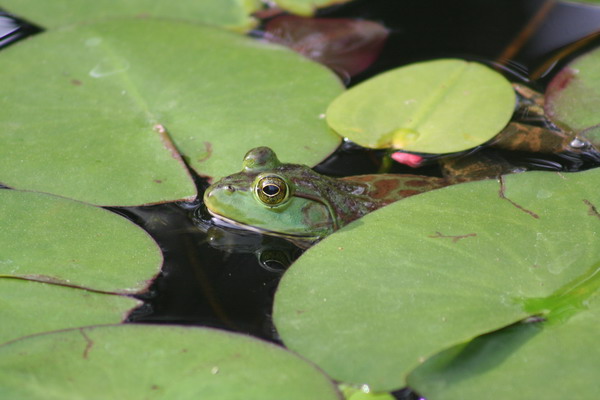
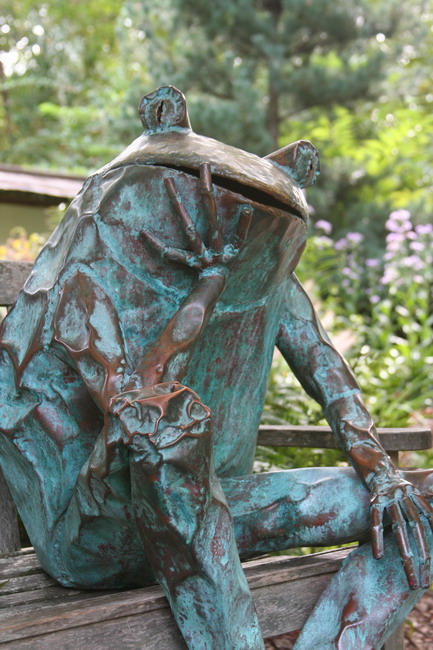
There were also many pretty flowers. Flowers are always fun because they are so photogenic.
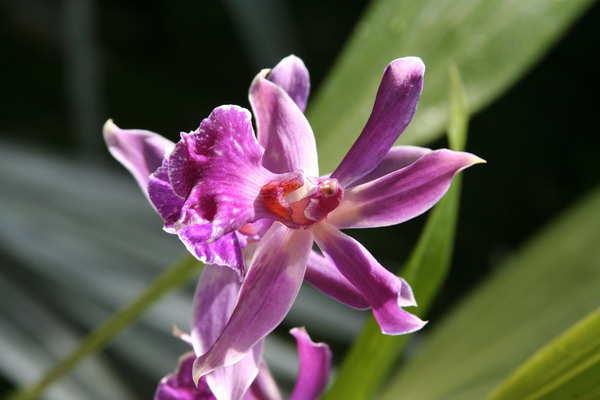
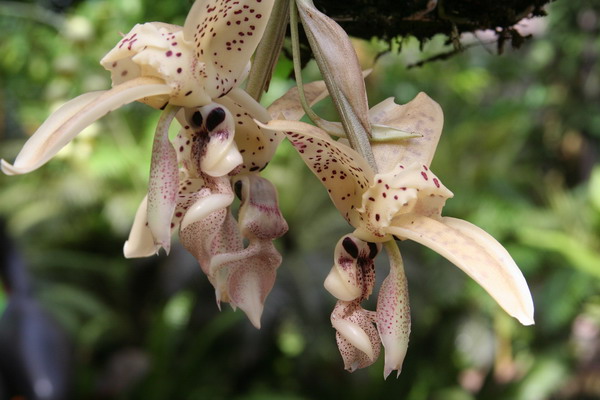
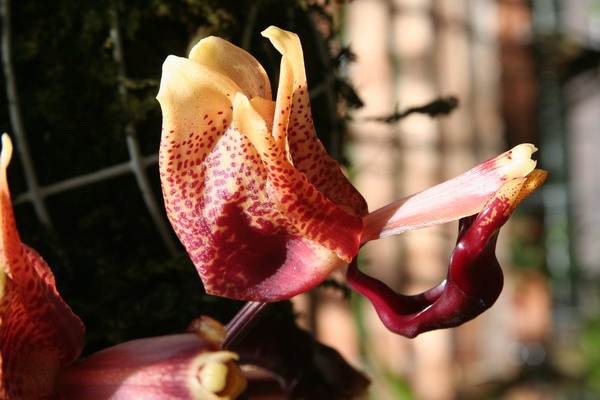
There were many exquisite violet flowers there as well… (my favorite was the one with golden strands at the top)
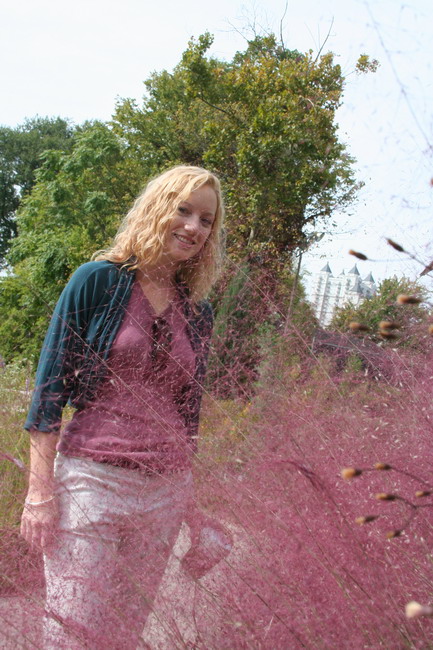
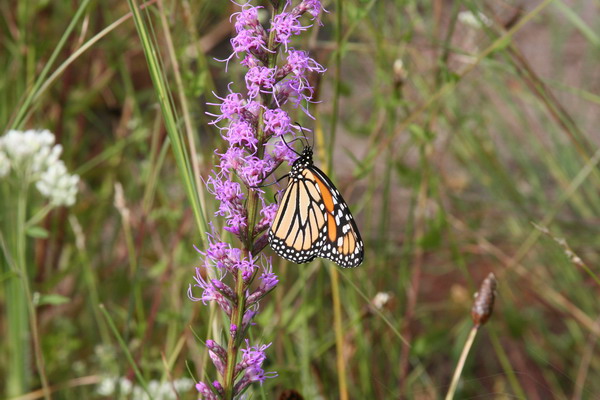
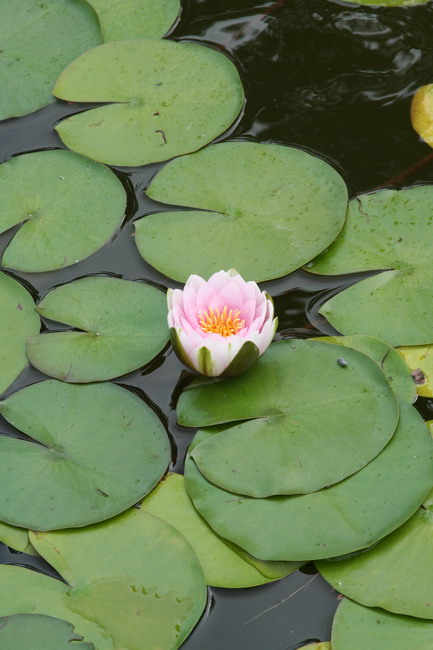
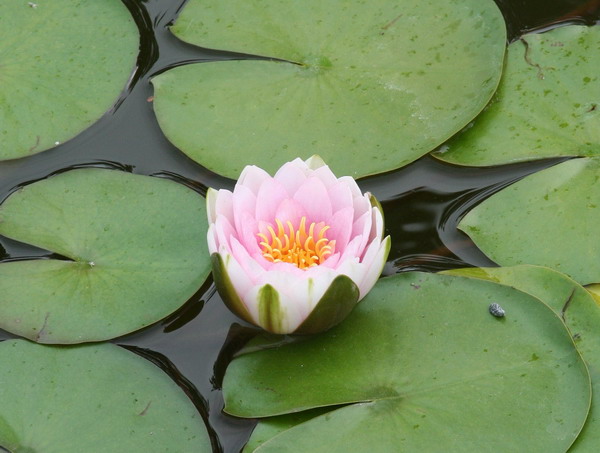
There were also these wild sculptures throughout the gardens. I thought this one was particularly interesting.
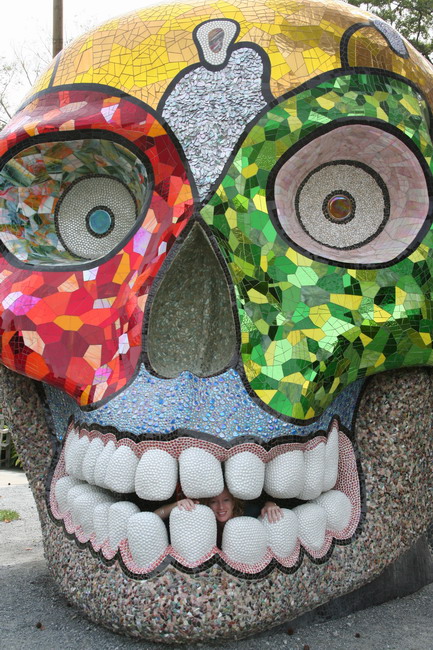
Here’s a self portrait inside the skull.
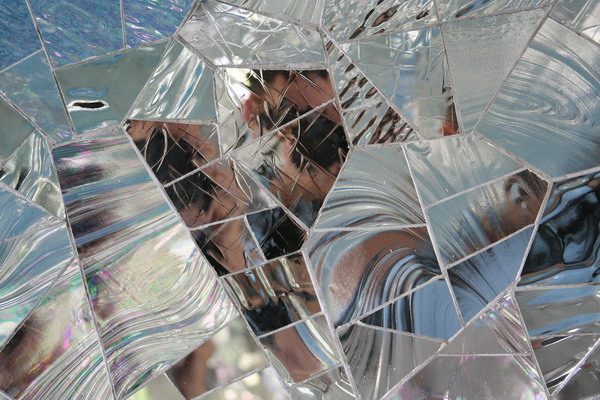
After the botanical gardens, we headed over to the natural history museum. These are sculptures from the Rome exhibit.

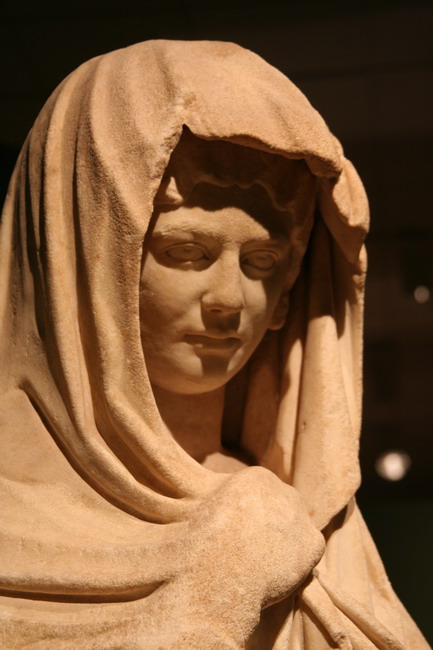
The next morning, we continued our cultural exploration of Atlanta. As we walked to the art museum, we ran into (or rather they rode by) a huge motorcycle caravan.
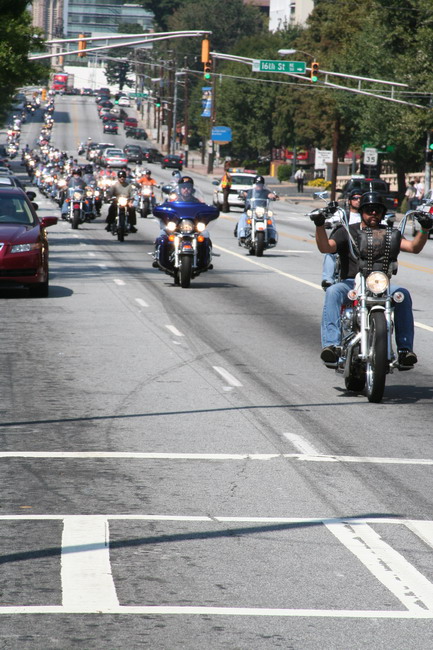
These are inside the museum. I like how art museums are often a work of art themselves. This one was no exception.
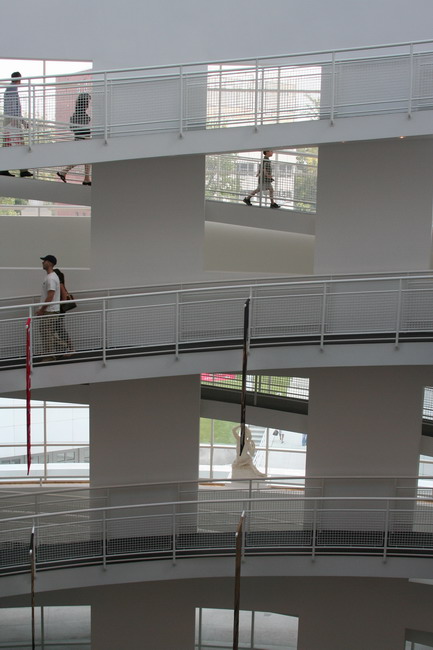
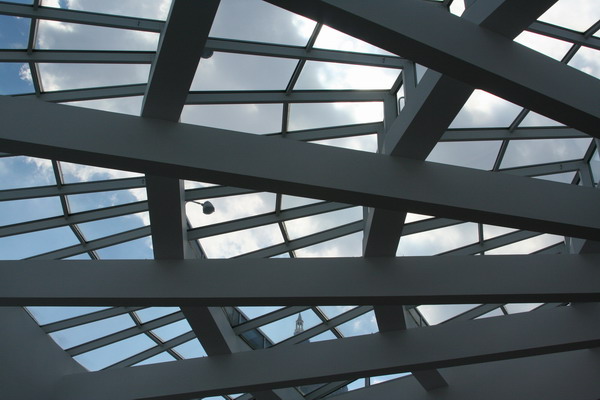
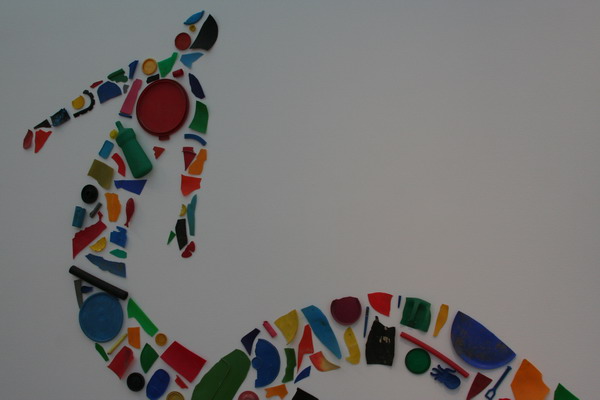
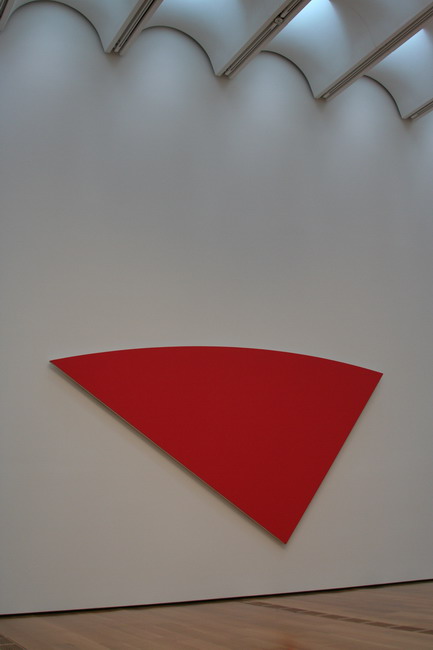
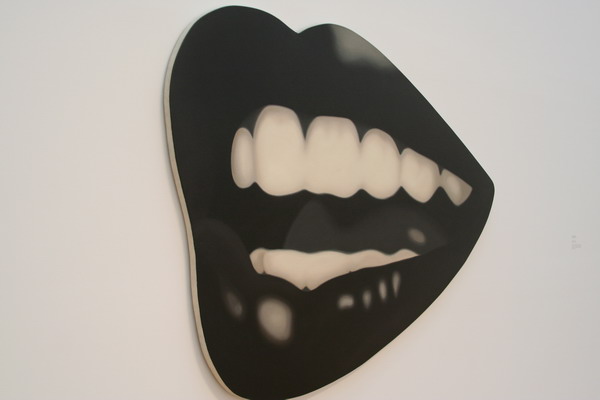
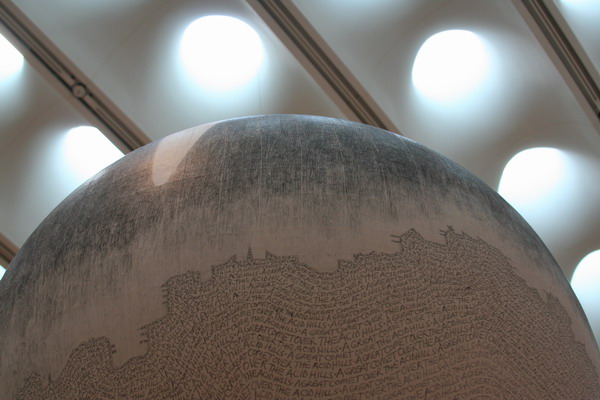
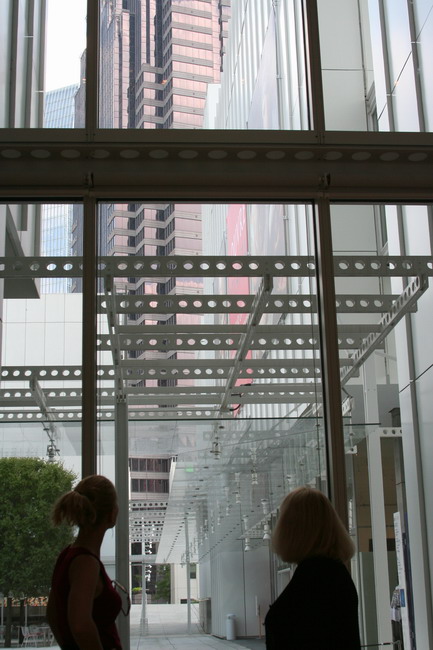
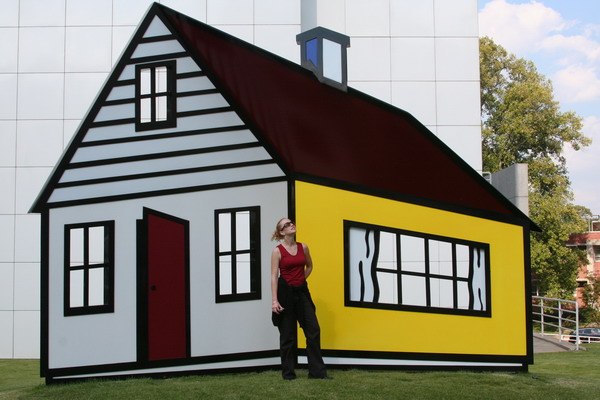
These two beautiful women accompanied me on the tour, and this is us headed back to the hotel to depart. It was another outstanding weekend.
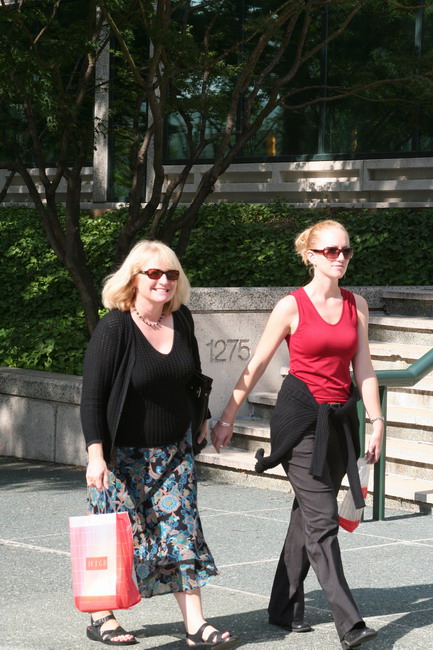
So, until the next adventure…
–Jim
Category: Trips
Nashville
Last weekend, my good friend Tom and I decided to take a little trip. The proposal was to go anywhere in driving distance from Montgomery. When he suggested Nashville, Tennessee, we decided that was a perfect destination.
Of course, it’s the epicenter of country music, so our first stop was a show at the Grand Ole Opry. I was really impressed by how the show runs. If you’ve never heard of the Opry, or are unfamiliar, here’s how it works: it’s broadcast as a radio show on 650 AM. The show is complete with announcer, performer, and even commercials. It’s kinda funny, actually, because it feels like the show hasn’t changed since they started it in 1925. The Opry actually encourages you to run down to the stage and take pictures. Unfortunately, I didn’t bring my camera with, but we still got to see/hear some performers like Trace Adkins and Bill Anderson.
Here’s the official logo of the Grand Ole Opry, just to give you a flavor. 🙂

After we had a very enjoyable dinner at Dave and Buster’s (one of my favorite restaurants that I hadn’t been to in a couple years), and watched the college football games on the numerous large screen TVs, we went out to find some local music. We ended up at a place in downtown Nashville.
The next morning, we woke up and headed over to the Country Music Hall of Fame.
Here are some of the images from our visit.
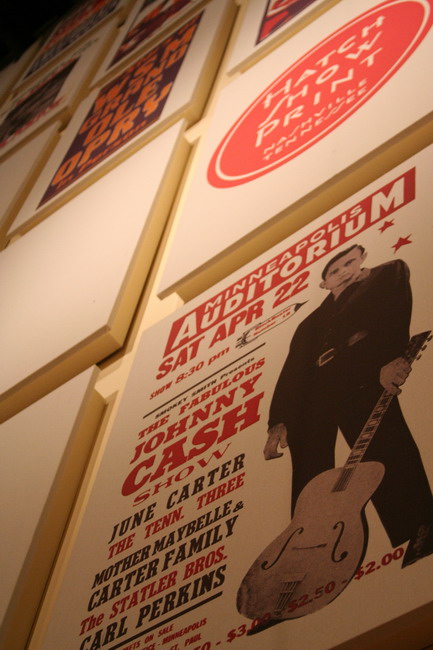
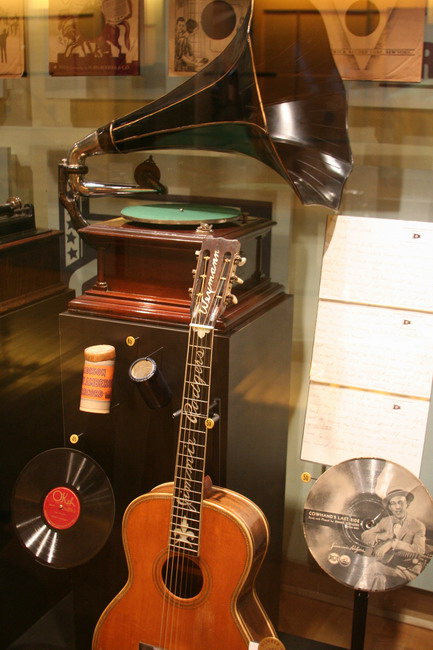
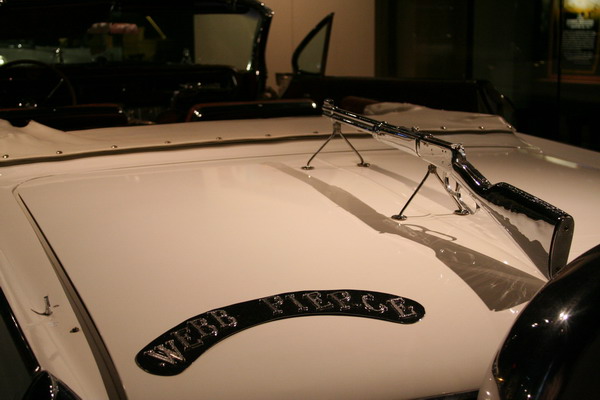
I had fun perusing all the gold and platinum albums.
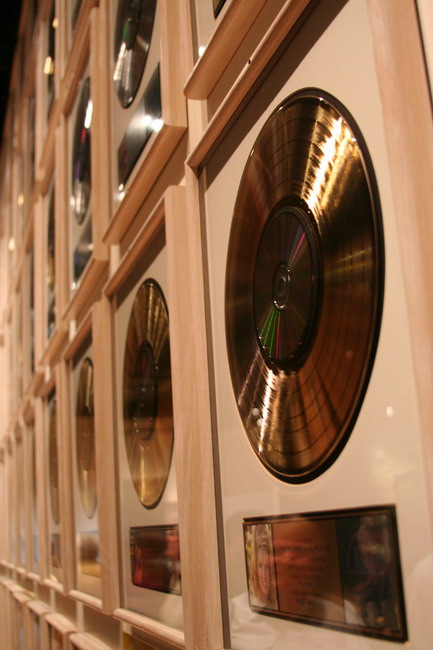
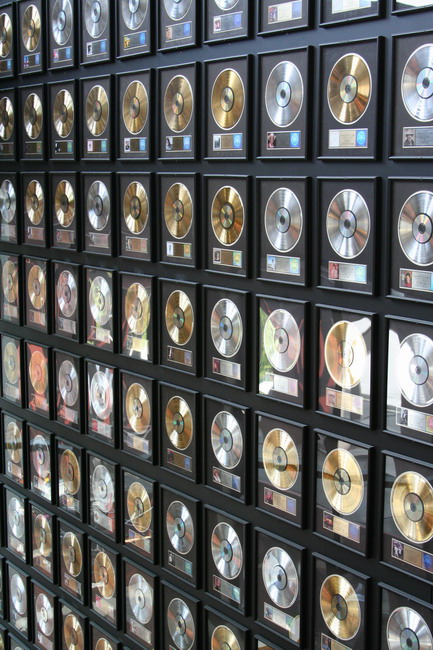
Inside this room, there were bronze plaques/busts of all the members of the Country Music Hall of Fame.
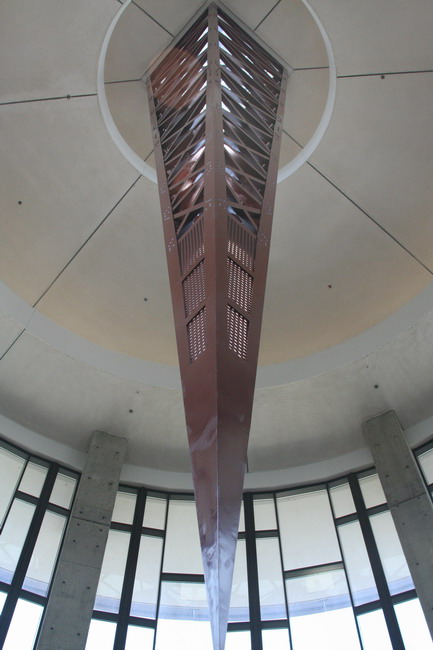
Here is Tom with a fellow Rhodes Scholar, Kris Kristofferson.
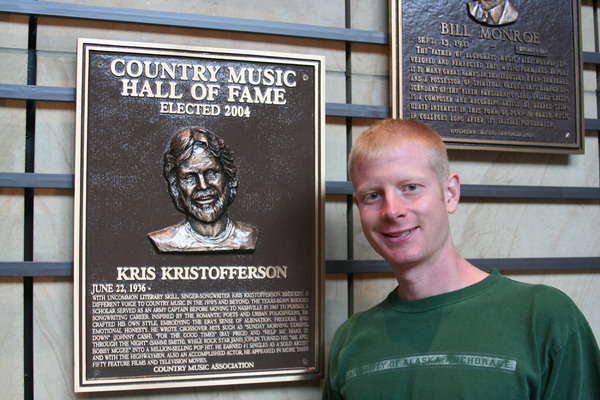
I decided to include this one because Tammy Wynette is indelible in my memory. Her timeless tune, “Stand By Your Man” woke me numerous mornings in northern Wisconsin as part of the yearly deer camp. Of course, there was also my father belting out his rendition. In my opinion, that was more memorable than the song itself. So, every time I hear that song, or see her name, it conjures images from cold, early mornings trudging out through the snow to sit in a tree for a solitary day peering intently into the woods…
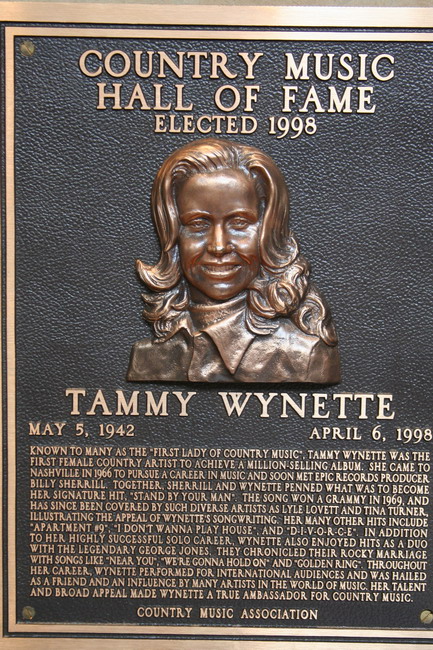
That completed our discovery trip to Nashville, but on the way home, just inside the Alabama border, we found this reminder from the past.
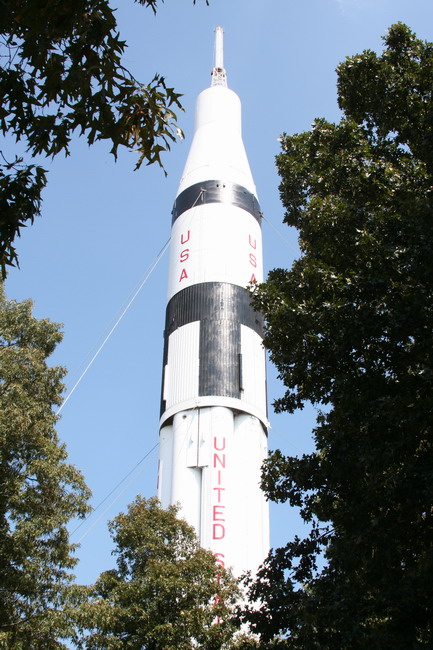
It was a great weekend. Tom and I hadn’t been able to spend much time together in the past couple years, so we had a lot to catch up on. Seeing a new, interesting city like Nashville was a great setting to do that.
So, until the next adventure.
–Jim
China Part 6 — Xi’an people and places
Our final day in Xi’an was a whirlwind trip all over the area. We stopped by hot springs, palaces, old hotels with historical significance, a muslim mosque, and lots of people everywhere.
First up was an old hotel located at a hot springs right outside of Xi’an. Inside there was a small museum that showed what the area looked like in ancient times, since the hot springs were a favorite retreat location for emperors.
Here’s what one of the royal families may have looked like.
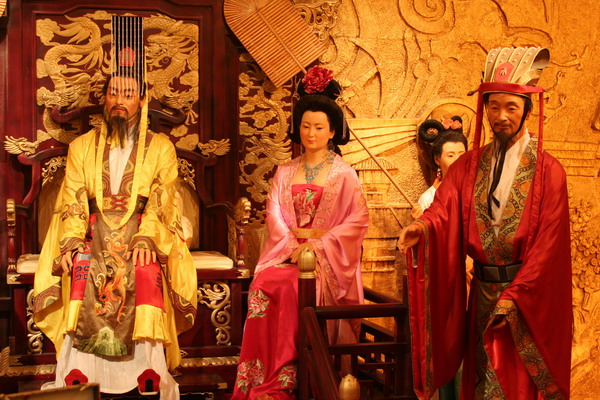
Every culture seems to have a legend of the most beautiful woman of the time. This sculture celebrates the most beautiful of all the women of the Tang Dynasty. She was a concubine of the emperor, and of exquisite beauty. In fact, all women in the Tang dynasty were unusual in that they enjoyed a very liberal and open-minded society during the normally very strict Chinese fuedal system.
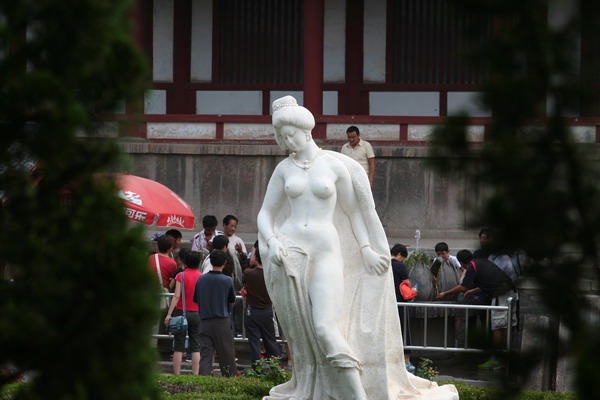
Now, in modern times, the hot springs served as an oasis for Chinese leader Chiang Kai-shek. As the Japanese invaded China in the 1930’s the battle between Chinese Communists and Nationalists also raged. However, recognizing the immediate threat of the Japanese, Mao Zedong (communist leader) wanted to band with the nationalist to counter the invaders, then decide the domestic division. However, Chiang Kai-shek was not convinced, and felt that the domestic dispute should be handled first. That brings us to the hot springs. Here, Chiang was taken hostage by Mao and the communists, who had the help of 2 of Chiang’s generals. However, Joseph Stalin felt it was not in the best interest of China, nor the region with the imminent Japanese threat, that Chiang be killed (as the communists wanted). So, perhaps through his influence, Chiang was kept alive and the two opposing sides were a United Front. This became known as the Xi’an Incident and is an important event in modern Chinese history.
Here’s a view inside one of the rooms. There are many bullet holes still pockmarking the area.
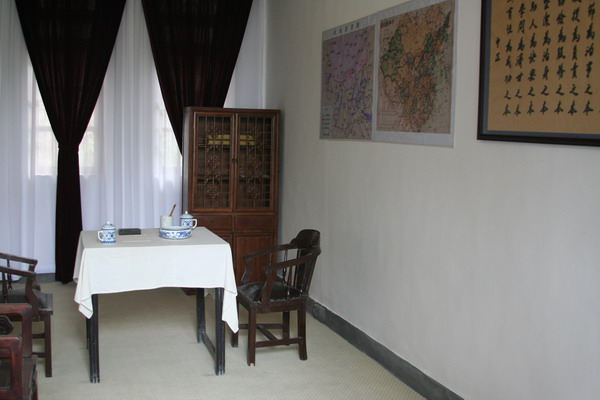
There was also this guy sitting around…
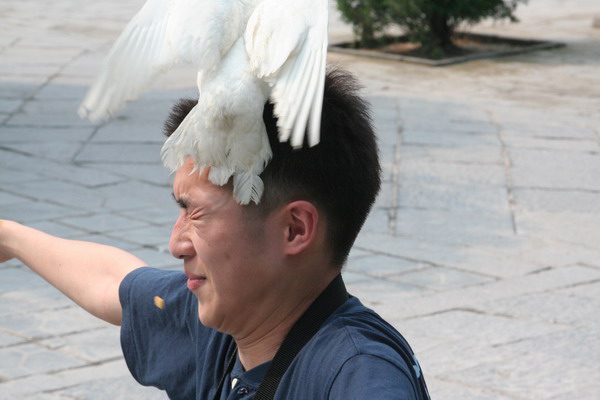
People there look like pretty much anyone else when they ride a bus…
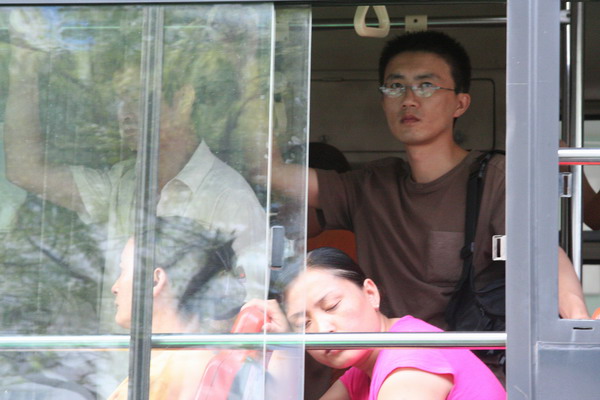
Some of the interesting tours we took were to a few local factories. While these places are mostly just tourist traps designed to suck you in and get you to buy over priced goods, it was still interesting to see the process. We visited jade, silk and Cloisonné.
Cloisonné is a uniquely Chinese art form that arose in the 13th century during the Yuan Dynasty involves shaping a piece of copper, then molding small pieces of filigree wire in intricate patterns. Finally, the spaces are filled in with enamel, baked in a kiln, sanded, and filled again, until the surface was brilliant color and smooth finish.
Jade is of course one of the minerals associated with China. We learned about the various ways it cut, polished, shaped into its final form and all about the different varieties and their relative value.
Finally, and the most interesting (because the process is much different than what we thought) was how silk is produced. Most significantly, it’s not a bunch of live silk worms producing silk at will to make this fabric (at least not exactly). It and after the fact process.
The silk worms create their cocoon to transform from larvae to moth with a single thread. Once it’s created by “domesticated” silkworms, the cocoon, with larvae still inside are boiled in water (to both loosen the construction and kill the larvae).
Sometimes, the cocoon contains 2 larvae and these twin cocoons produce a fine, but lower quality silk that is used for things like comforters. Here’s what they look like.
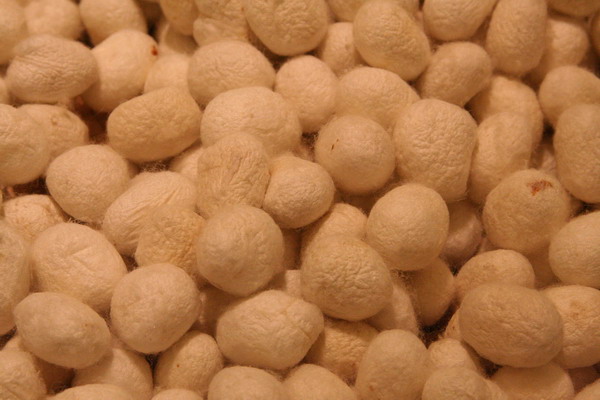
Don’t you think Anna should be a professional hand model?? 🙂
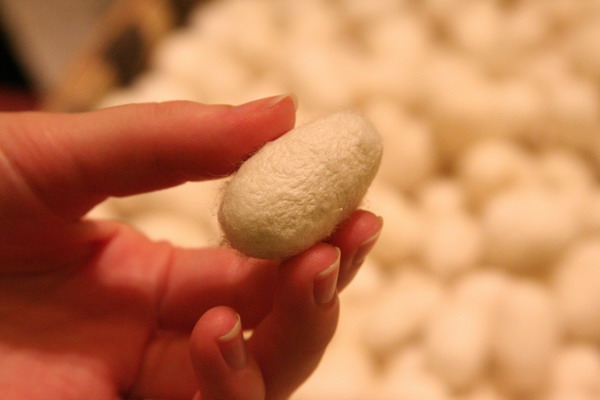
Here is one of the workers extracting the larvae (without breaking that single strand). Don’t worry though, the larvae is also eaten (it’s high in protein after all), so the whole process is very efficient.
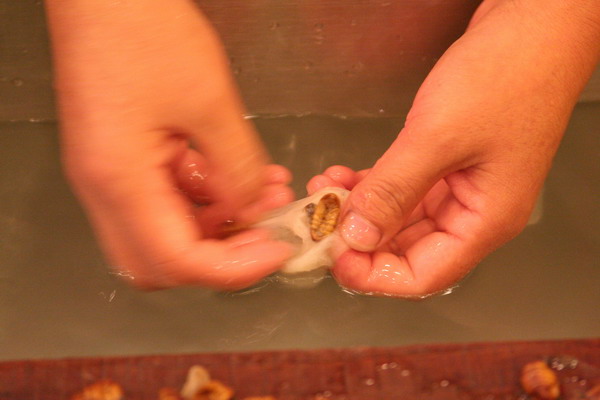
Once the material is washed and cleaned, it can be stretched very far, yet, the fiber remains very strong. You can see these women spreading out the material and a comforter can take up to 9,000 cocoons to make the large, thick ones.
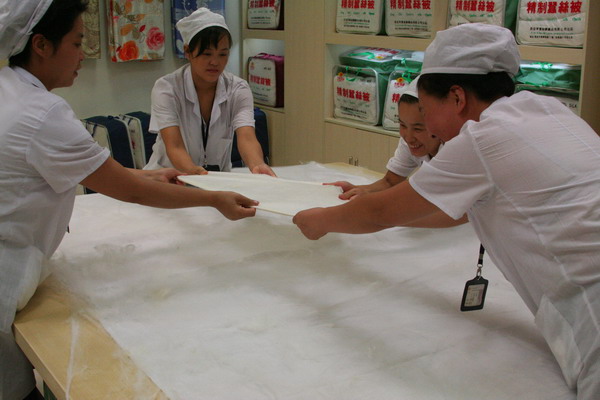
Back on the way into the city (note the city wall in the back ground), surprise, surprise, we found many bicyclists. It’s interesting to note that bicycles in China cost about $25 new and $5 used, so it’s certainly the most economical means of transportation (although the bikes may not be the “best” quality). Of course, with all the older vehicles and factories spewing tons of noxious gases, the air quality in both cities was VERY poor as smog was ever present.
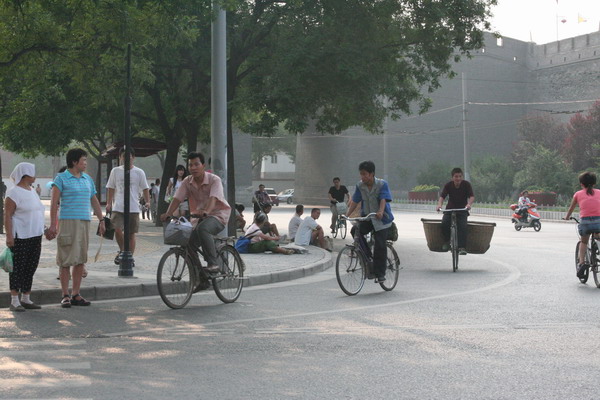
In keeping with our religious smorgasbord, we visited a muslim mosque. To get there, we wound our way through the Muslim market. It was a fascinating place and since it was only a 5 minute walk from our hotel, we decided to come back after dinner.
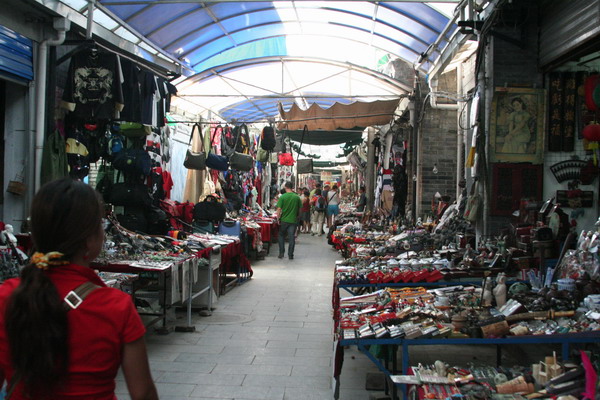
This is the inside of the mosque courtyards. Although, the actual sanctuary is only for muslims, the grounds were very pretty.
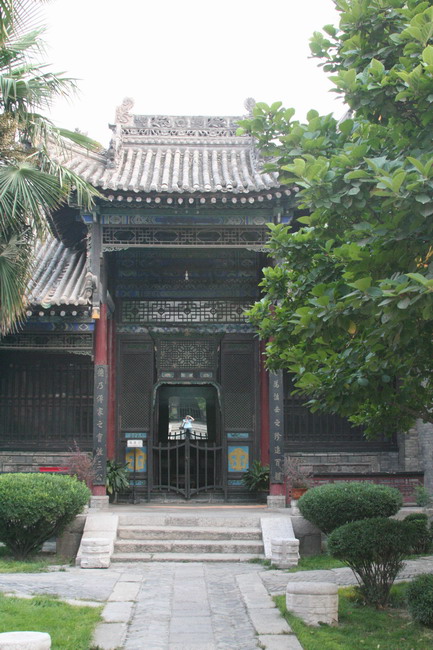
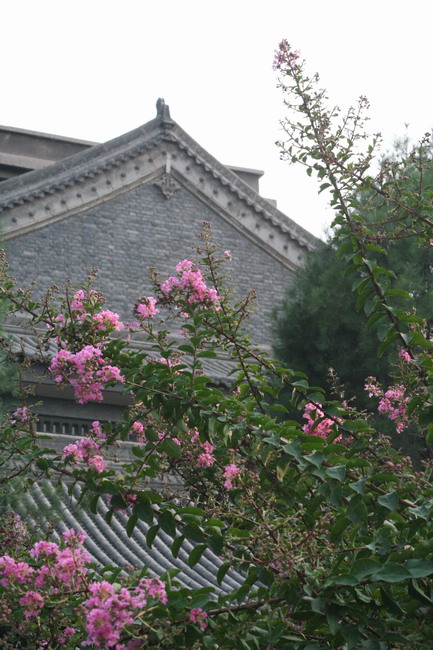
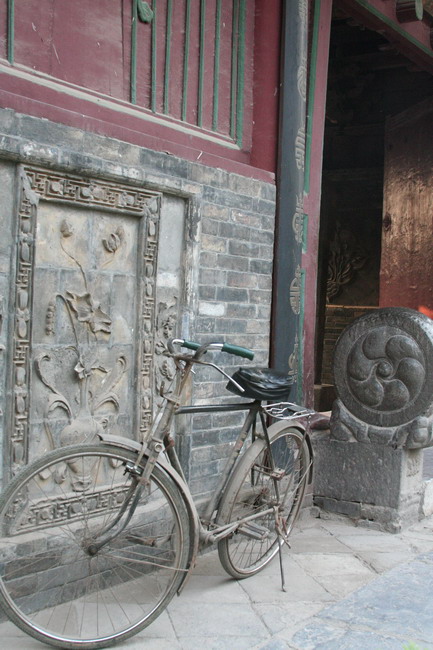
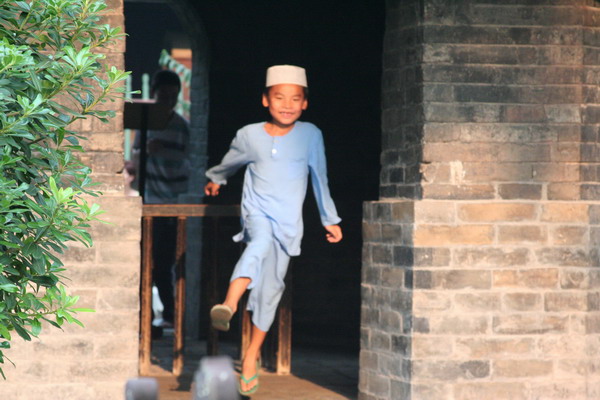
Back in the market, we found lots more very photogenic people. 🙂
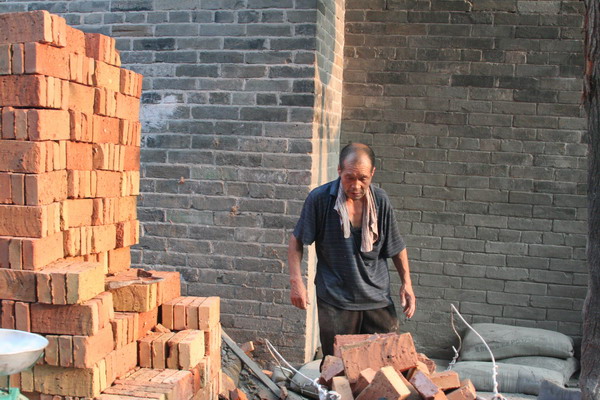
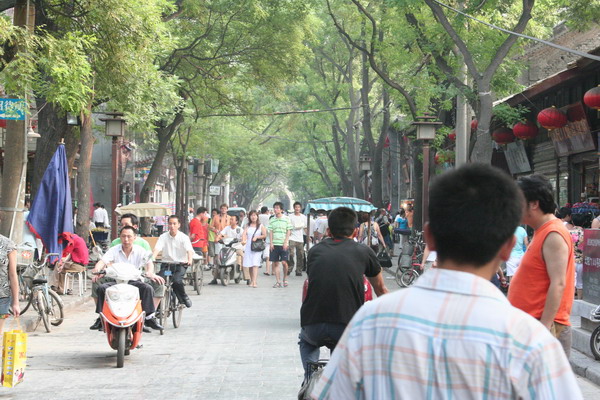
Dinner was being prepared all over the city…
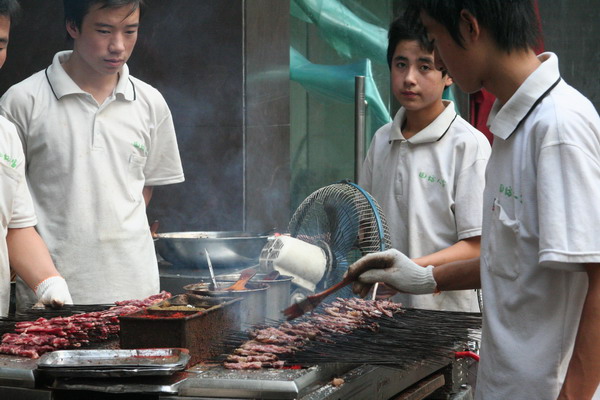
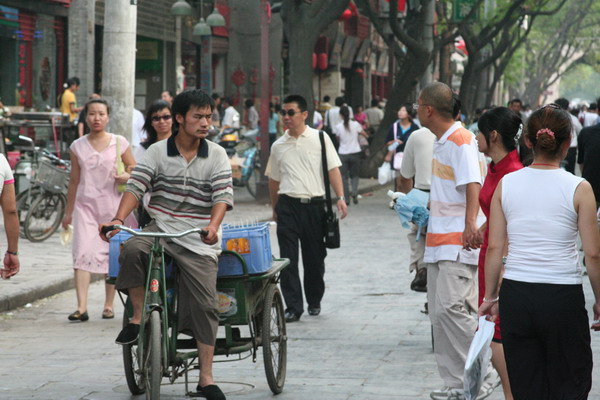
We found many people who were very active in their pursuit of recyclable goods (like plastic and aluminum bottles) by actively seeking people’s empty containers. Here is one man doing just that, except it’s in the waste already discarded.
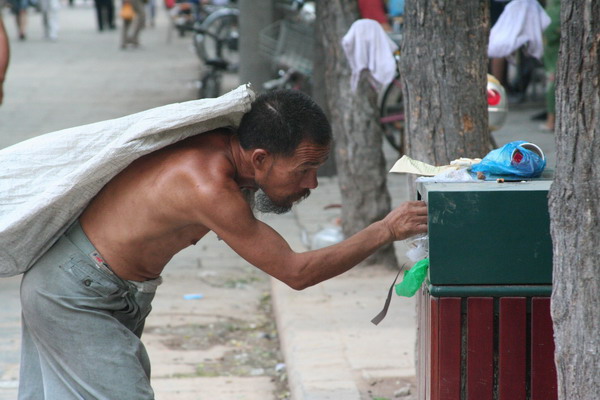
Of course, sanitation wasn’t nearly as important there…
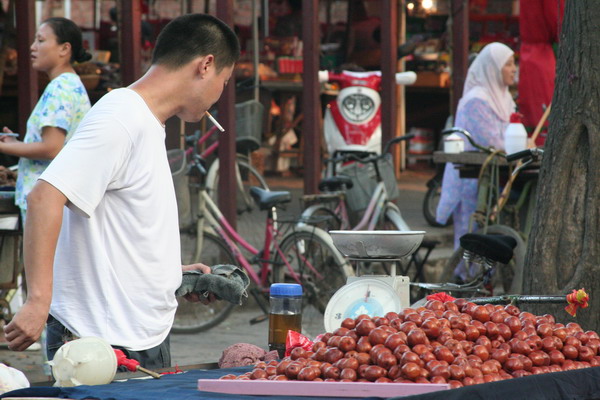
This is the view from just outside our hotel. It’s of the Bell Tower, which is partnered down the road with its twin, the Drum Tower.
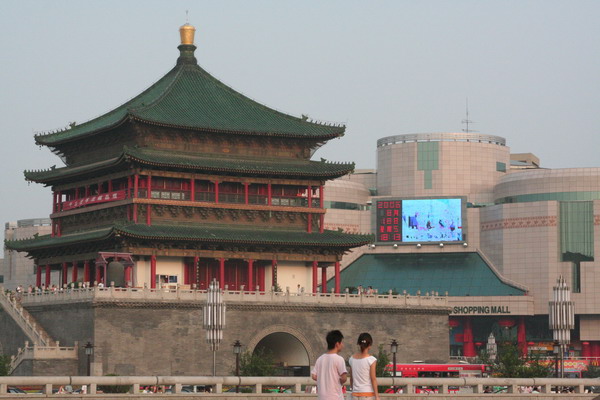
While we had a feast of dumplings, I thought these fish tanks were a unique feature of the restaurant.
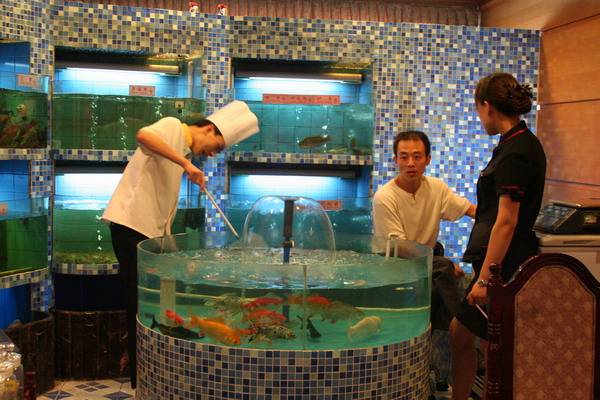
After our last dinner, Anna went for a foot massage, and I headed back to the market to capture some of the beautiful images I saw earlier.
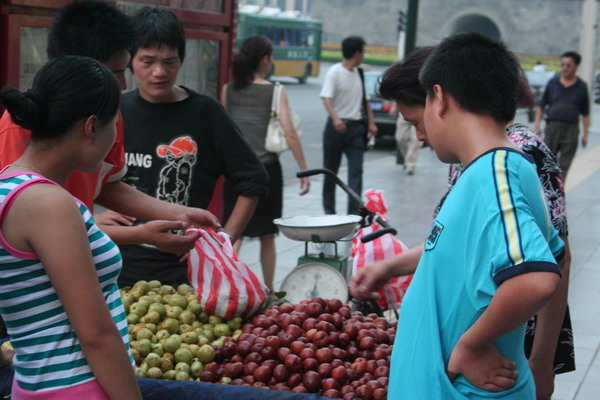
Every market we went to was an explosion of sight, sound and smell.
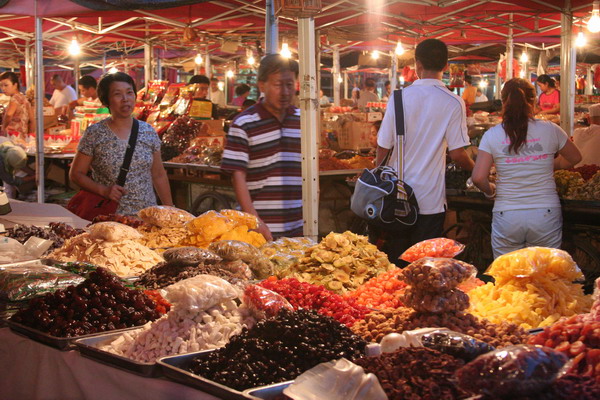
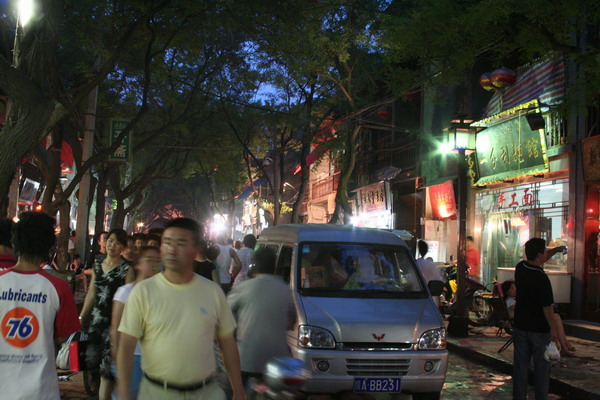

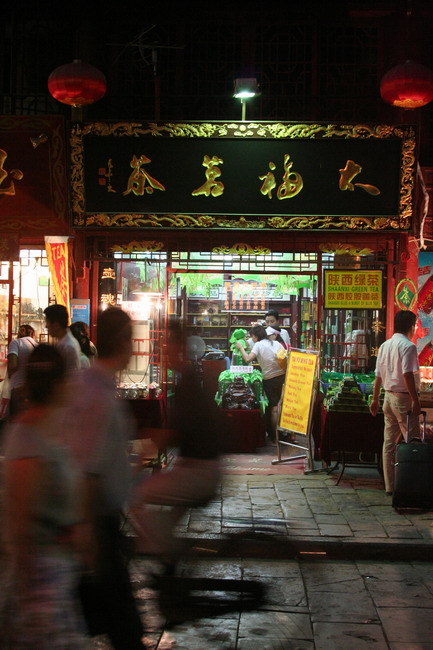
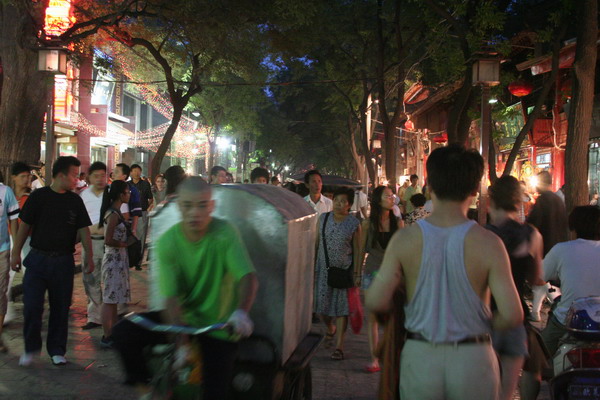
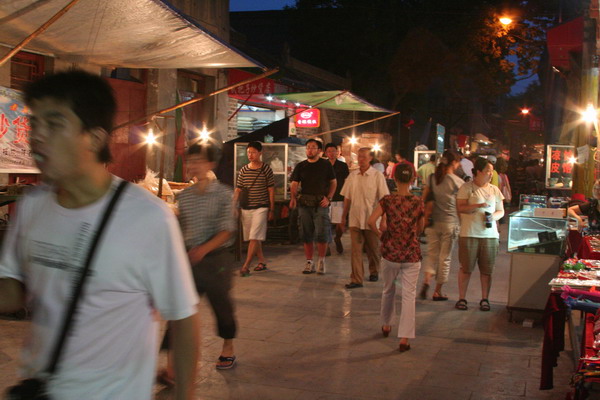
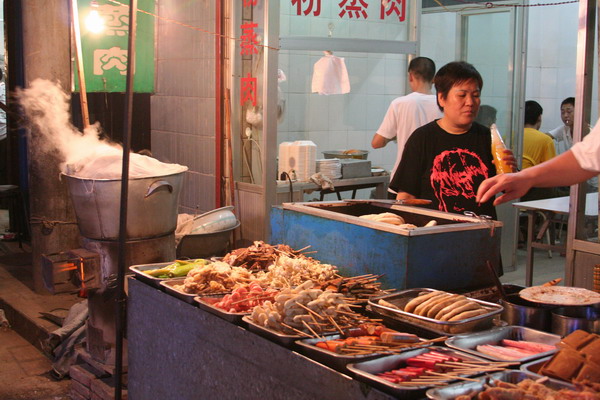
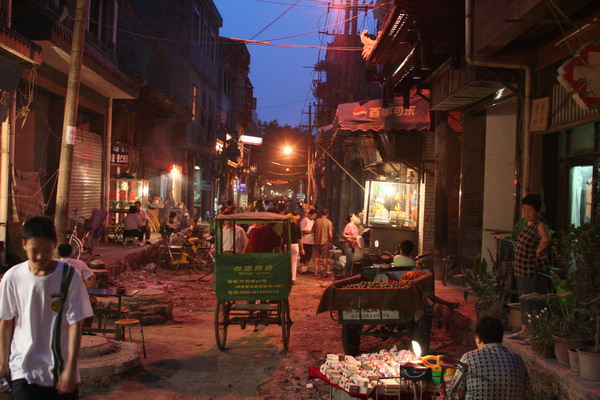
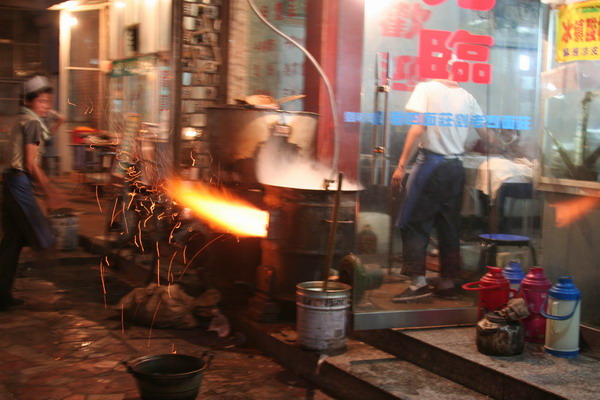
As we made our way back to the hotel, we found the Bell Tower ablaze in lights.
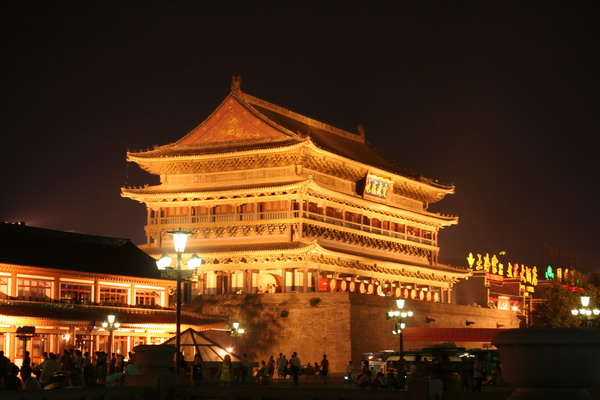
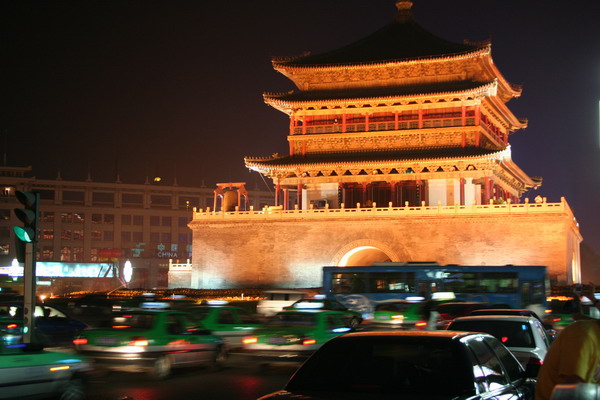
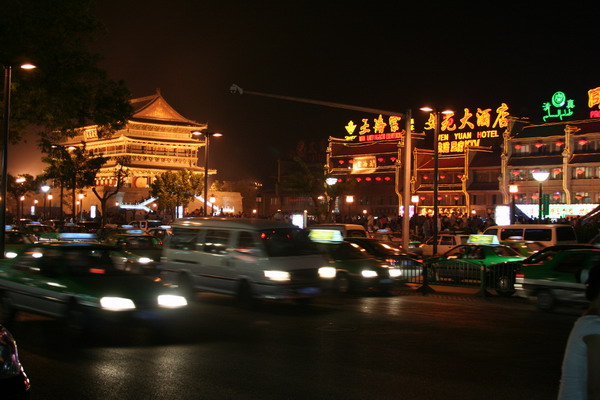
The next morning, we got up and started the long journey back to our home. All in all, it was another spectacular journey in the pursuit of adventure, history, and cultural understanding.
We found the people to be very kind and welcoming. The food to be typically very tasty. Goods were inexpensive. The history of the region surrounded us at every turn. It was a journey we’d recommend to anyone. Like any of our adventures, if you have any more questions about it, please don’t hesitate to ask (leave a comment or write us an email at JimAnna02@yahoo.com).
So, until the next adventure.
–Jim
China Part 5 — Terra Cotta Warriors
We had the opportunity to visit the 2,000 year old Army of Terra Cotta Warriors. This experience was right up there with our visit to the Great Wall.
If you are unfamiliar with what I am talking about, the Chinese Emperor Qin Shi Huang. He was the emperor who first united China in 221 B.C. (also started building the Great Wall). This army was to protect him in the afterlife. His mausoleum is also believed to contain and entire palace (complete with halls and offices, as well as the warriors). We don’t know, however, as a large portion of the site has yet to be excavated. We do know that there are at least 6,000 life size soldiers (all 5’11” – 6’1″) in full battle formation including weapons and true to life poses. Most significantly, while there are only a handful of different figures (infantry, archers, officers and generals), each one has a unique face.
The site was only discovered in the spring of 1974 by a local farmer digging a well. He happened upon one of the remnants of the warriors. As it turned out, his discovery was right on the edge of the massive field of warriors. Now, that fortunate farmer can be found just about every day at the site to sign autographs and accepts donations (as you can imagine, he was compensated by the communist government). However, surprisingly, he doesn’t allow anyone to take his picture.
Now, on to the site…
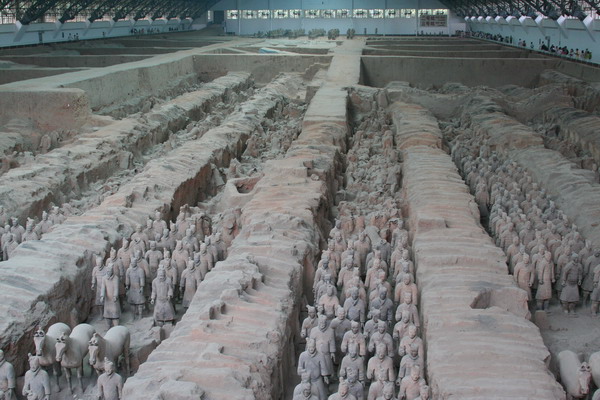
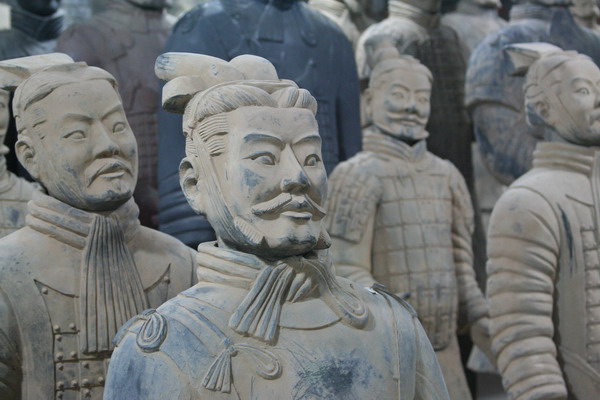
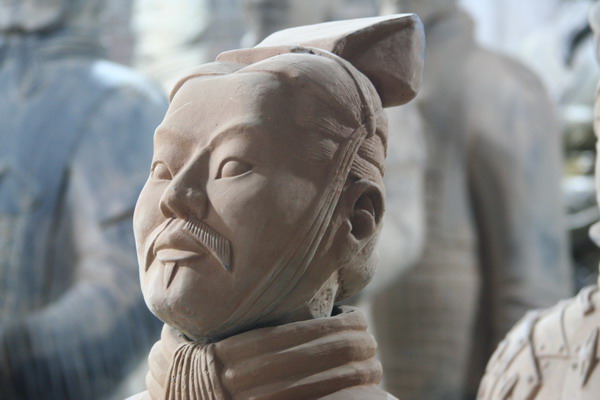
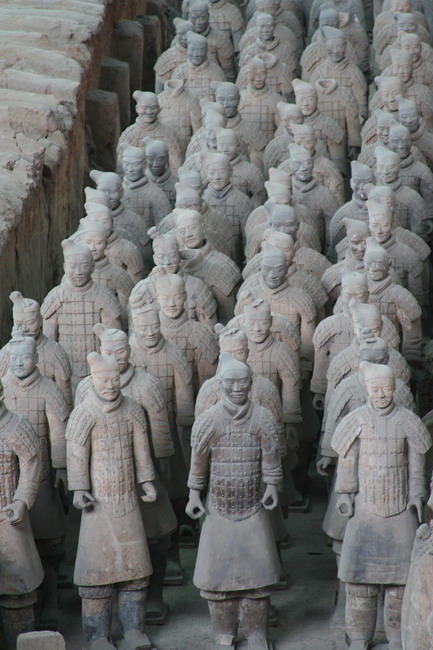

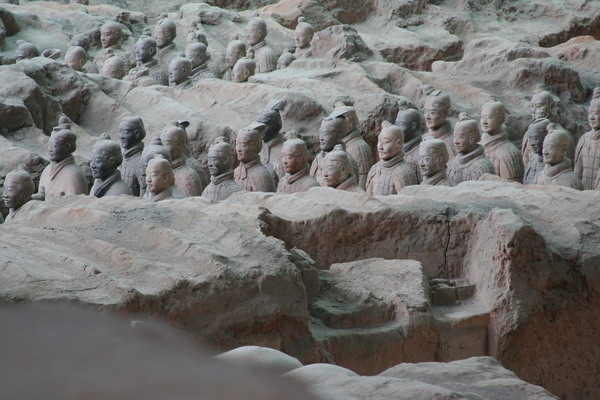
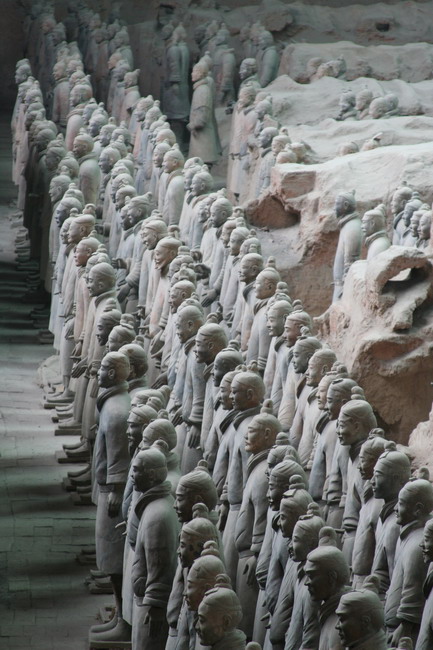
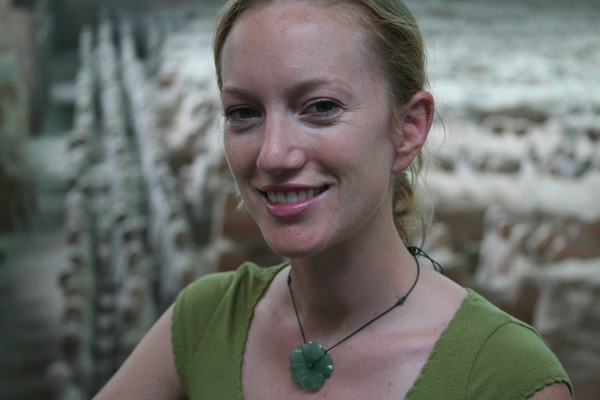
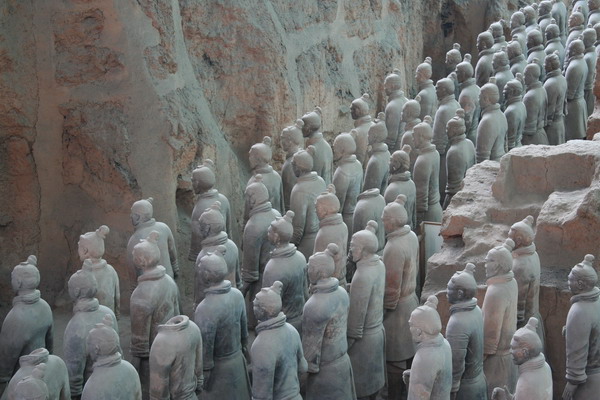
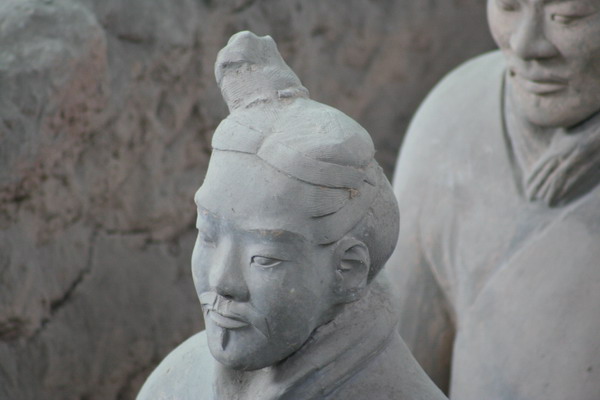
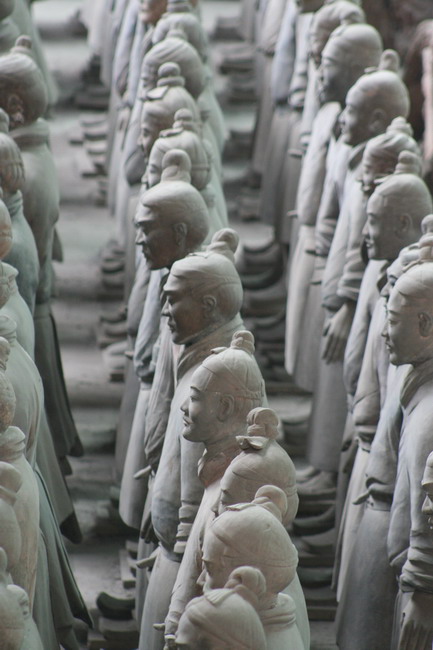
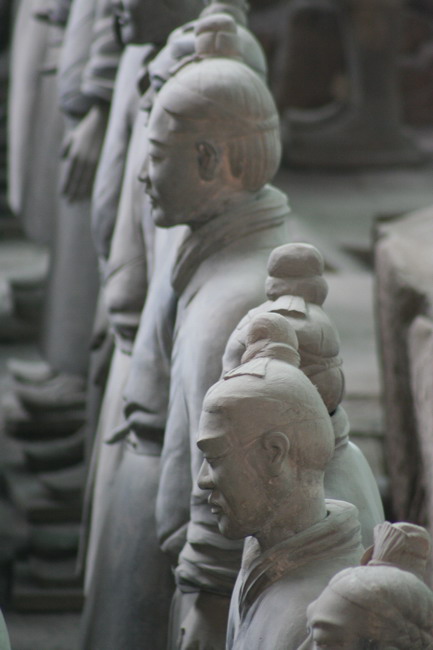
You can see that not all of the warriors were perfectly perserved. Some were destroyed by marauding looters who wished to undo the work of the emperor, and others were from more natural causes.
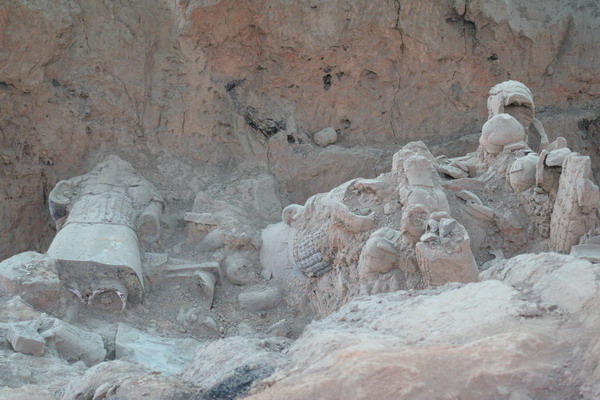
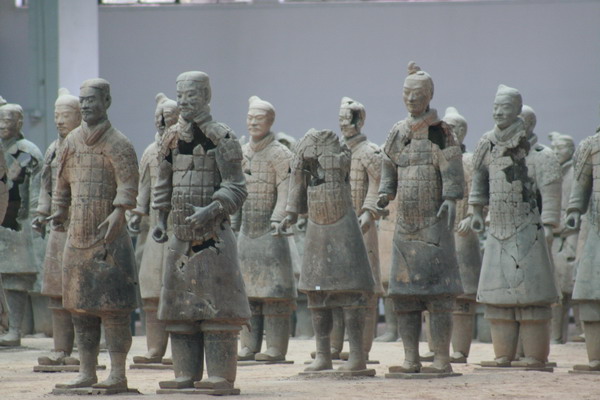
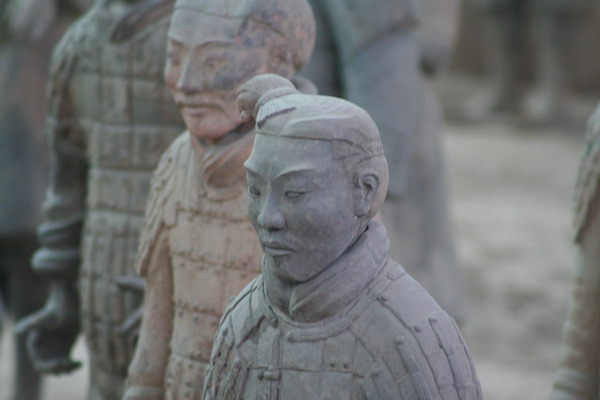
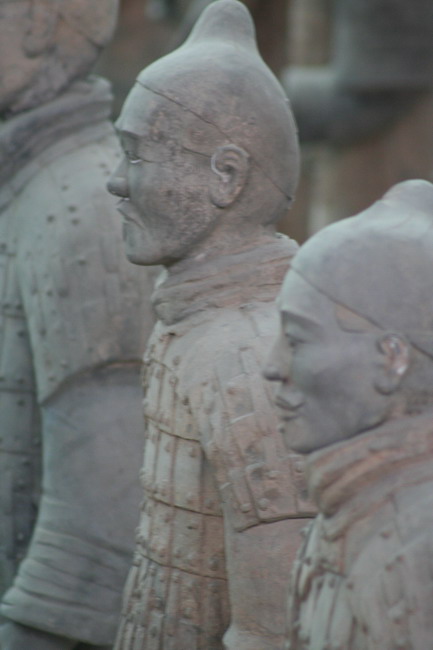

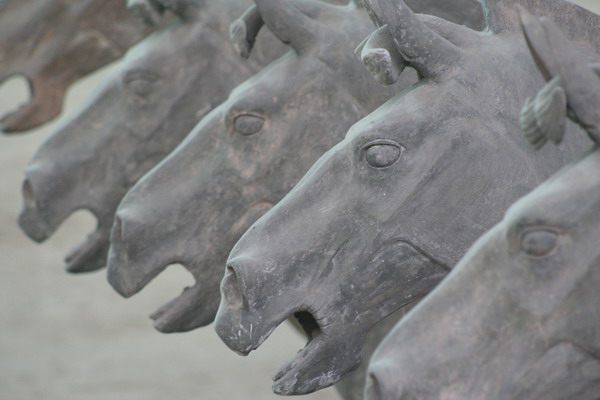
There are three pits that contain the warriors. The first is the largest and most spectacular. After we finished wandering around the first pit, we took a break for lunch. There we had a tasty lunch, that included hand made noodles by these cooks.
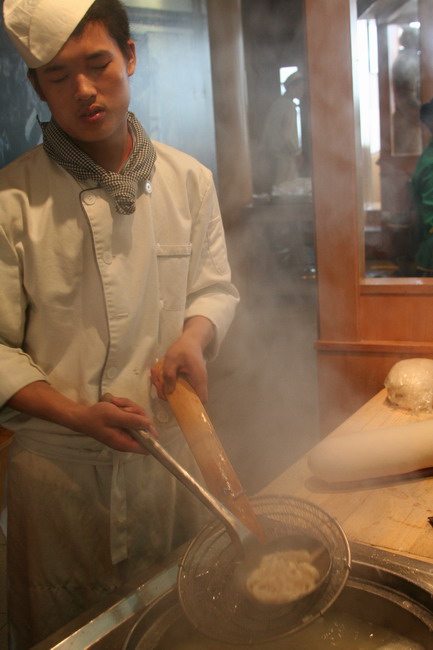
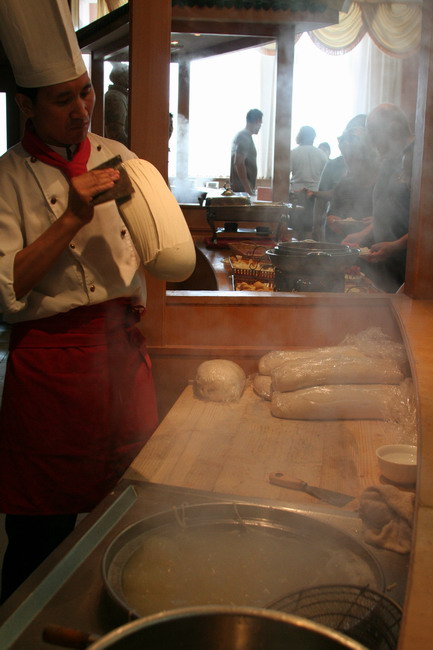
Also on the grounds there is a small museum that contains a well preserved example of each type of warrior.
This is the kneeling archer.
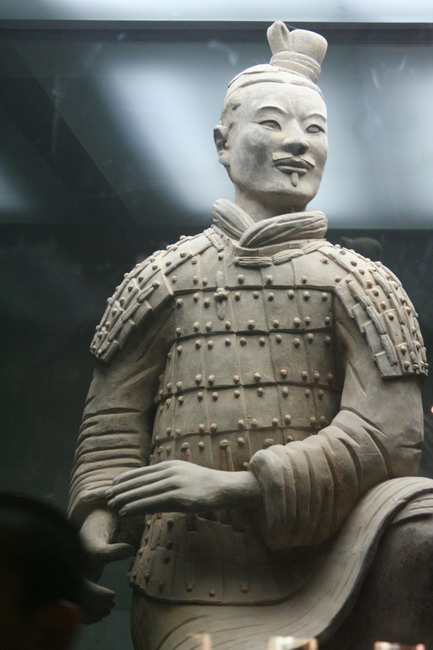
An officer.
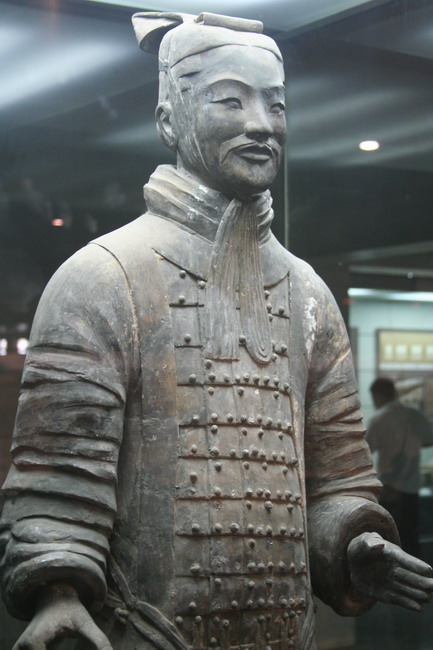
A general.
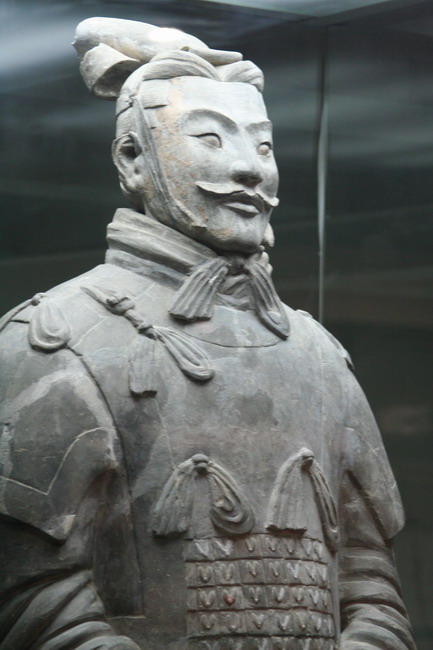
A cavalryman.
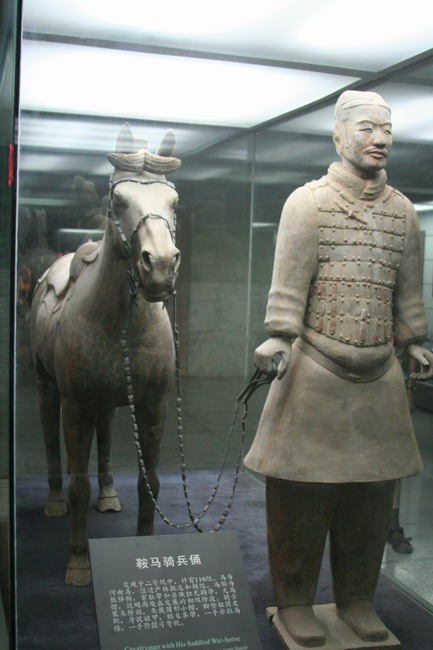
A standing archer.
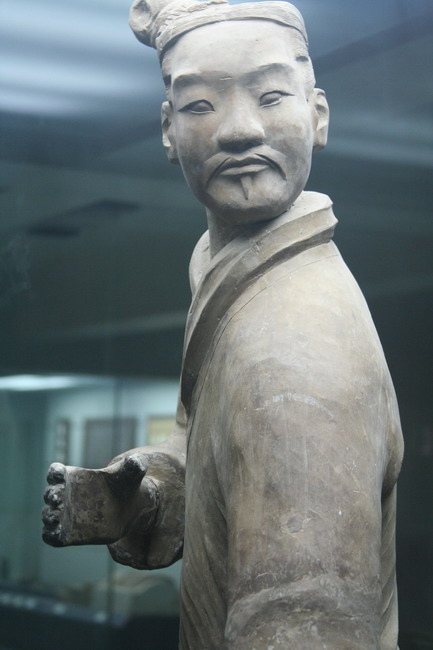
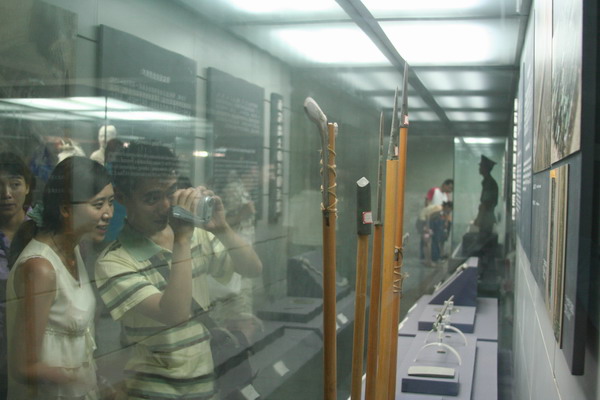
As you can imagine, there were lots of tour groups. This is one common way to identify everyone in your group…
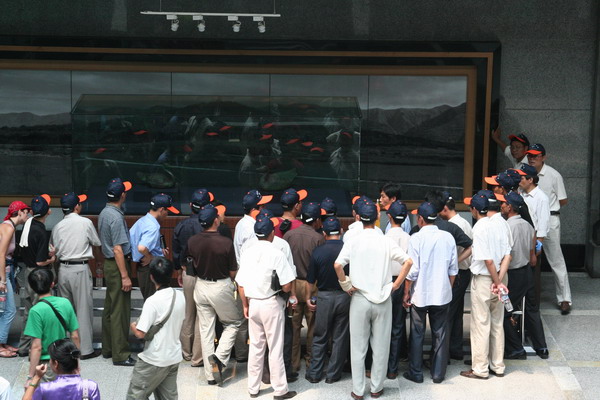
We also visited a factory that makes modern versions of the statues. While the originals were painted in vibrant colors, the replicas are made to look like they were when the warriors were unearthed (although some still had paint when first excavated, the paint quickly disappeared). The bonus was that we were able to see the process and get up close and personal with the statues.
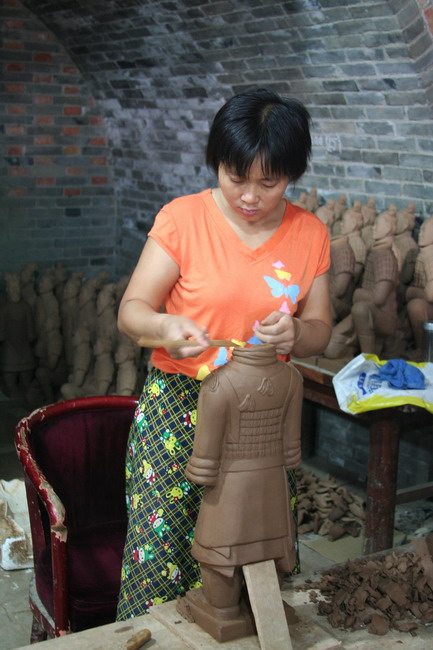
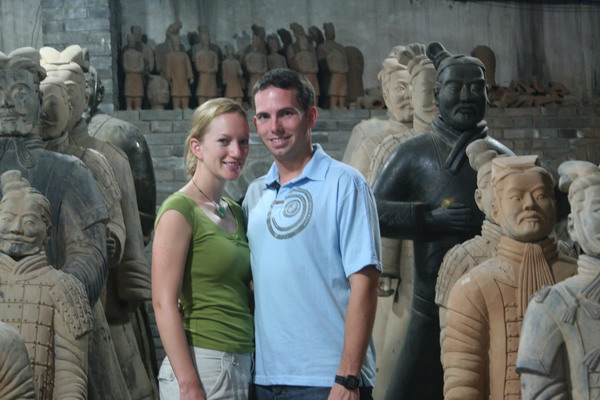
Wow, what an amazing site and that fact that they were recently discovered, with possibly a vast trove still to be unearthed, made this visit even more memorable.
The last entry will look at more life in Xi’an and a little about the silk making industry in China.
–Jim
China Part 4 — Xi’an and World Park
We had mixed emotions about our last day in Beijing. Our main stop on the itinerary was to a place called World Park. It’s a park filled with replicas of the world’s monunments at one tenth size. While it was somewhat interesting, we mostly got the feeling that it was a very touristy with not the best construction.
However, there was a crocodile and elephant show done by some Thai nationals. The show was entertaining, but we heard that if zoos are like prisons for animals, then the zoos in Beijing were like death row. So, suffice it to say, that as fun as the show was, we came away feeling sorry for these poor creatures.
That said, here are the images from the show.
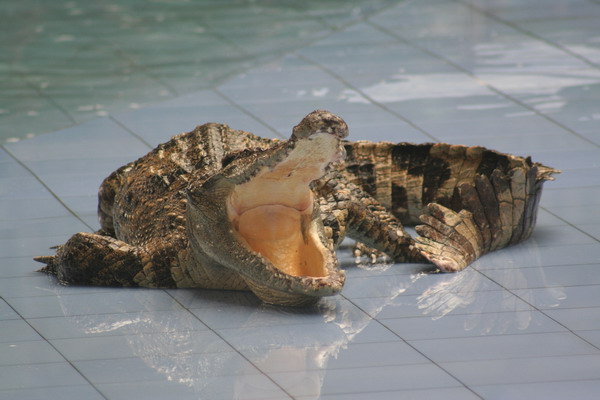
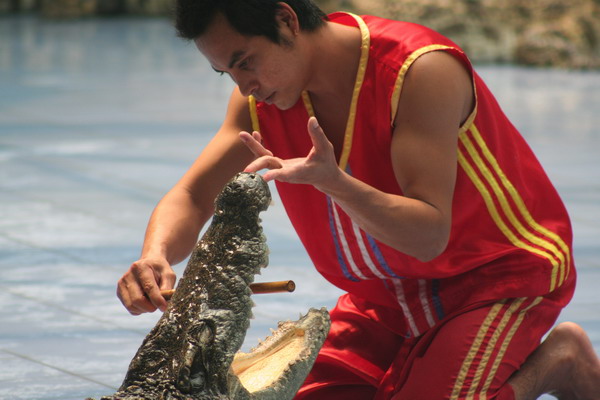
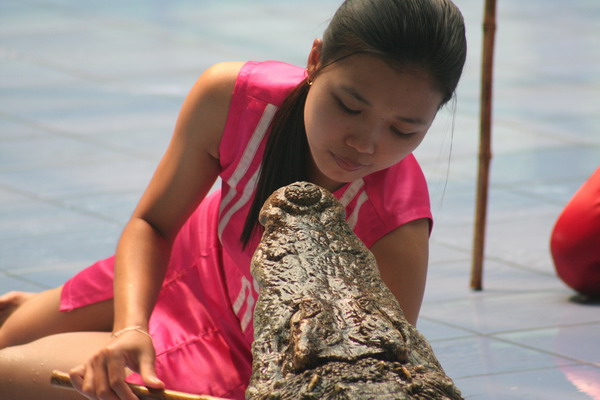
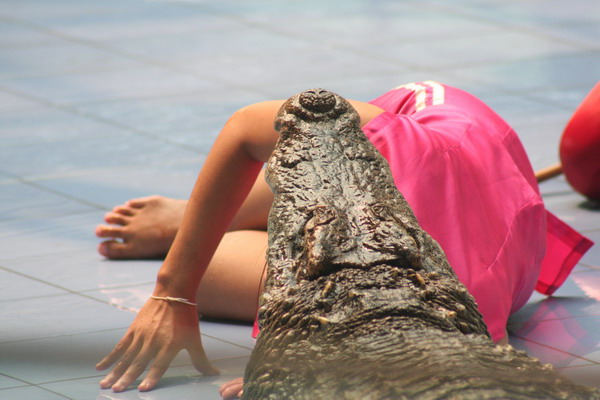
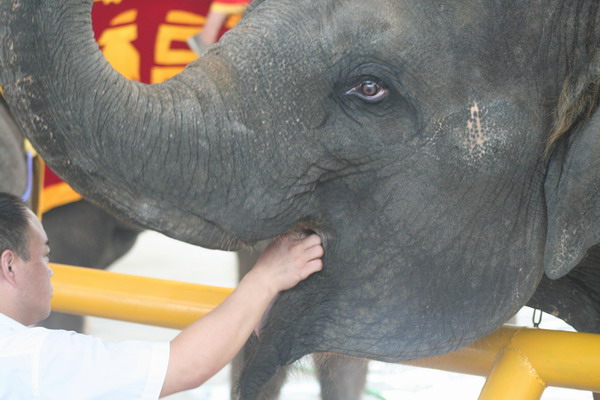

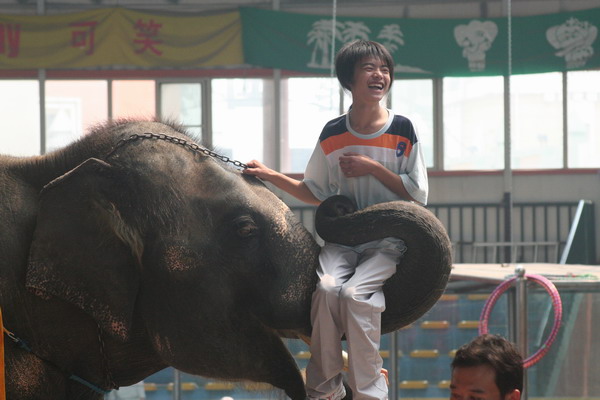
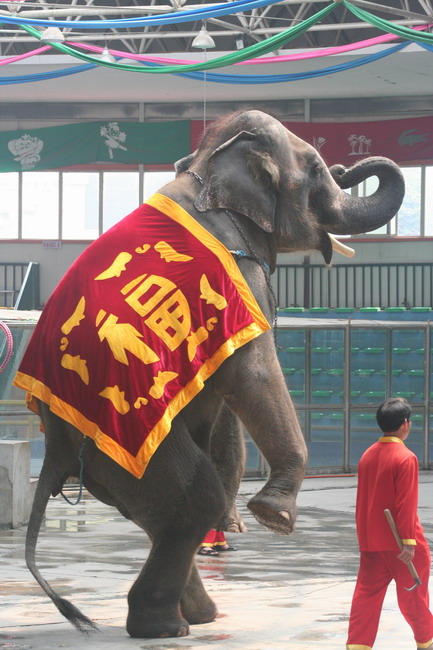
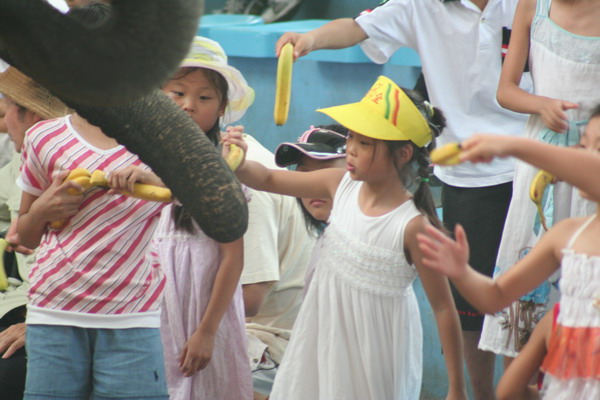

Then, back to downtown Beijing to visit on last temple.
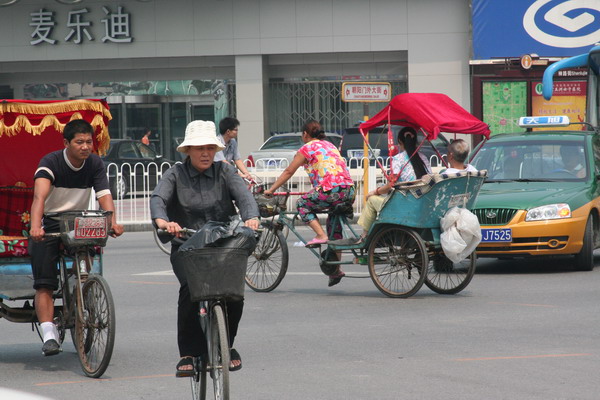
This time we went to Lama Temple. Lama, as you may be aware, is the term for a Tibetan religous (Buddhist) teacher (similar to a Guru). So, there were many young monks around and this temple was probably the most vibrant of all the ones we visited (even if the pictures don’t really show it…).
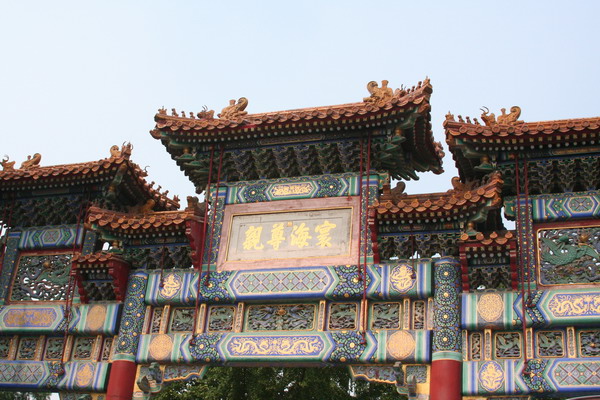
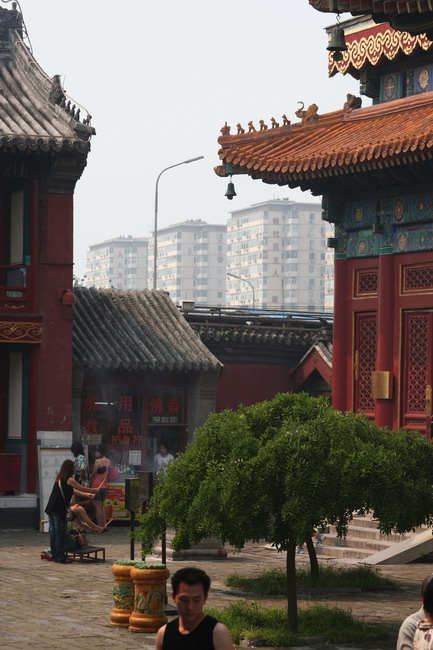
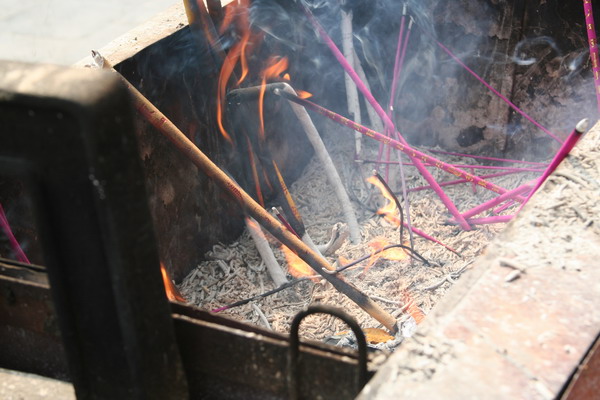
Here is our guide, Woo, again.

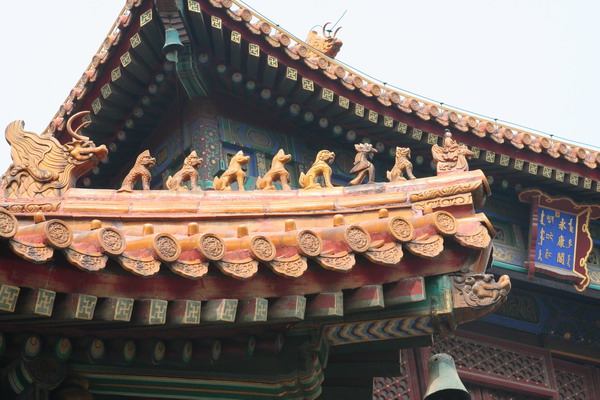
A couple more images of city life in Beijing.
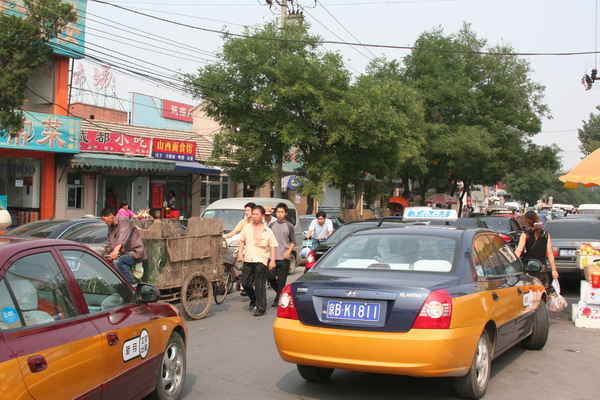
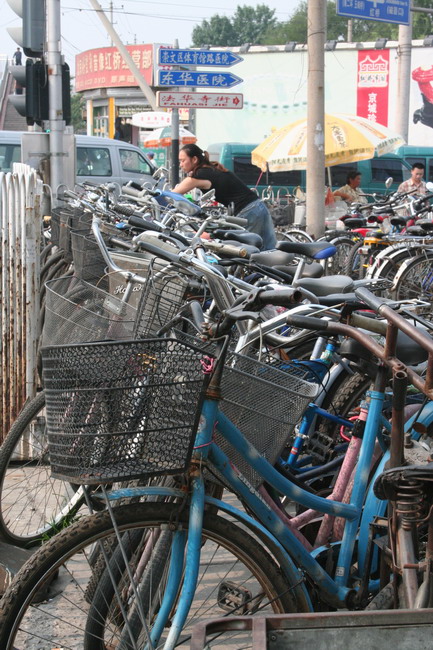
After our time in Beijing, we boarded a flight down to Xi’an. While Beijing is a massive megapolis at 16 million people and feels like an enormous city, Xi’an, is also a large city by all rights with over 6 million inhabitants. In fact, in all our travels in China, we felt that there were lots of people everywhere. Perhaps even more so than Japan. Of course with 1.3 billion people spread out over a vast country, it brings the People’s Republic of China down to the 71st most densely populated countries (Monaco is the #1, if you’re curious, while Macau and Hong Kong are #2 and #3 on the list, and the USA is #172 and Greenland brings up the rear at #230).
Xi’an, was the ancient capital of China, and was the first city in the world to reach 1 million inhabitants (although there is some dispute to that claim). Also, and more notably, it was the eastern end of the Silk Road, when the city was known as Chang’an.
The first stop when we got to Xi’an was to visit the Big Goose Pagoda and the Tang Dynasty Arts Museum.
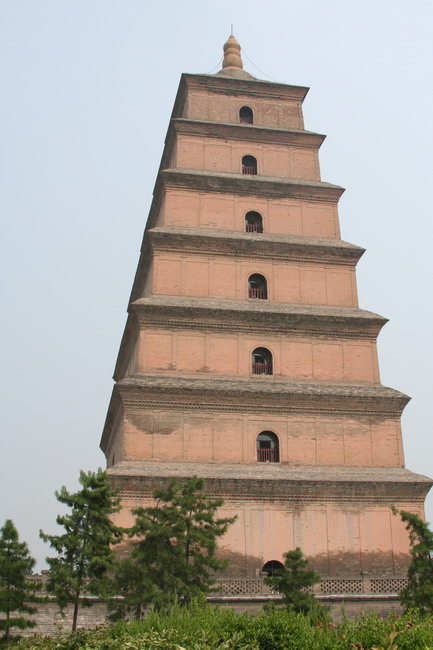
There were many interesting people also visiting the Pagoda.
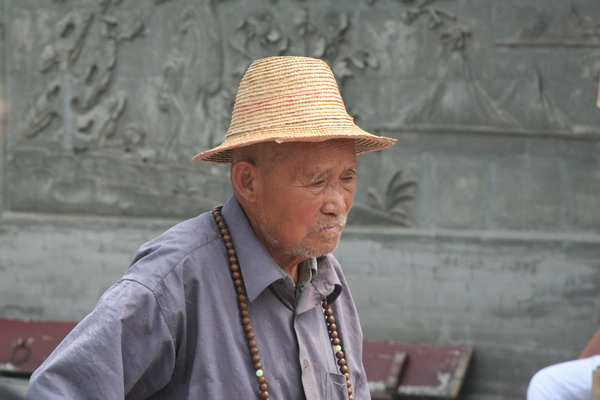
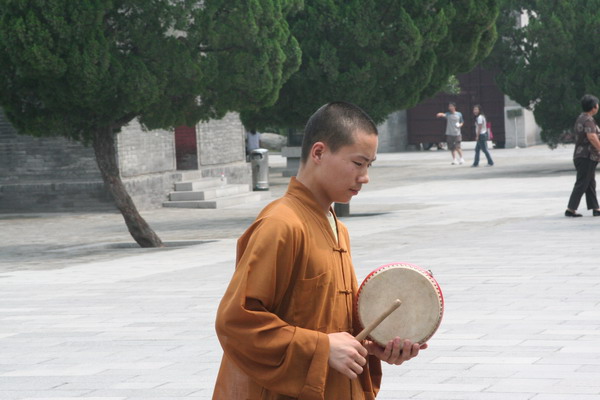
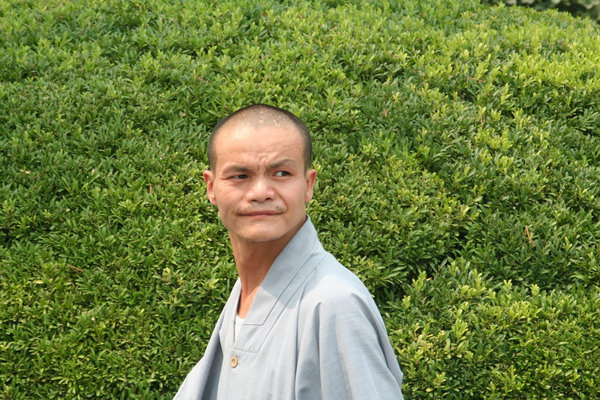
The next morning, we got up early and visited the city wall of Xi’an, which although much shorter than the Great Wall, was larger and impressive none the less.
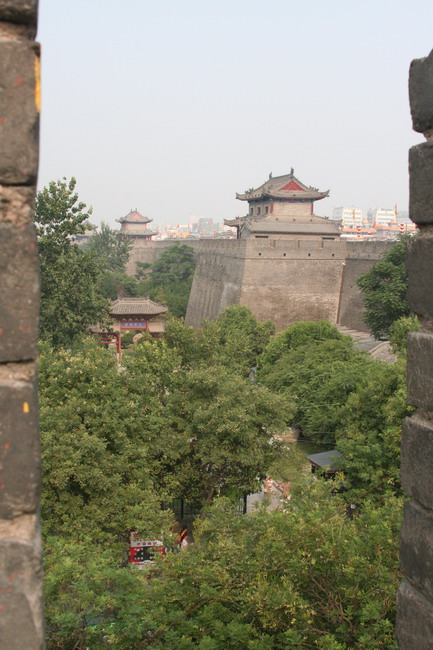
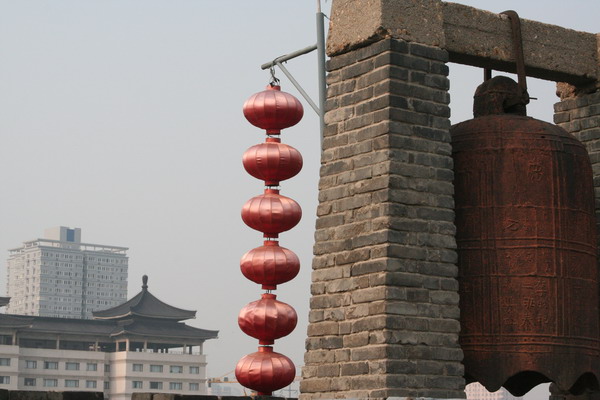

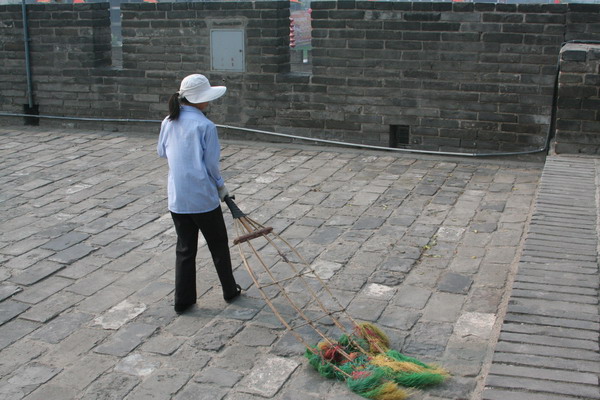
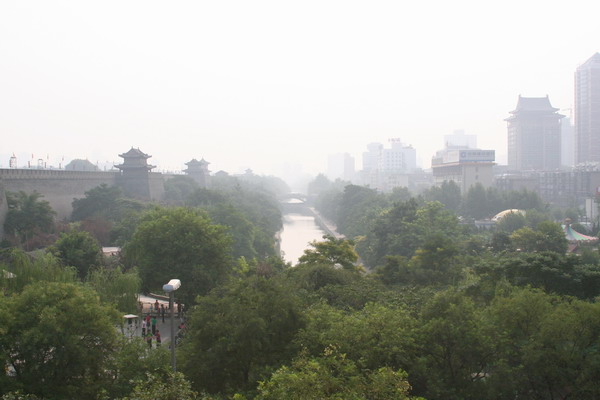
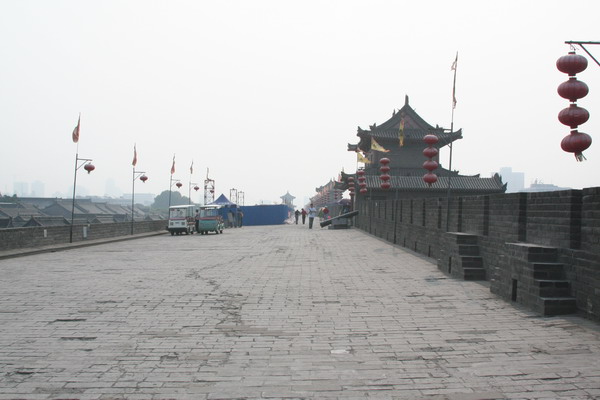
Back in the city, we found many more interesting people.
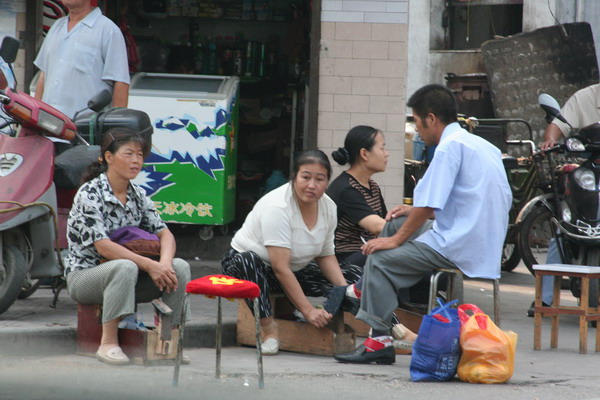
The man is demonstrating the fashion in China for men to keep cool (yes, it’s just the guys who do this … except one teenage Eurpean girl)
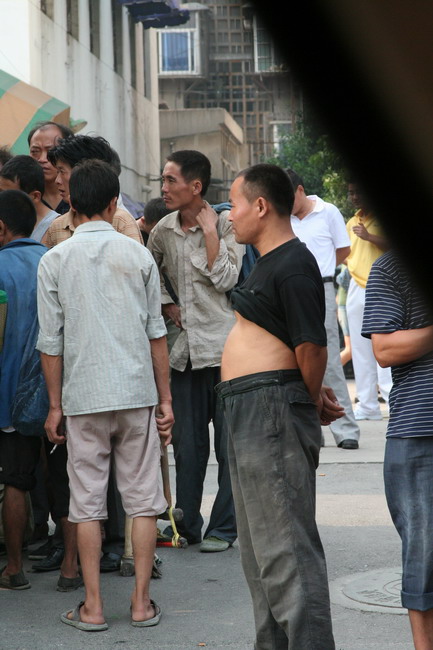
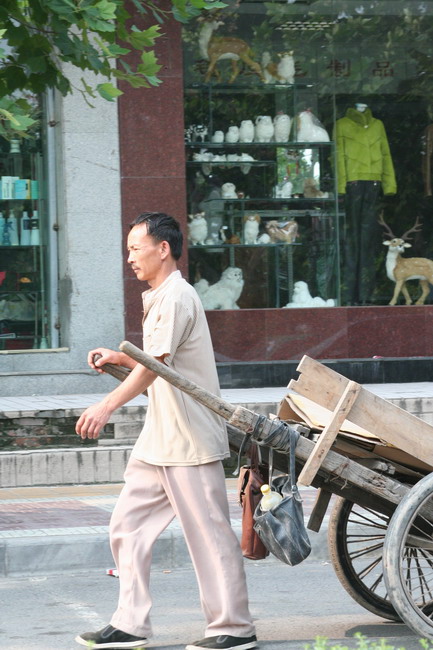
We also went to the regional history museum. It had very helpful displays that depicted the Chinese empires rise and fall through time.
This image was a taste for us of what was to come the next day. This is an actual Terra Cotta warrior from the archeological site outside the city.
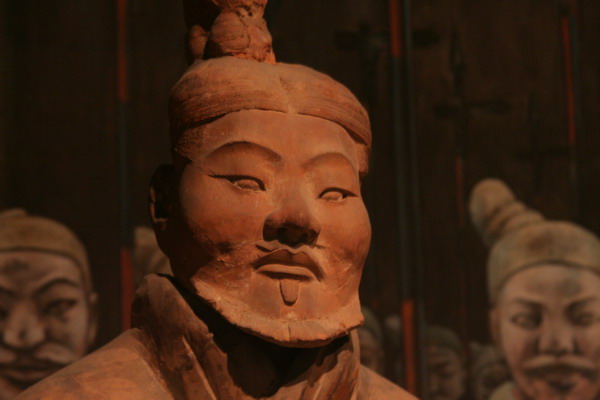
The next entry will of course will cover our tour of the magnificent Terra Cotta warrior site.
–Jim
China Part 3–Tiananmen Square (night) & Temple of Heaven
We decided to make a return trip to Tiananmen Square to see the difference the night made.
Here are some of the images.
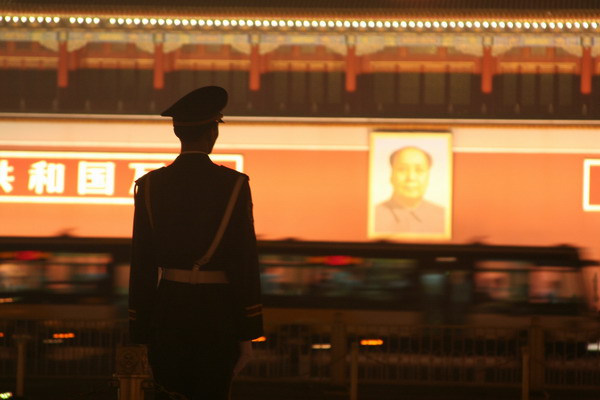
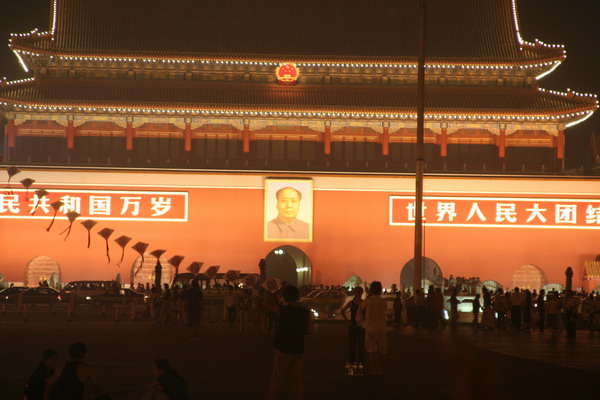
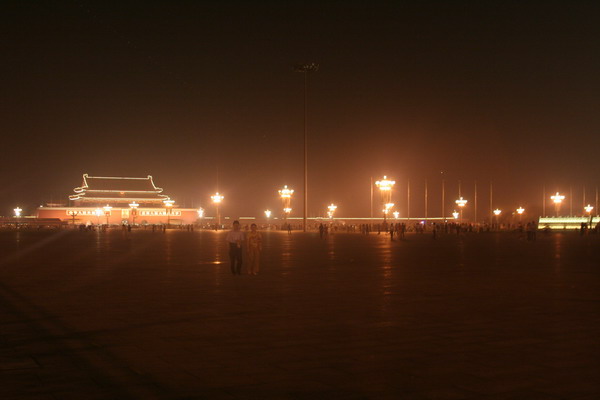
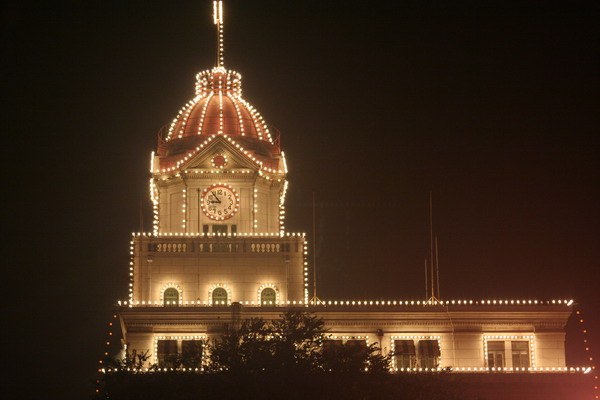

We also visited the Temple of Heaven. This very peaceful location, that is yet another example of Ming architecture, was where a large number of Chinese retirees came to relax. There were people doing all kinds of recreational activities (board games, dancing, singing, and rythmic gymnastics below).
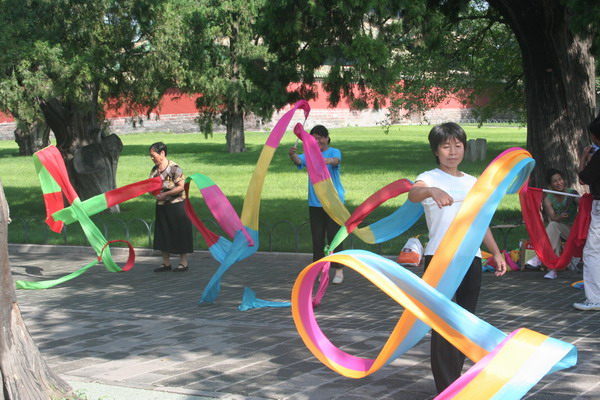
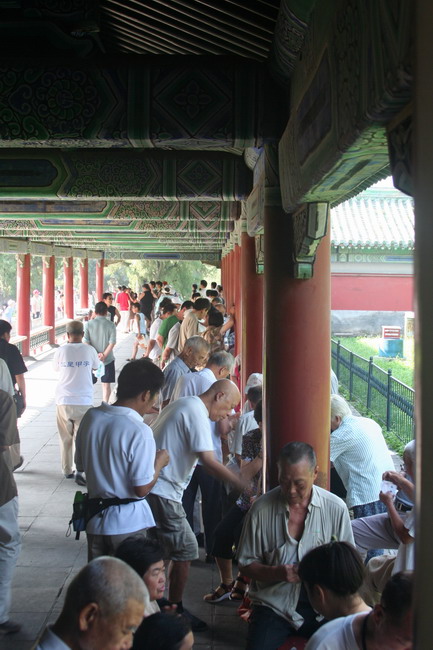
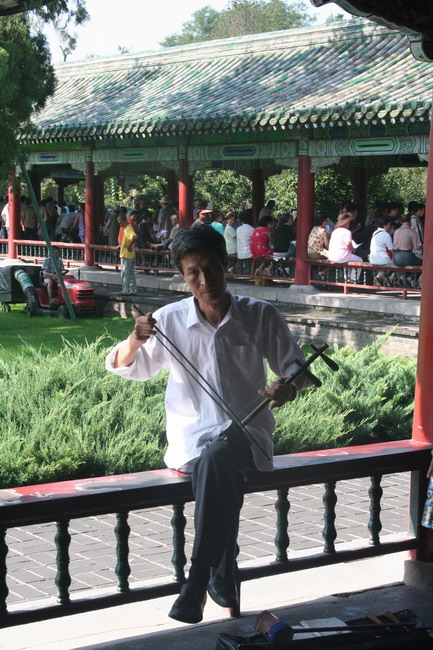
The main feature is Hall of Prayer for Good Harvests. It’s 38 meters high and the round structure symbolizes heaven, which is contrasted by the rectangular base (and walls) which are the earth.
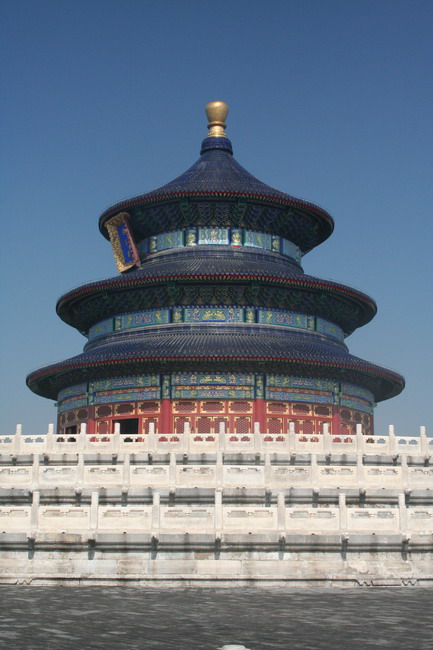

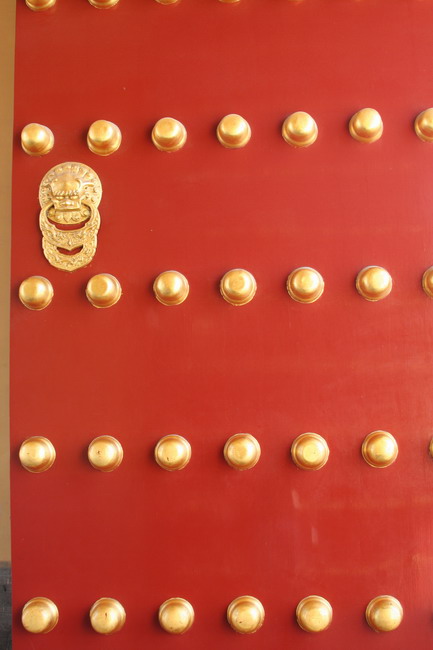
Next stop was a little cultural exploration in the form of shopping.
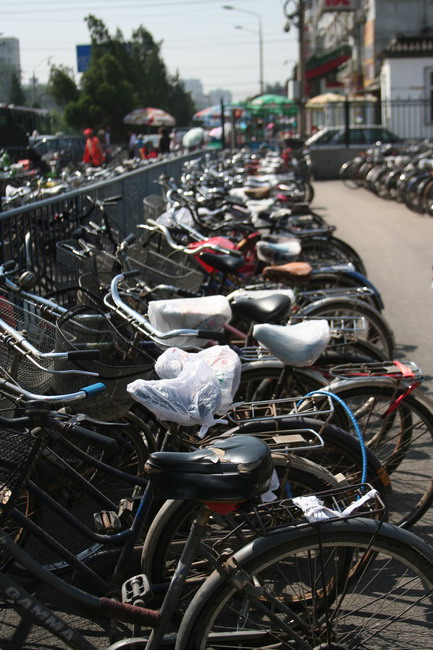
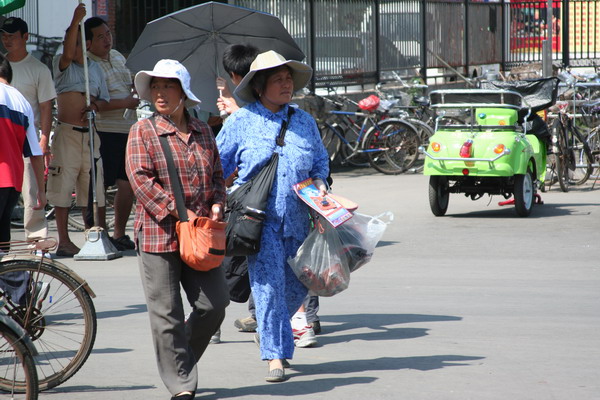
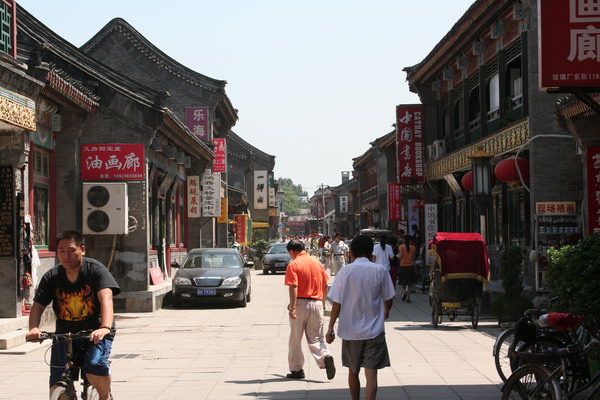
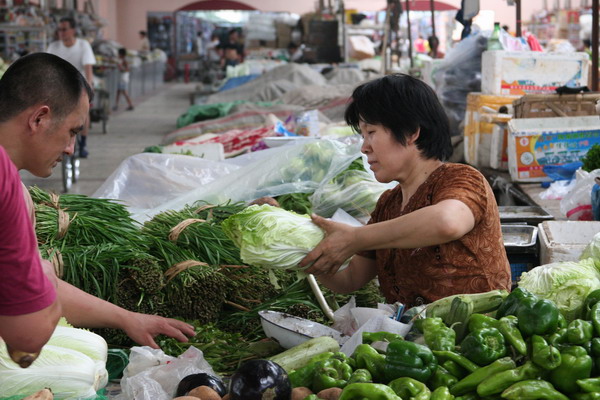
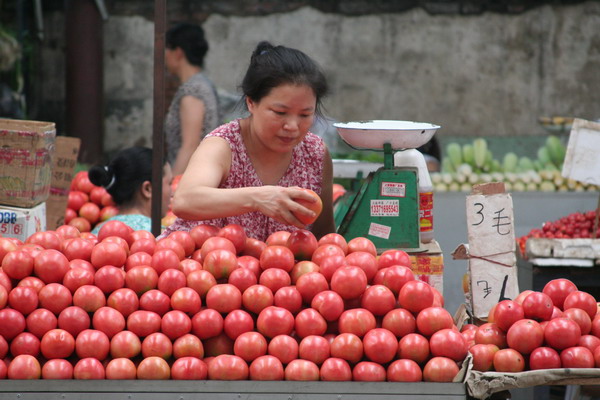
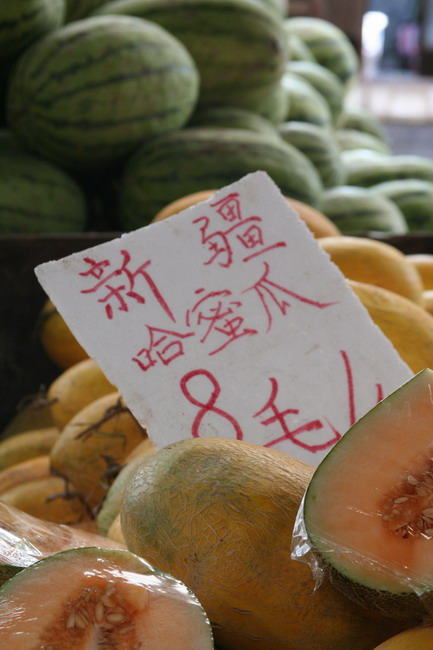
These are Dragon Fruit (Anna really liked the way they looked and their real name is Pitaya).
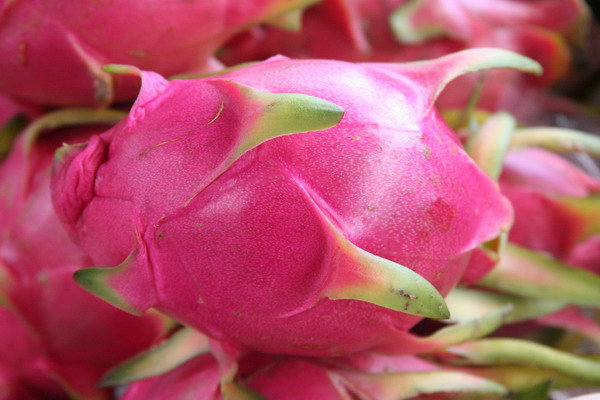
Then, there are the lychee fruits.

Another Chinese delicacy that we came to love were dumplings. Here is a group of cooks preparing them.
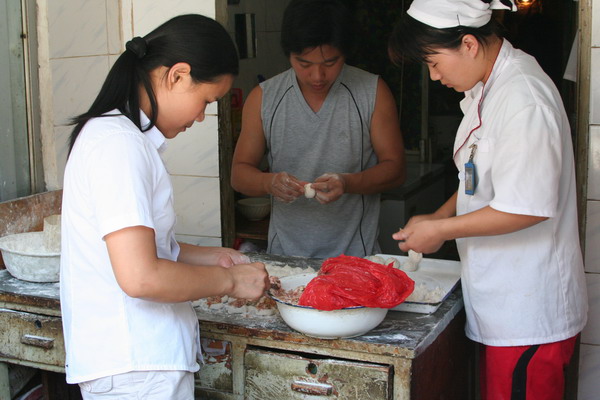
Not only did we explore on foot, we also went by pedicab. The areas we were exploring are called Hutongs (narrow alleyways). The roots of this type of urban development trace back to when Genghis Khan
laid waste to Beijing (known as Peking then). These narrow alley ways dominated zoning for the city for many centuries. However, they are rapidly being replaced by high rise apartment complexes (with much less character). Unfortunately, with the Olympic games coming to the city in 2008, the buildings there are being ruthlessly demolished by the government (with very little, if any, compensation to the owners). In fact, the atmosphere all around the country is of a headlong rush to modernize everything (oftentimes with extensive use of manual labor).
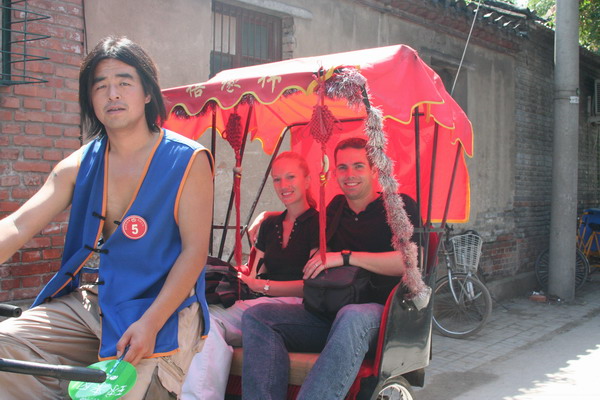
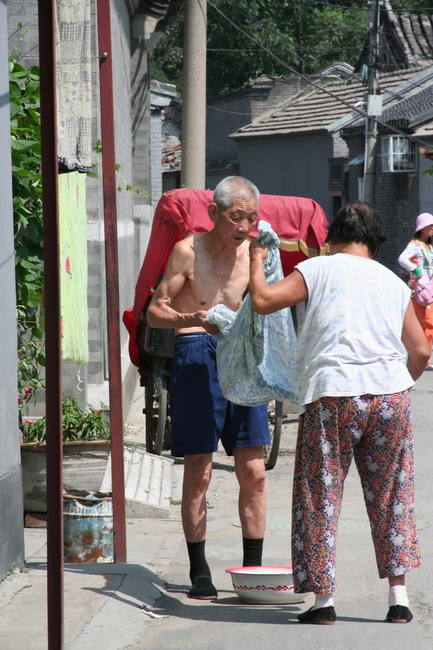
We also got a blown melted sugar sculpture of each of our birth years.
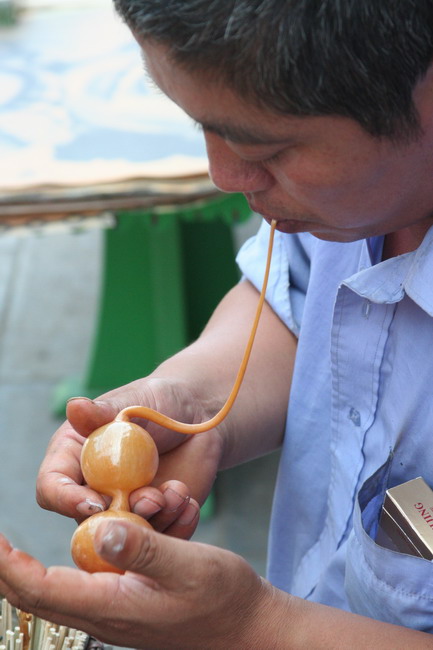
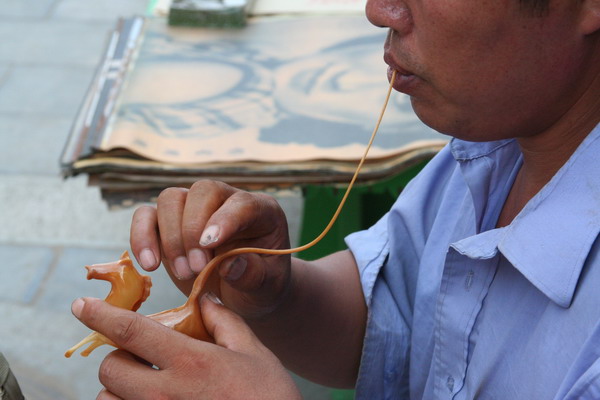
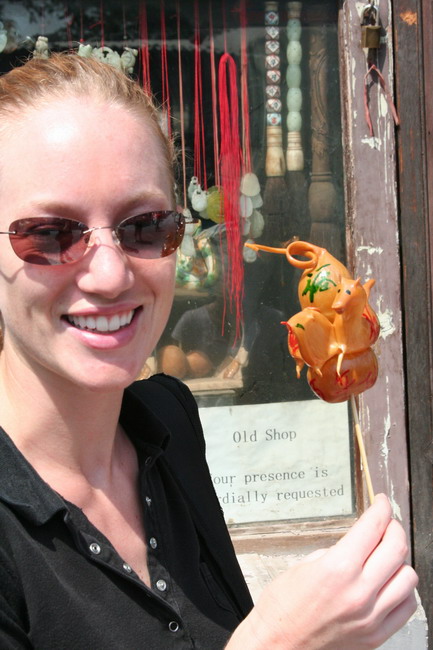
While it didn’t last long in the heat, it was fun to watch him make it.
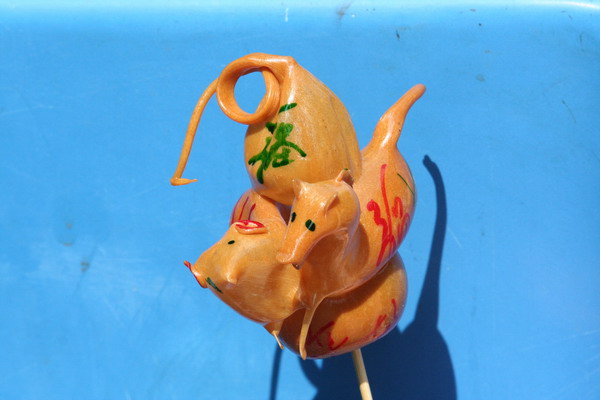
We also went to a tea shop that allowed us to sample different types of tea. Plus, they also had dried tea leaves with a chrysanthemum inside that blossomed with hot water.
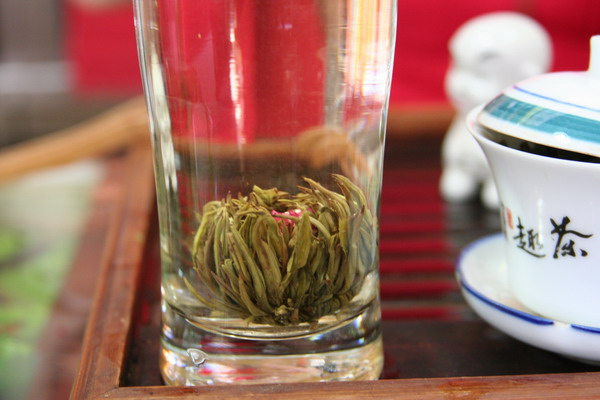
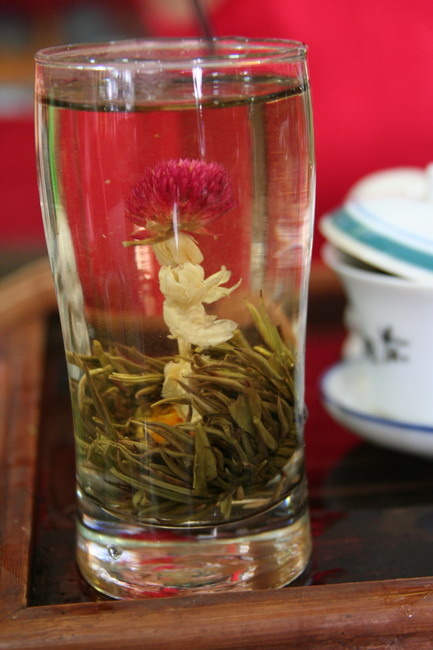
As a random picture, this is the view from our hotel.
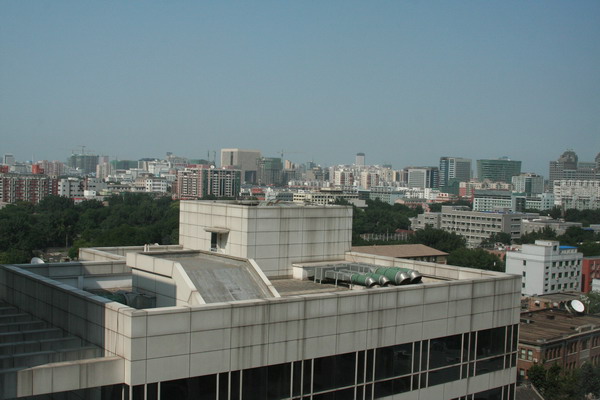
The next post will have our last pictures from Beijing and the first from Xi’an.
–Jim
China Part 2 — The Great Wall
OK, so I wasn’t able to keep up with the real time posts in China again. However, again, we have a huge number of pictures, so there will be a number of posts.
Next stop on the itinerary was one of the main reasons we went to China, to visit the Great Wall of China, truly one of the wonders of the world.
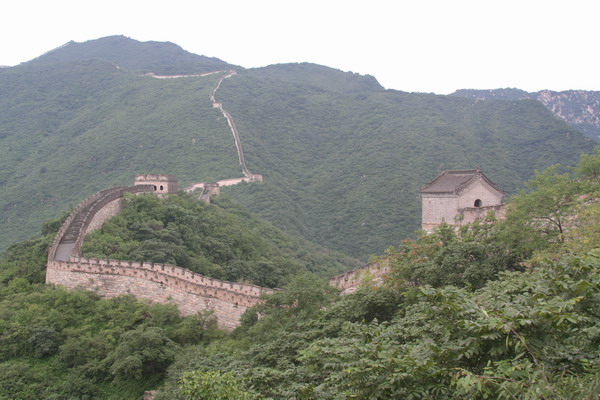
For those who don’t know much about the Great Wall (other than it’s really long wall in China). It was built and rebuilt at various times throughout history. However, it was started back in the Qin Dynasty (221-207 B.C.) when China was first unified by Emperor Qin Shi Huang, which makes the wall over 2,000 years old. They spent 10 years of forced labor and a massive human toll to build the original wall. This of course was very unpopular with the common people, since they were the ones sacrificing much and was one of the reasons that the Qin Dynasty was so short lived. However, during the Ming Dynasty (1368-1644) was when the wall took its modern form. During that time, over 100 years of effort went into making an impenetrable barrier, although it never really served as one. The idea was that at each guard house, sentries would light a fire to signal back to the capital Peking that an enemy was near (1 fire for 100 troops, 2 for 200 and 3 for 300 or more). As Gehghis Khan supposedly said, “The strength of a wall depends on the courage of those who defend it.” So, while it was never really impenetrable, it did serve a useful purpose of a convenient path to cross rough mountian terrain. Unfortunately, after the Ming Dynasty, the wall was largely forgotten and sections turned back into dust. Had not the tourism market resurrected it in the 20th century, the whole thing may have disappeared entirely. Now, there are several sections that have been restored to their original condition, as well as some that are in their more natural state. The place we chose to visit was called Mutianyu. It is a section 90 km northwest of Beijing and is about 2.5 km long. It was first built during the Northern Dynasties (386-581), but rebuilt during the Ming Dynasty. This section is between 7 and 8 meters high and 4-5 meters wide at the top.
Ok, enough description, here are our pictures of the Great Wall of China.
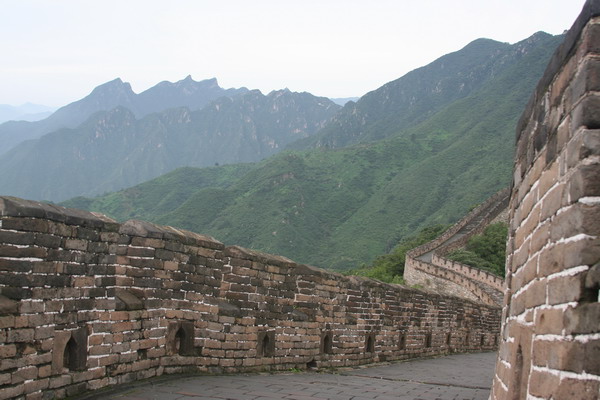
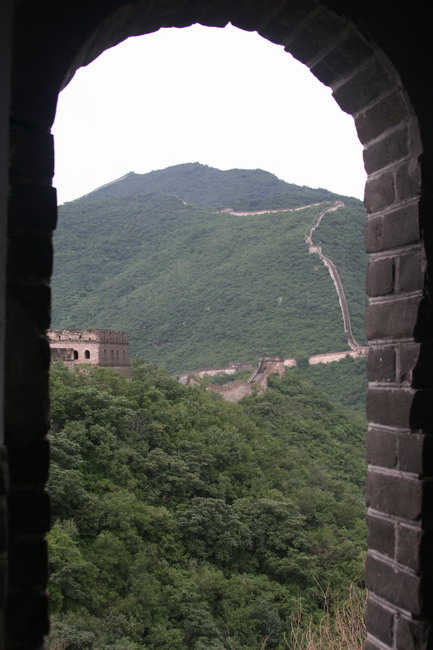
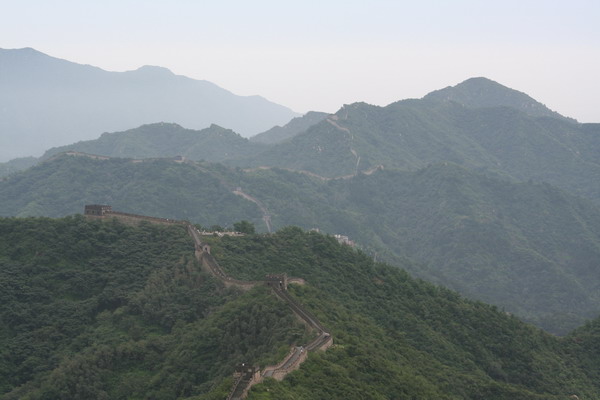
At the end of the wall, there was a rampart at the top of 400 stairs that offered a commanding and serene view of the surrounding area. Anna found this perch a very agreeable spot to watch the few other tourists climb the wall.
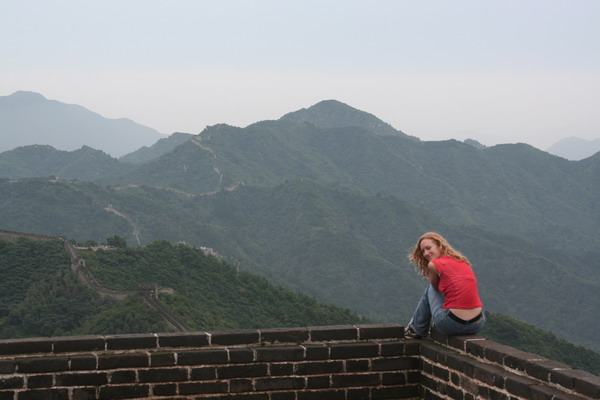
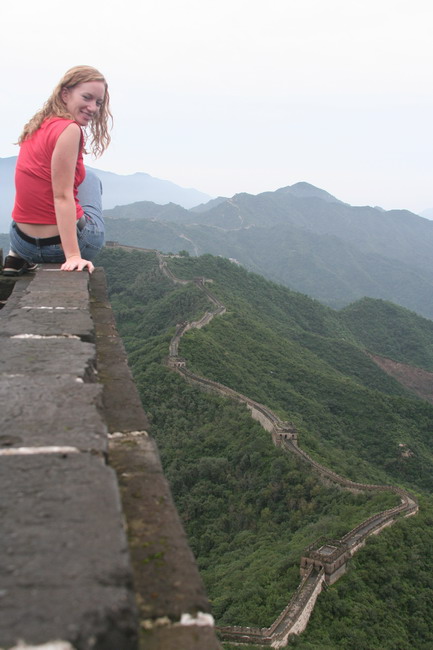
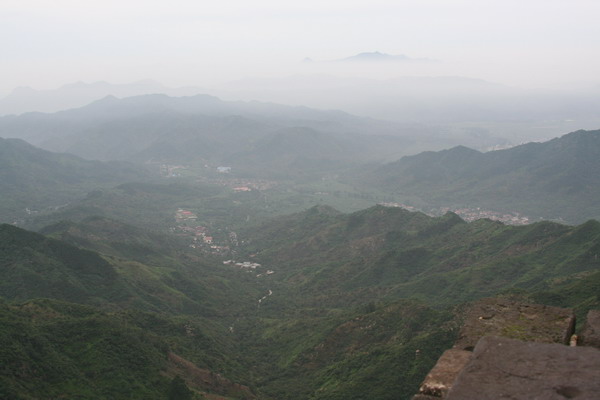
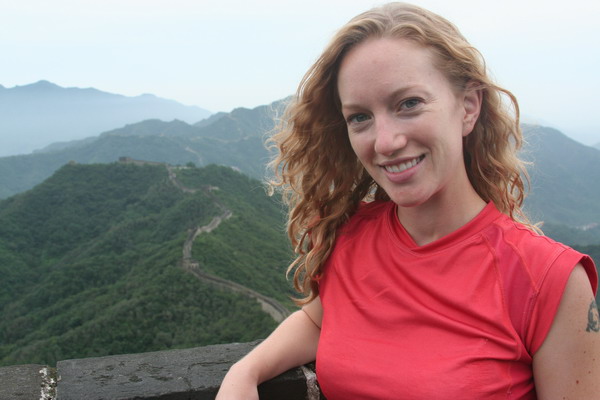
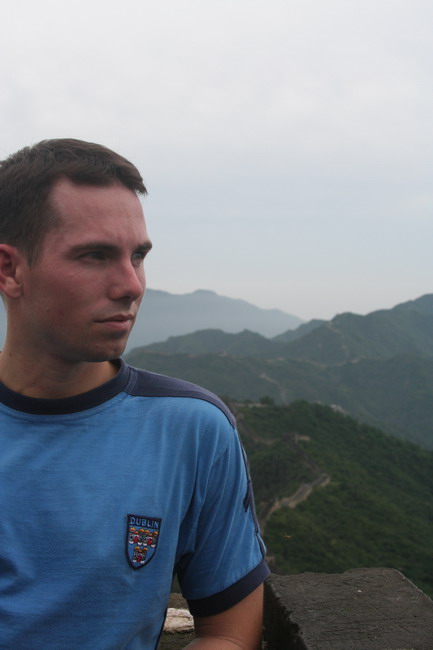
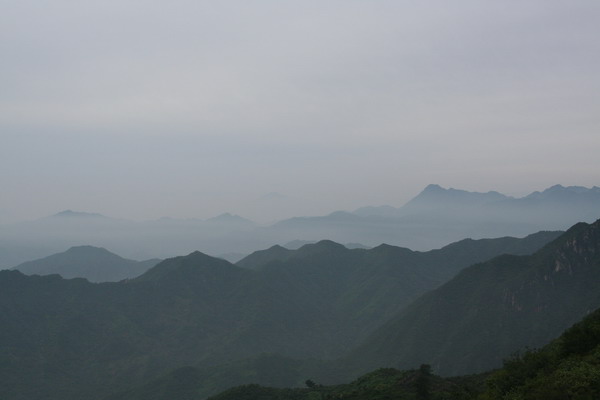
As you can see, after centuries of neglect, the wall has deteriorated quite significantly.
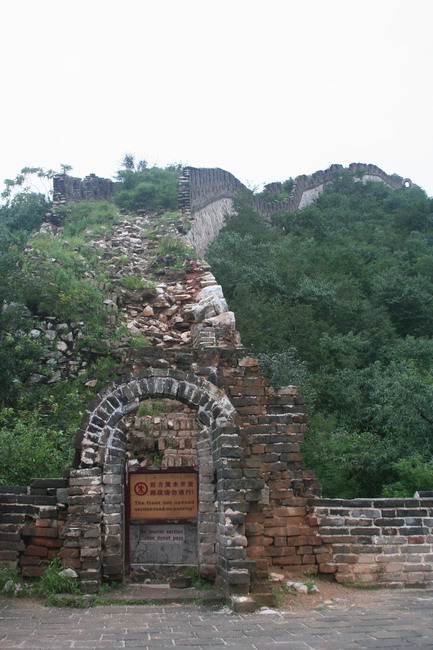
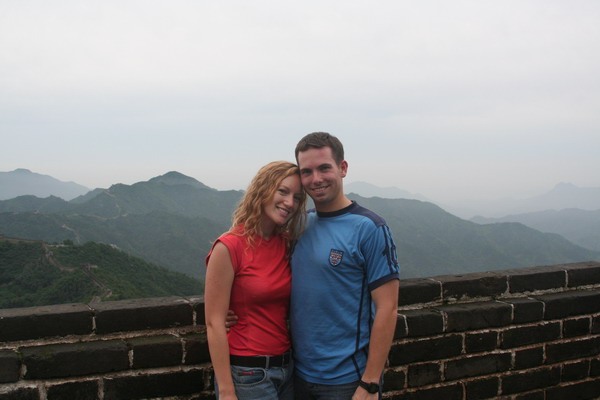
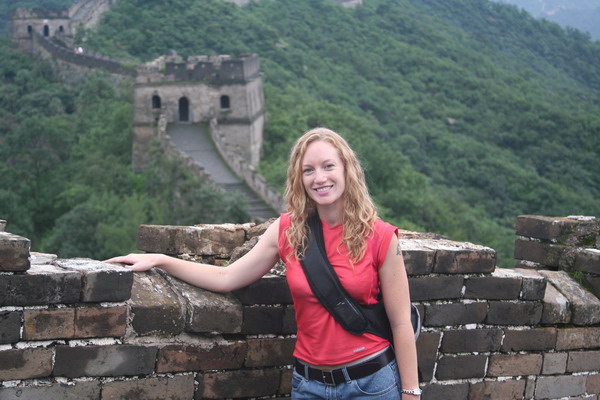
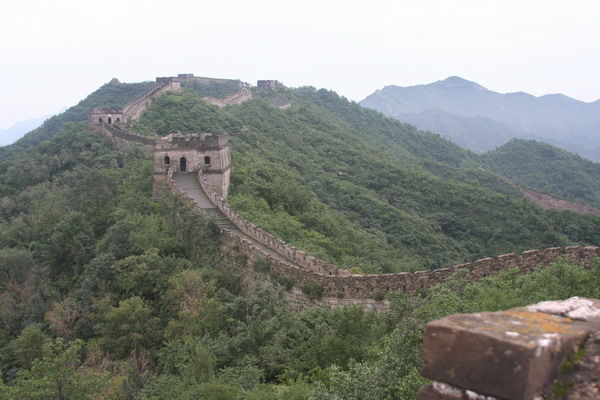
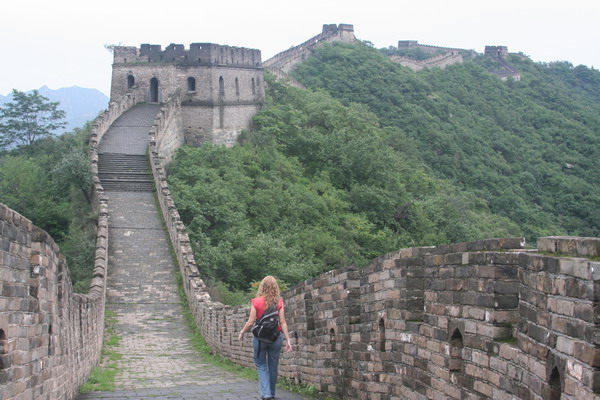
You can see one of the guard towers here.

There was even one hardy vendor who was willing to bring snacks and drinks up the mountain to hungry and thirsty tourists (with a little help from his friends here). Amazingly, the price was about the same as other places much further down.
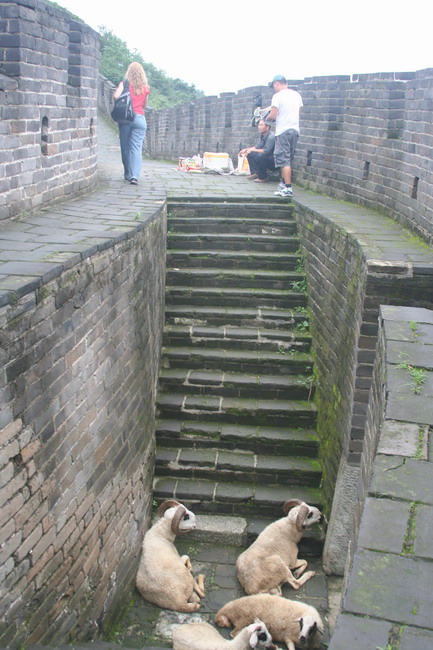
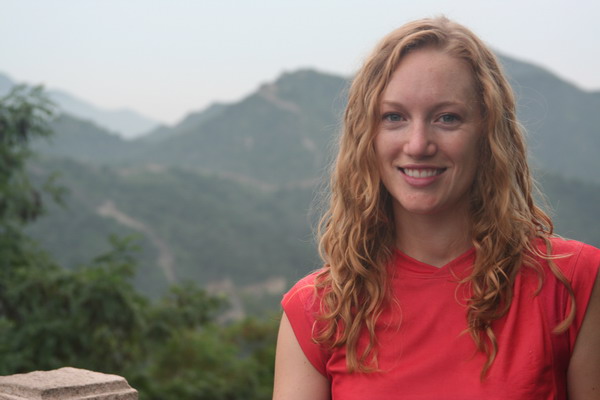
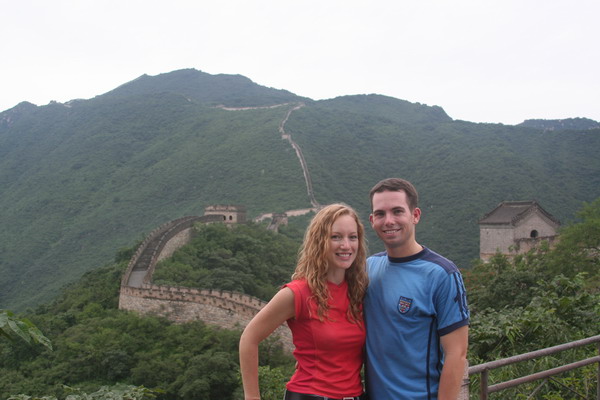
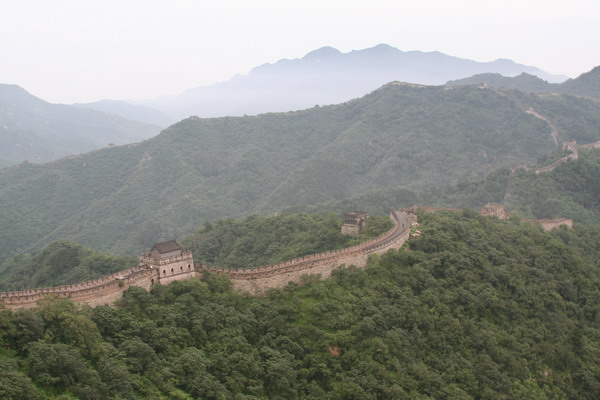
After we finished exploring the wall (although we could have easily stayed and explored a couple more sections), our guide and driver were ready to take us to our next location. Let me take a couple sentences to say just how nice it was to have a personal escort throughout our time in China. Normally, as you probably figured out by now, we like to blaze our own trail and explore on our own. However, in China we decided to use a personal guide and driver. It made things so much easier. Between our everpresent Lonely Planet guidebook (which is our favorite travel companion) and our guide, every question we had was answered. 🙂 Plus, a driver was there to drop us off as close as possible and wisk us away when we finished.
Here they are, ready to head back to Beijing.
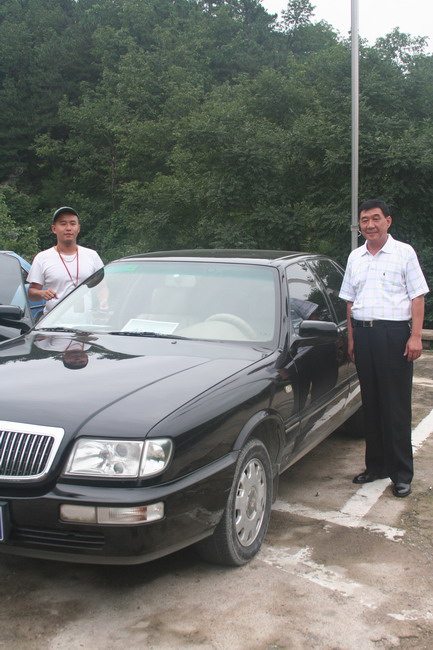
While China is certainly still a third world country, it has a couple unique traffic features. While not unique to China, they are certainly interesting to note (and not a bad idea for the US as well).
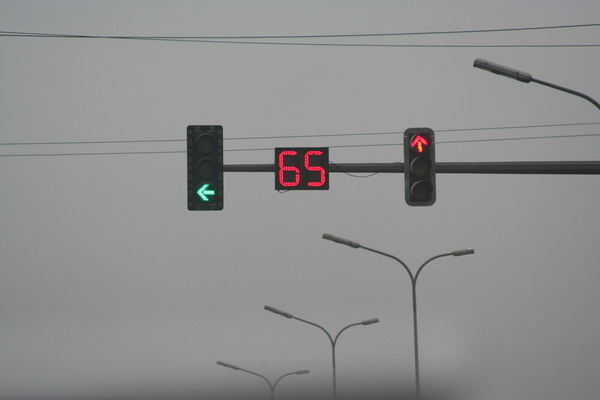
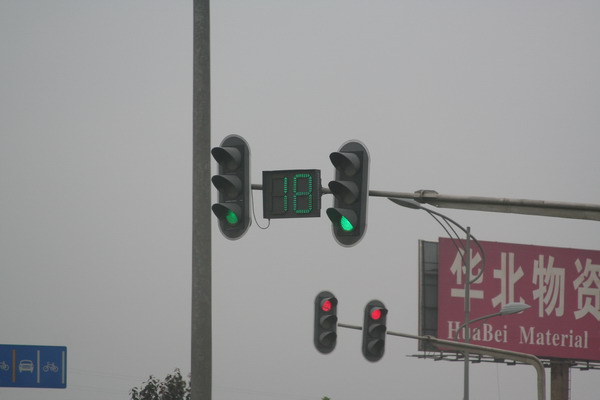
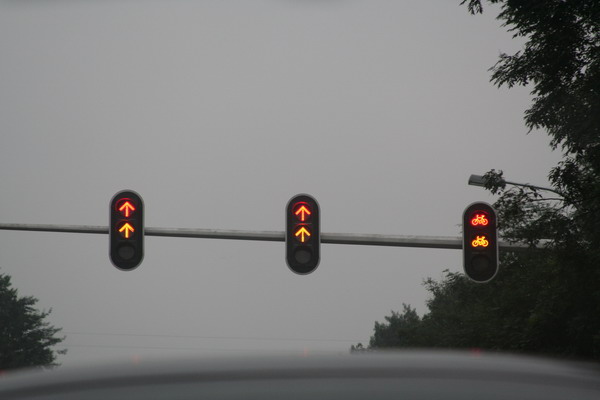
We also stopped by the Ming Tombs. This is the final resting place for 13 of the 16 Ming Dynasty Emperors. It had a very serene Sacred Road that led to the tomb.
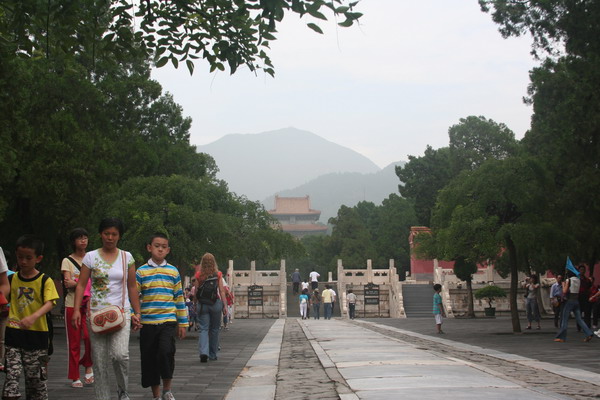
However, perhaps one of the most interesting parts of the tour was a trip into Dingling. It’s the underground tomb of Emperor Wanli. You can see from this picture that people liked to throw money on his throne.
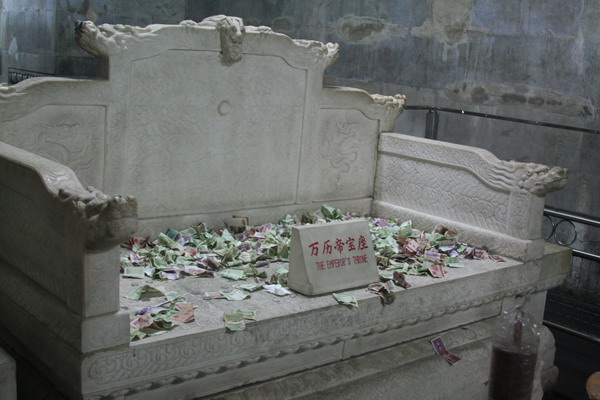
However, apparently, people didn’t feel the same way about his wife…
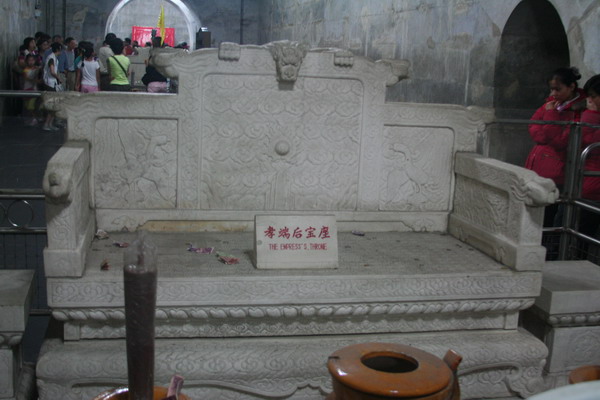
This is an interesting perspective looking back into the burial chambers.

After dinner, we came outside to this beautiful full rainbow.
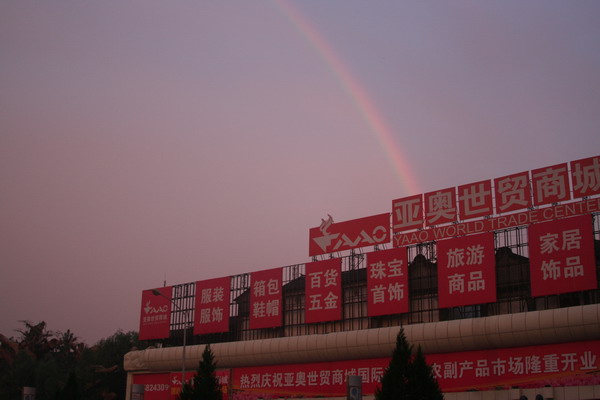
The Great Wall was without question our favorite site to see in China. So, this was an outstanding day. 🙂
Not to worry, there will be several other posts of our China adventures.
–Jim
China Part 1 — Tiananmen Square, Forbidden City and Summer Palace
Yesterday we began our voyage into mainland China. However, it wasn’t until today until we began our exploration in earnest.
The first stop on our itinerary was the infamous Tiananmen Square. This of course was the site of the massive 1989 pro-democracy demonstration, where tanks were seen rolling in against student protestors. It is fitting that because the revolutionary Chinese leader, Chairman Mao Zedong, conceived the idea of the square, was also where one million Chinese paid their final respects to him in 1976.
Tiananmen Square is perhaps the symbolic center of China. This is evidenced by the mausoleum on one side that contains the remains of Chairman Mao. In fact, it has both a wax likeness and his actual body entombed in formaldahyde. As we passed the entrance in the morning, our guide informed us that Chinese people make it a ritual to visit and pay their respects every (or at lease many) mornings. Also, there is a “meridian” that runs directly through the middle of the square.
In addition, there’s a large monument in the middle of the square, called the Monument to the People’s Heros. This was completed in 1958, it’s about 40m high, and bears the inscription “Eternal Glory to the People’s Heros.”
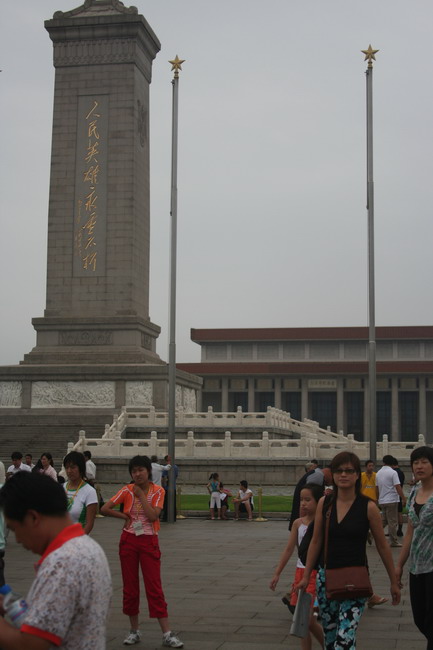
On the other side, there is the Great Hall of the People. Here’s an image of it.
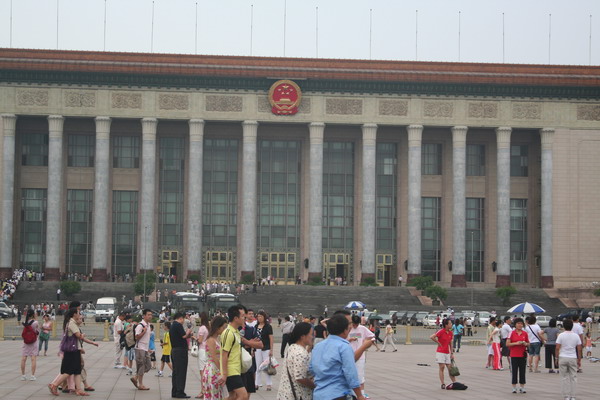
Here is the National Grand Theater, which advertises that the Olympic Games are coming to the capital city. In fact, there are several large clocks in the city that count down how much time is remaining (as of today, it was 725 days…).
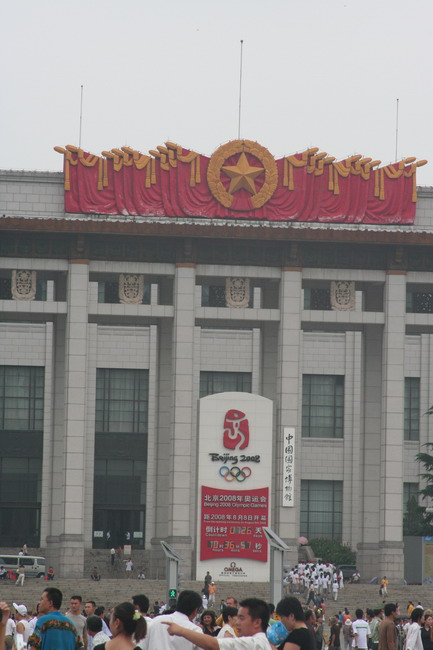
Looking over the throngs of people, you can see the Gate of Heavenly Peace. This was built in the 15th century (and restored in the 17th), and serves as the main gate for the Imperial Wall that encases the Forbidden City within. Also, it was from here that Chairman Mao proclaimed the People’s Republic of China on 1 October 1949. You can see his portrait is the main feature of the gate. The inscription on either side reads, “Long Live the People’s Republic” on the left and “Long Live the Unity of the People’s of the World” on the right. An interesting side note is that the painting was pelted with paint filled eggs during the 1989 demonstration.
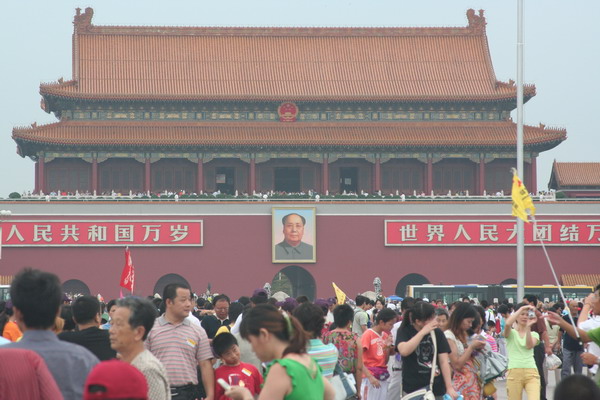
Government service is compulsory in China for 4 years. You can determine what branch these officials are in by the color of their uniform. Green is the military, blue for police, and gray for security.
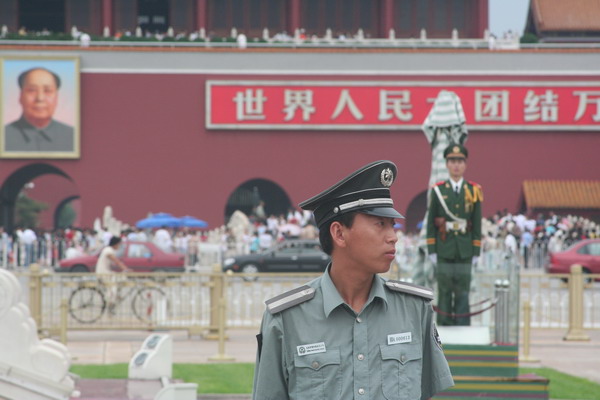
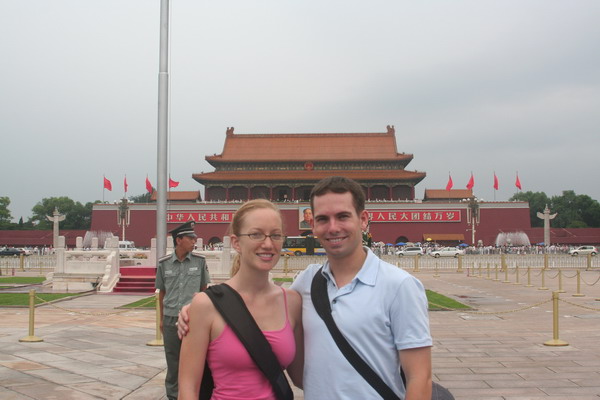
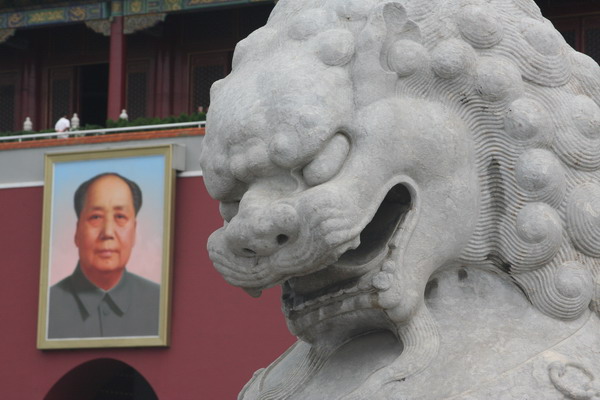
Inside the front gate of the Forbidden City (there are actually nine gates separating the inner city, with the outer). In fact, the number nine has special significance. It is viewed as the perfect number. It’s the largest single decimal number, and has spiritual importance.
The Forbidden City is so called because it was off limits to the common people for 500 years. It is the largest cluster of ancient buildings in China. It was home to the Ming and Qing dynasties. Some of the imperial family may have never left the compund. If they did venture out, it was only when absolutely neccessary, and proceeded by a large entourage and accompanied by a loud bell to signify that they were about to depart the inner city. You can see people re-enacting royalty with the yellow robes.
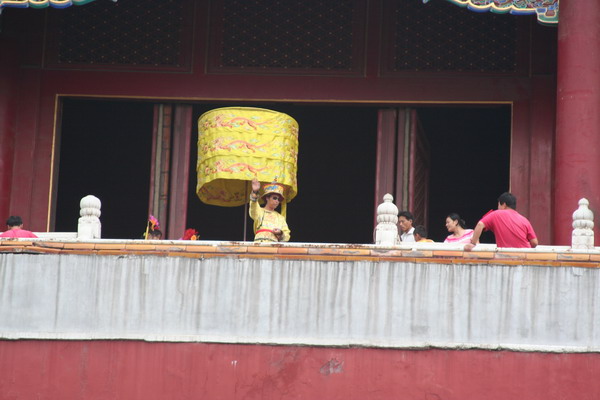
More soldiers…
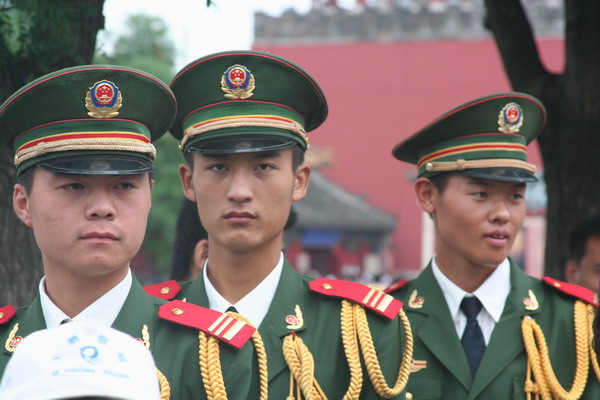
Another gate as we passed further into the Forbidden City. People seemed to have an affinity to touch certain items (like these brass knobs on the gate).
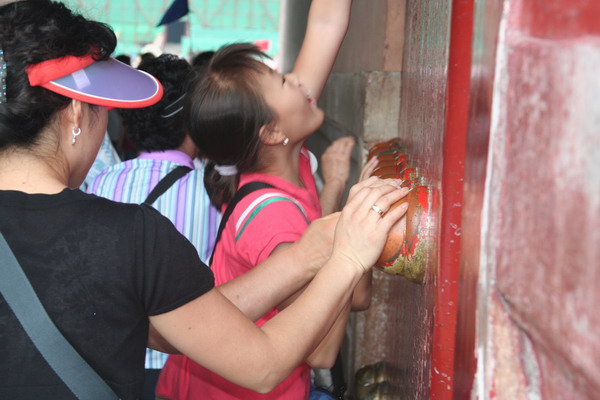
Here you can see the intricate painting on the steeples of the palace.
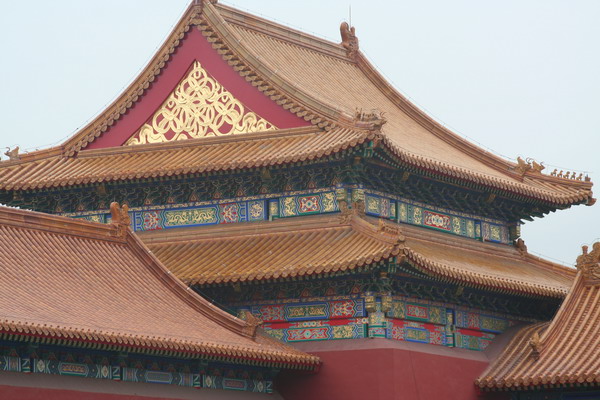

Here is one of the many thrones for the emperor. This one was for last minute preparations before he went out to the outer city.
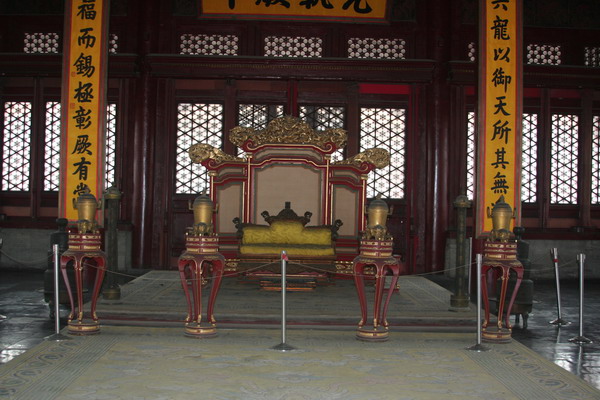
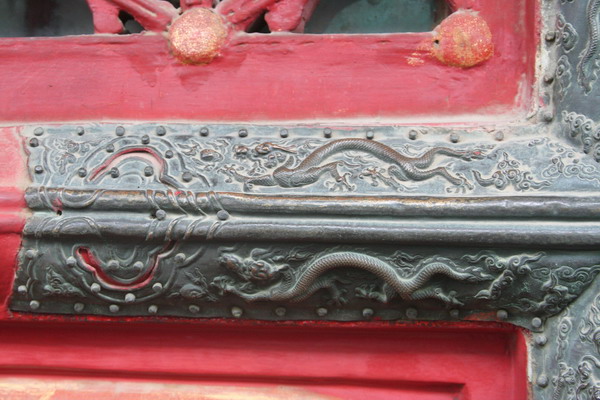
These kids are holding the side of a large container that held water to extinguish any fires that flared up in the city.
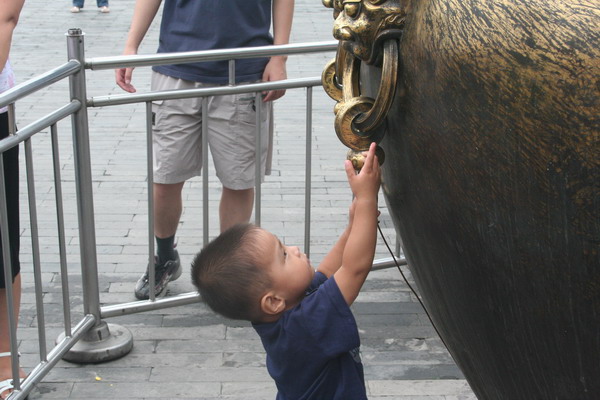
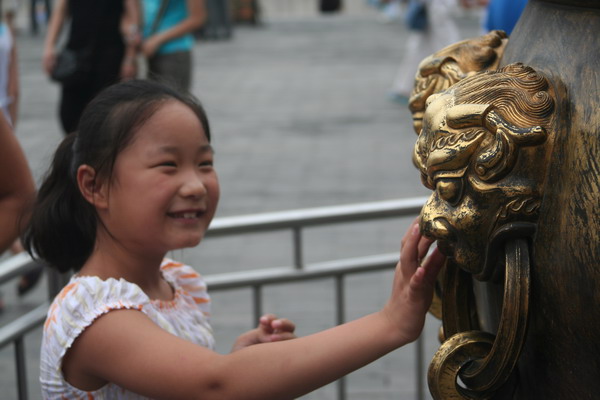
There are many real and symbolic guards to the city…
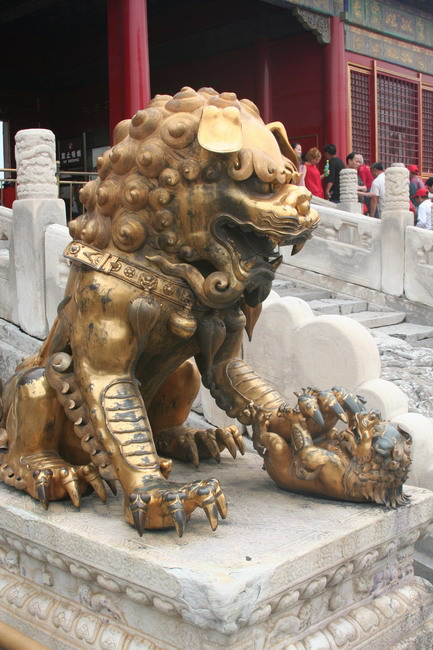
Here is the main throne for the emperor. As you can see it is quite imposing, although rather austere.
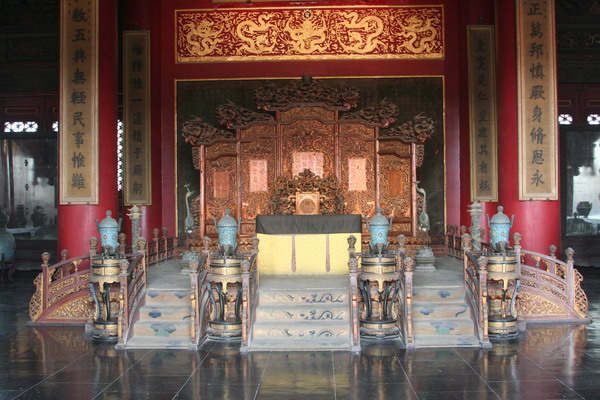
Animals on the roof … you’ll note there are 9 of them…
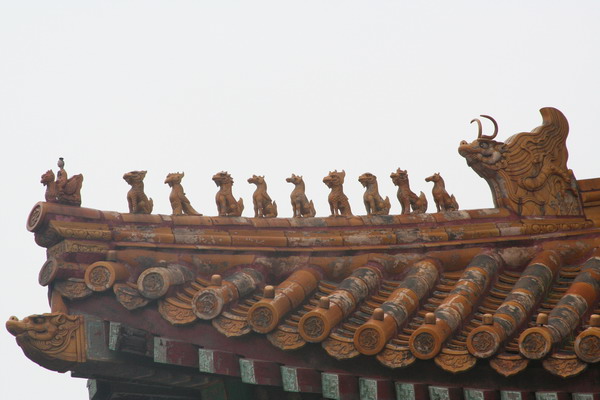
The Love Tree. It begins as 2 individual trees, but grows together as one.
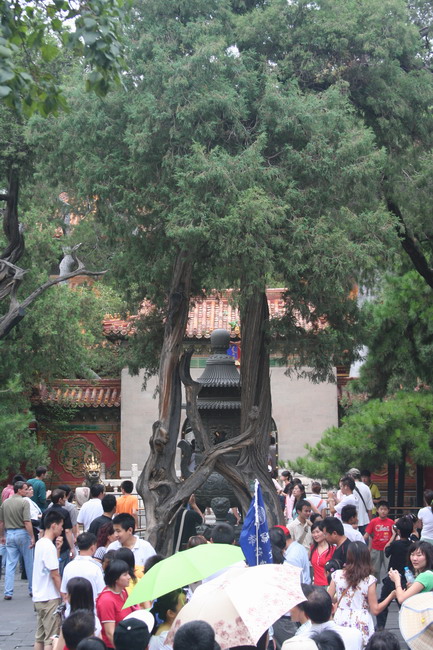
Here is a view of the wall that surrounds the city. Anna liked that the mortar was made with egg whites and rice water.
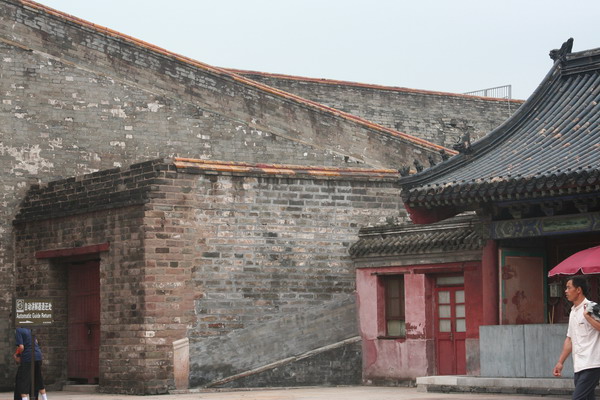
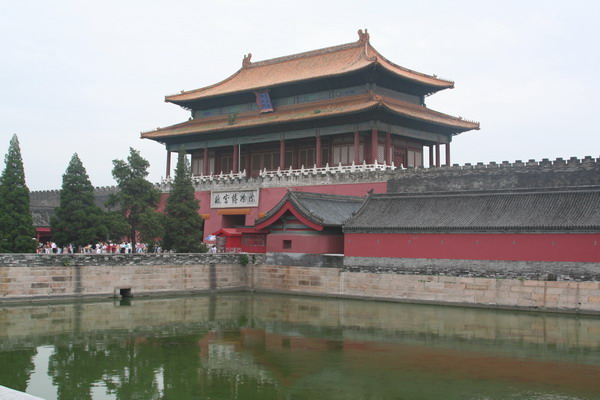
From the Forbidden City, we traveled to the Summer Palace. It was the place where royalty came to escape the furnace like heat of Beijing in the summer.
Here you can see Kunming Lake, which was deepend to about 7 meters and expanded with the help of about 100,000 labourers in the 18th century.
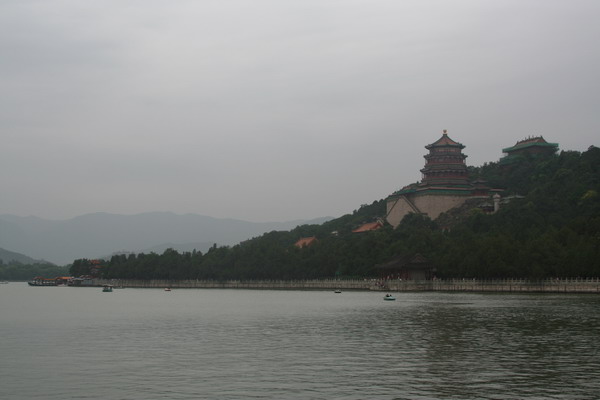
The trees are even labeled according to their age. This one idicates that it’s over 300 years old. I suppose that’s the benefit of having someone living in the same place for thousands of years, keeping records of everything that happens. 🙂
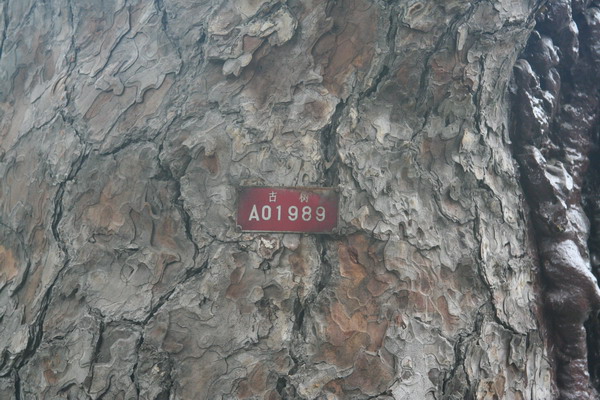
Anna exploring the halls…
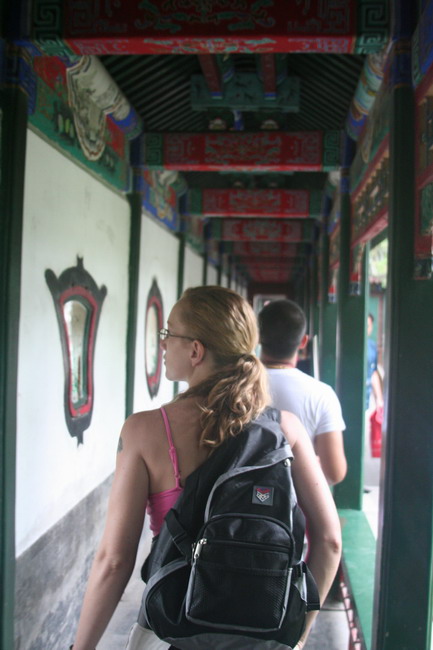
Note how many archways lead to the middle of this bridge.
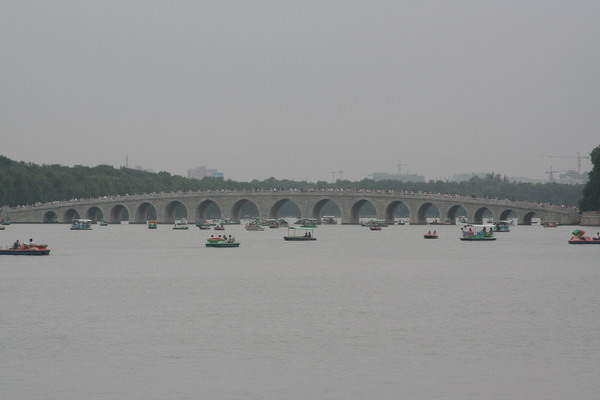
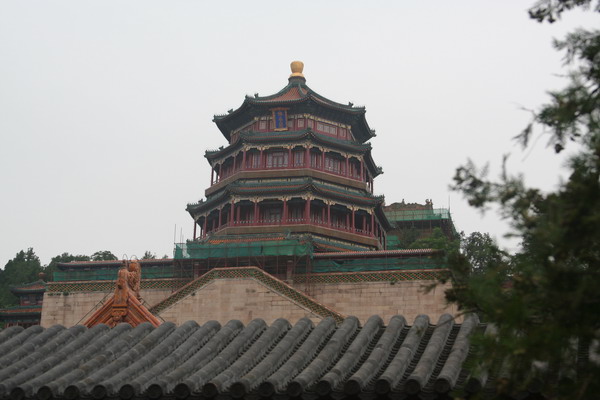
More guards…
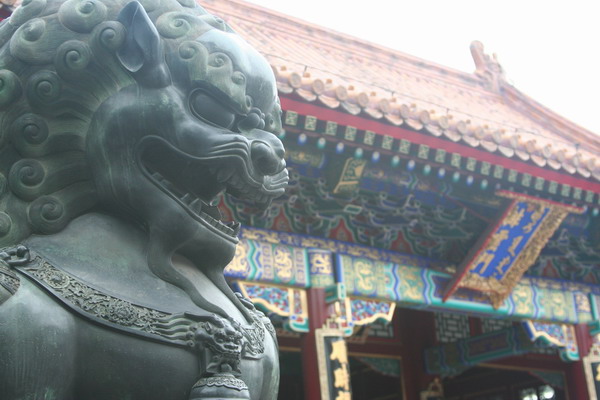
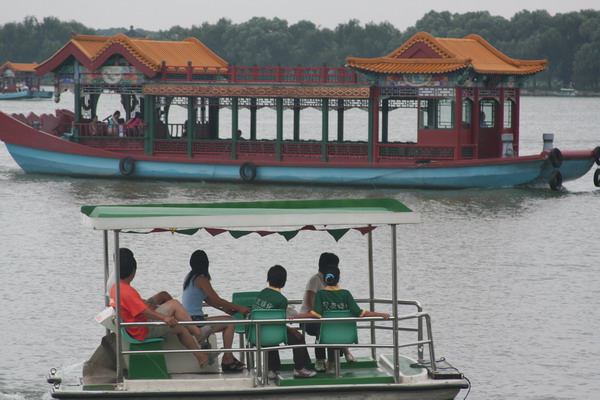
In 1888 the Empress Dowager Cixi used money earmarked for a modern Navy and used it refit buildings damaged in the Second Opium War of 1860. This is the only nautical device she had built. Although quite beautiful, the marble construction doesn’t make it the most sea worthy vessel around.
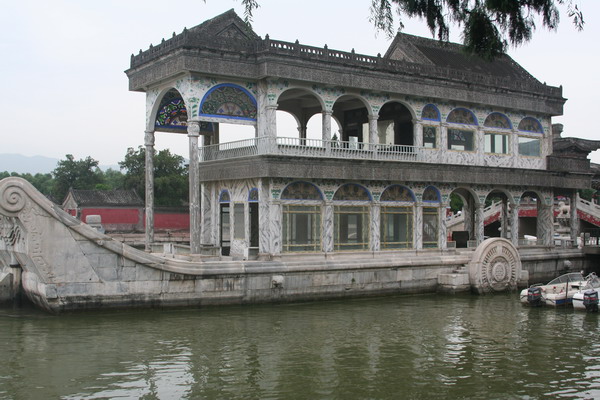
We ended our first day with a Kung Fu show. It was a spectacular display of form, precision, athleticism, and drama (as it was told in the form of a story). The experience was quite enjoyable.
That brought day one to a close. Day 2 holds the Great Wall, the Sacred Road, and the underground palace of Dingling. Dinner tonight will be the signature dish of Beijing, Peking Duck. Yum. I promise, you will hear all about it soon.
Until then…
–Jim
Iwo Jima: 61 years later (2006)–Part 2
***Please read the entry Iwo Jima: 1945 and Part 1 first***
Perhaps the most poignant part of the whole trip was our time on Mt Suribachi. There is a memorial to both the American and Japanese forces on top.

Here is the American Memorial on the top of Mt Suribachi. From wverything I have seen and read about the battle. The inscription is VERY apropos.
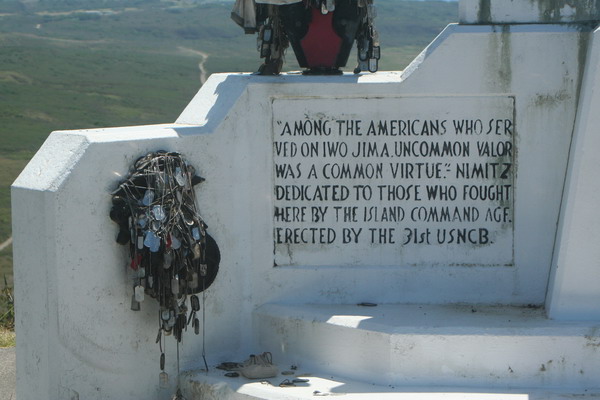
Here is the other side.
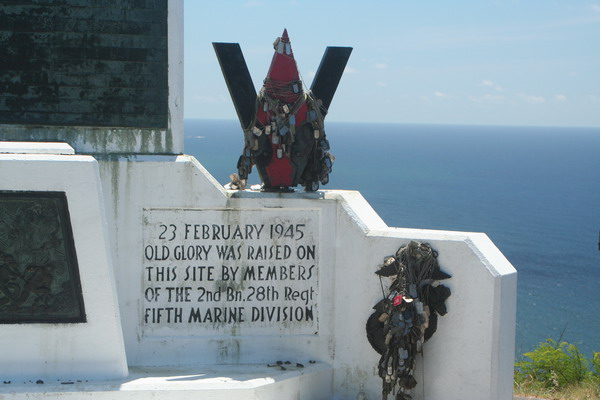
Many Marines (and other service members) have left tributes to those who have gone before. These dog tags are a very fitting tribute.
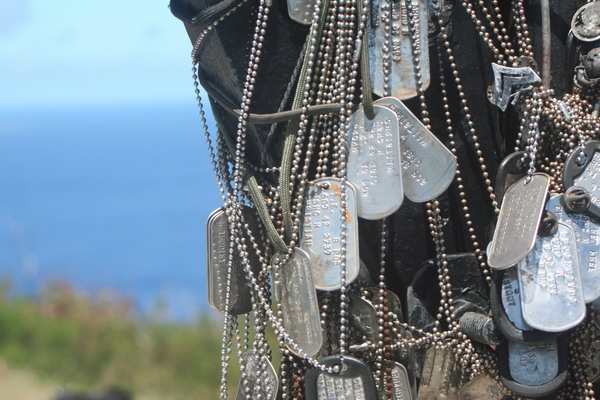
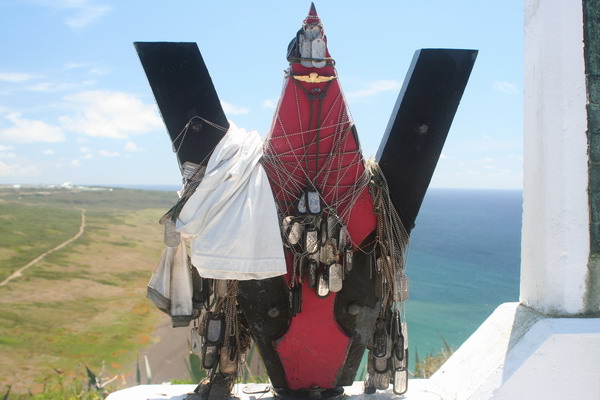
As you can see from this picture, everyone from a private to four
star general thought it appropriate to leave a bit of themselves behind on this small edifice.

An interesting story about the flag raising. Of course you know that there were two flag raisings on the summit of Mt Suribachi. The second (and famous) flag was raised by six people. Of that, three were killed soon after in action on Iwo Jima. Of the remaining three there is one person who actually raised both flags. In fact, he wasn’t even a Marine. He was a Navy Corpsmen. He was assigned as a hospitable corpsman to a Marine rifle company. His name is John Bradley and he’s from a little town in North-Central Wisconsin called Antigo. For his actions on Iwo Jima, he was awarded the Navy Cross (the second highest medal, after the Medal of Honor). Here is what the citation to accompany award reads:
“For extraordinary heroism in action against the enemy at Iwo Jima on Feb. 21, 1945 as a hospital corpsman attached to a Marine Rifle platoon. During a furious assault by his company upon a strongly defended enemy zone at the base of Mt. Suribachi, Bradley observed a Marine infantryman fall wounded in an open area under a pounding barrage by mortars, interlaced with a merciless crossfire from Machine guns.
“With complete disregard for his own safety, he ran through the intense fire to the side of the fallen Marine, examined his wounds and ascertained that an immediate administration of plasma was necessary to save the man’s life. Unwilling to subject any of his comrades to the danger to which he had so valiantly exposed himself, he signaled would-be assistants to remain where they were. Placing himself in a position to shield the wounded man, he tied a plasma unit to a rifle planted upright in the sand and continued his life saving mission.
The Marine’s wounds bandaged and the condition of shock relieved by plasma, Bradley pulled the man thirty yards through intense enemy fire to a position of safety. His indomitable spirit, dauntless initiative, and heroic devotion to duty were an inspiration to those with who he served and were in keeping with the highest tradition of the United States Naval Service.”
He survived the war (although injured in both legs a month after the invasion of Iwo Jima) and returned to put his life back together in Wisconsin. When he passed away in 1994, the following was written about him in an editorial in his hometown paper, “The Antigo Daily Journal”:
“John Bradley will be forever memorialized for a few moments action at the top of a remote Pacific mountain. We prefer to remember him for his life. If the famous flag-raising at Iwo Jima symbolized American patriotism and valor, Bradley’s quiet, modest nature and philanthropic efforts shine as an example of the best of small town American values.”
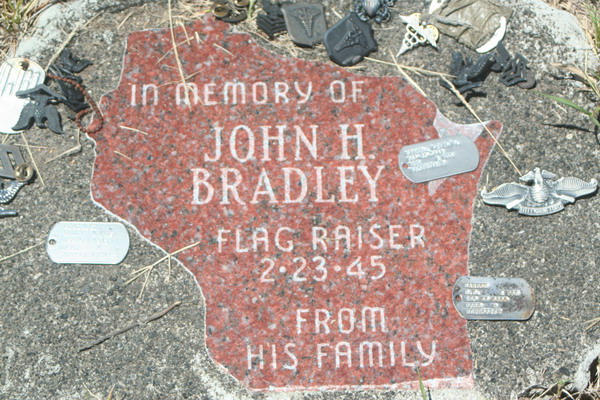
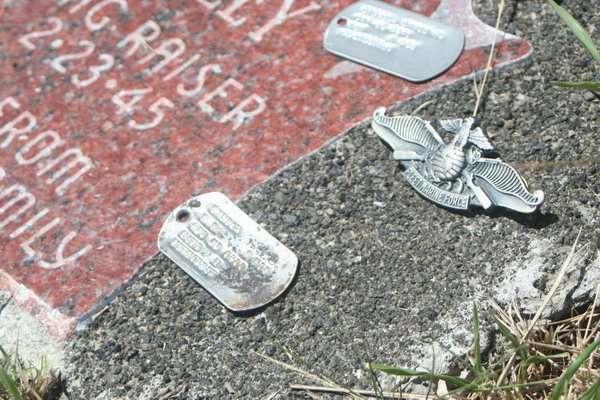
From the vantage point on the top of Mt Suribachi, it’s very plain to see how easy it was to wreak so much havoc on the American invaders. Here is what the invasion beach looks like:
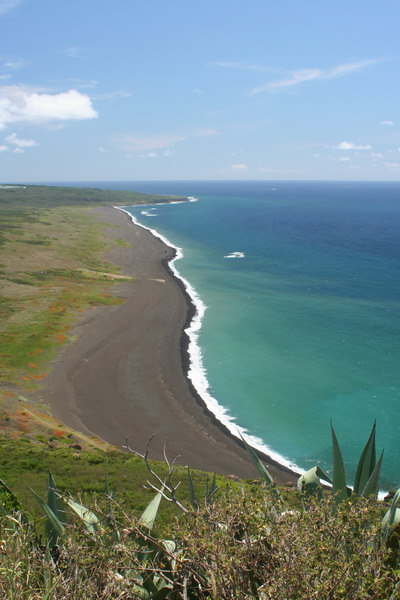
Here is the Japanese memorial to the island’s defenders.
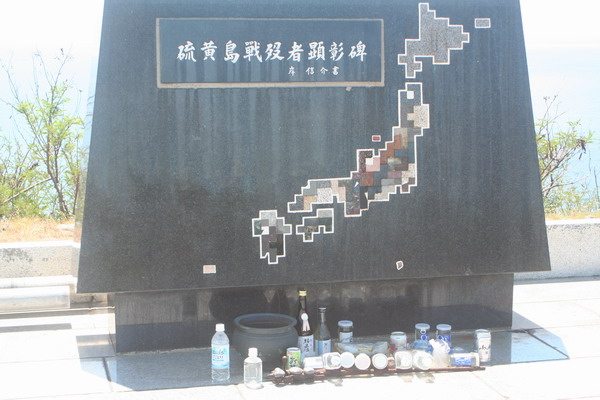
Yes, there are even some flowers there.
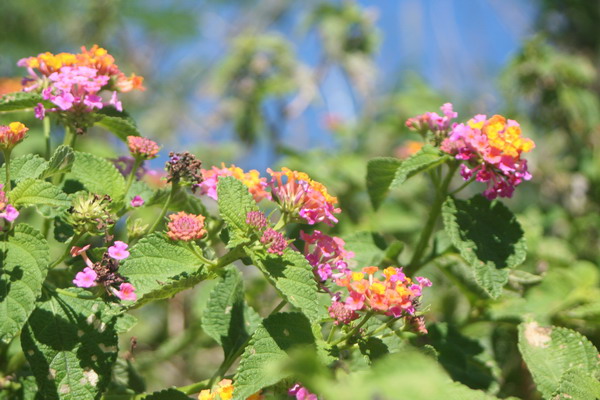
The group learning more about the history of the battle.
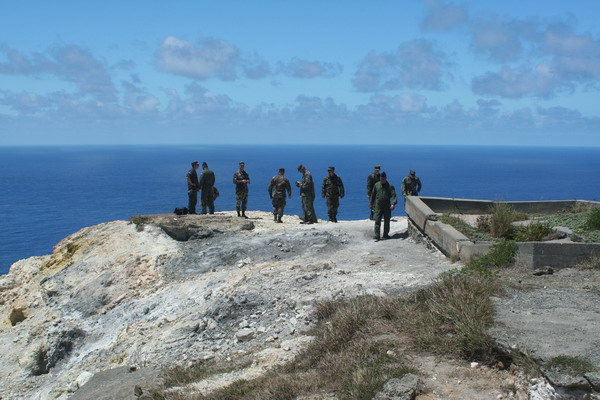
The volcano’s caldera.
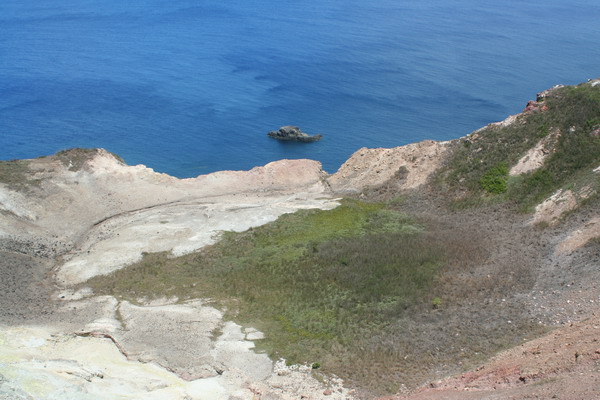
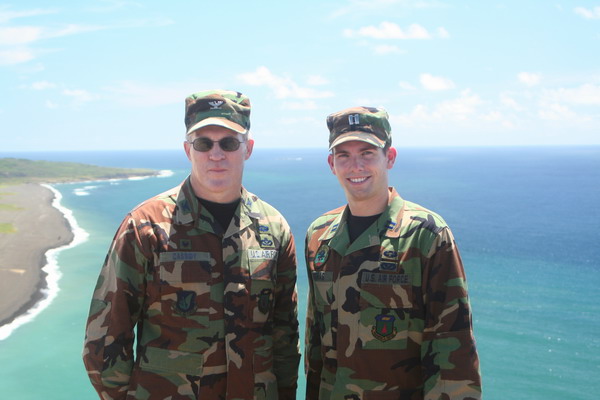
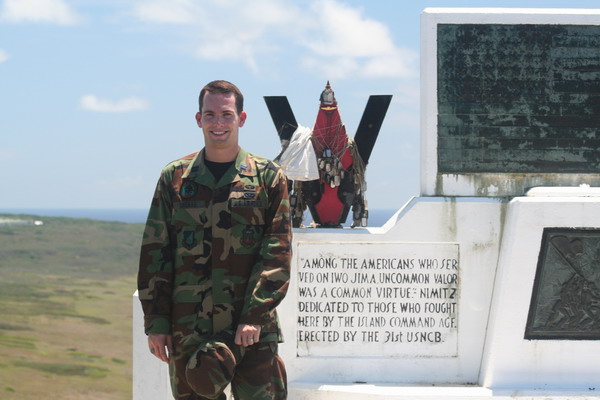
There are places where the wreckage from the invasion is still very visible. This is the alternate landing site for the invasion.
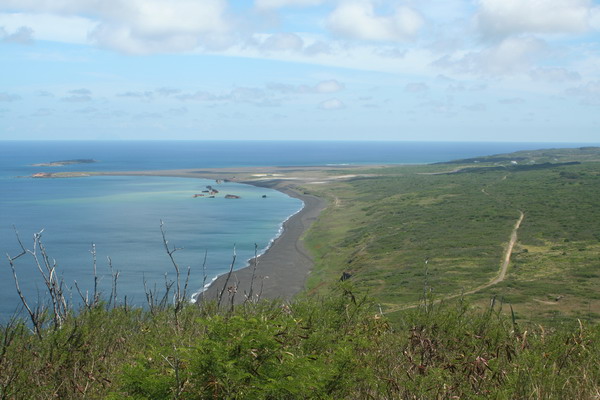
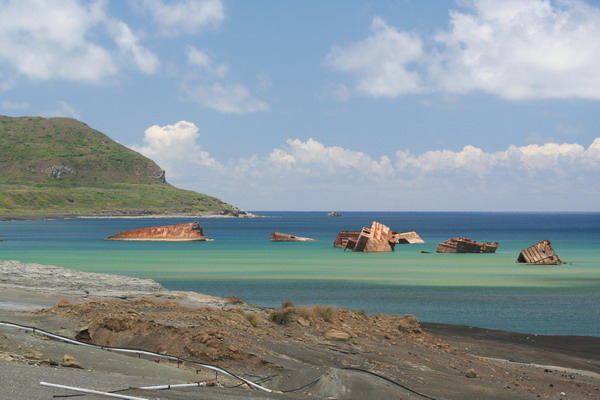
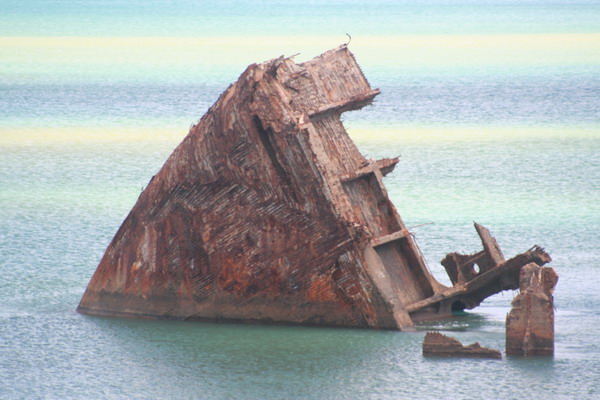
Before we left, I felt complelled to take this picture.
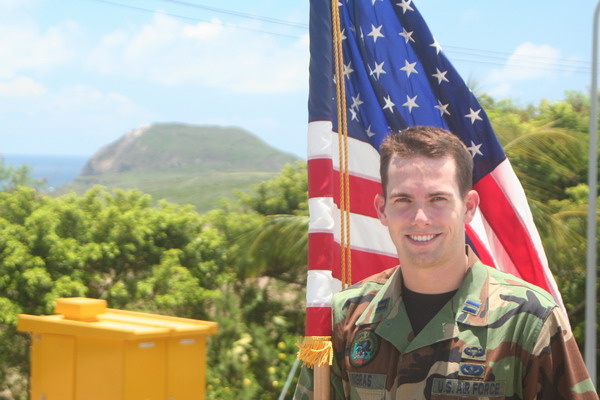
On our way back to Guam, we flew around the island twice and gave us a great perspective on the island we had just learned so much about.
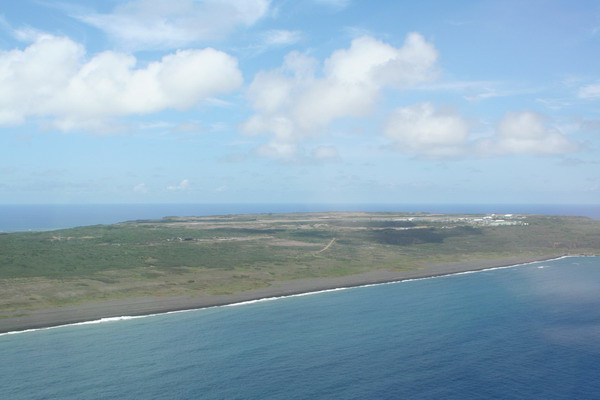
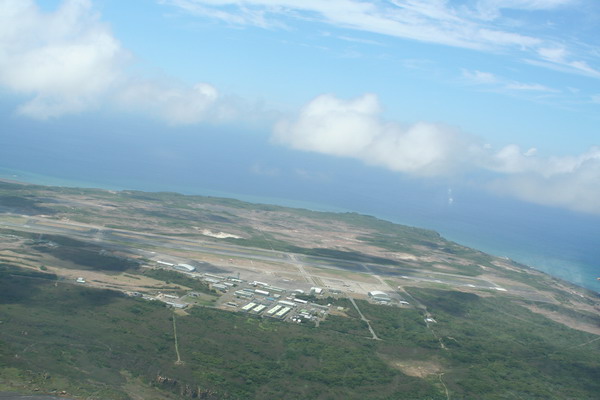
Mt Suribachi:
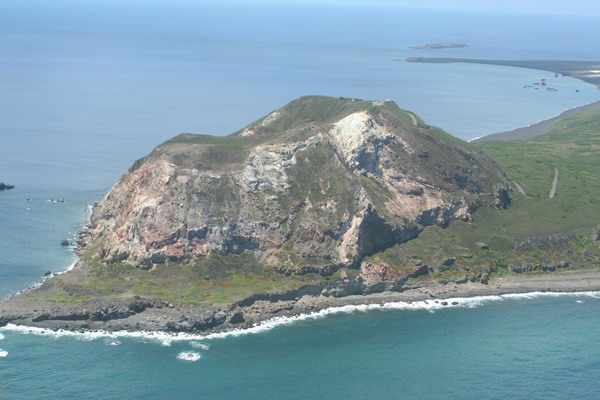
It’s one thing to read about Iwo Jima and its battle/implications. It is completely different to go and experience it for yourself. I can say this is one of the best pieces of my professional military education. I’m truly grateful for the opportunity to pay my respects to so many on both sides that gave the final measure of devotion.
–Jim
Iwo Jima: 61 years later (2006)–Part 1
***Please read the entry Iwo Jima: 1945 first***
Last week, I had the rare opportunity to visit a sleepy little island about halfway between Guam and Japan, called Iwo Jima. It was the site of a ferocious battle in World War II.
Here is how we got there and back, the venerable C-130 transport aircraft:
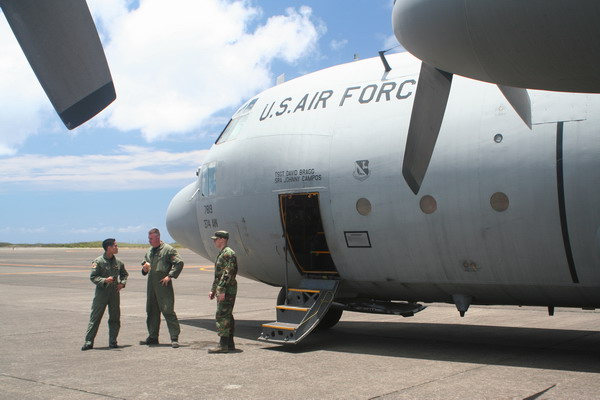
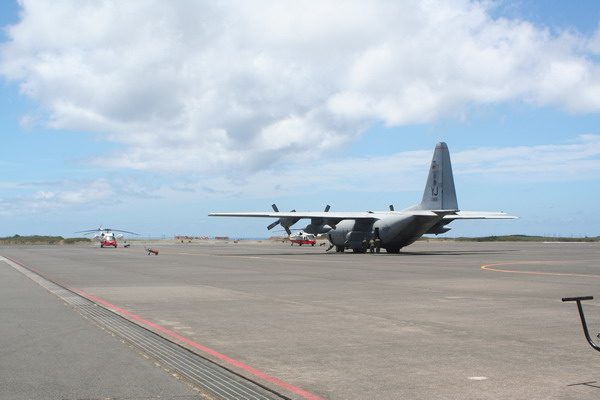
Here’s the inside. As you can see, it’s not quite as comfortable as a civilian airliner, and a whole lot louder. It sure can get into some remote places though!
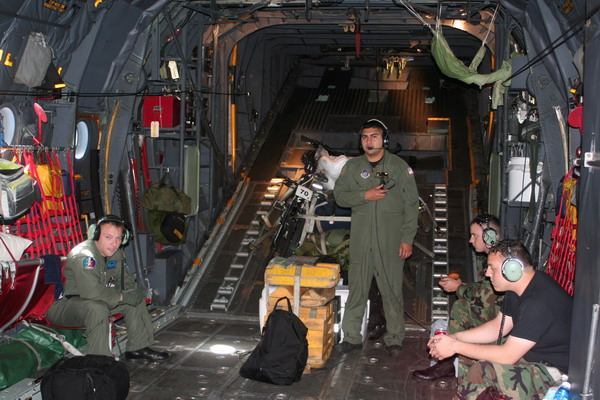
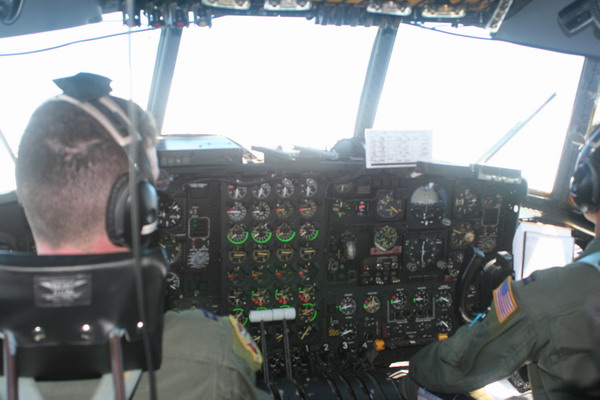
While we were only on the ground for a few hours, we were able to see much of the island by using a minibus to drive us around. About the only people on the island these days are the 200 or so Japanese Maritime Self-Defense Force. So, it is an interesting turn of fate that we had a Japanese and an American Marine (who flew out with us from Guam) to guide us through the historical significance of the island where so many people had died on just 6 decades before.
This is the dirt road that leads to the infamous Mt Suribachi.
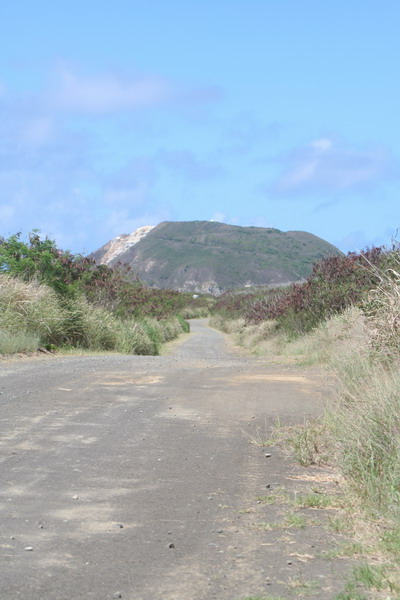
Here you can see on of the well entrenched bunkers that lined the shore where the Marines landed in February 1945.
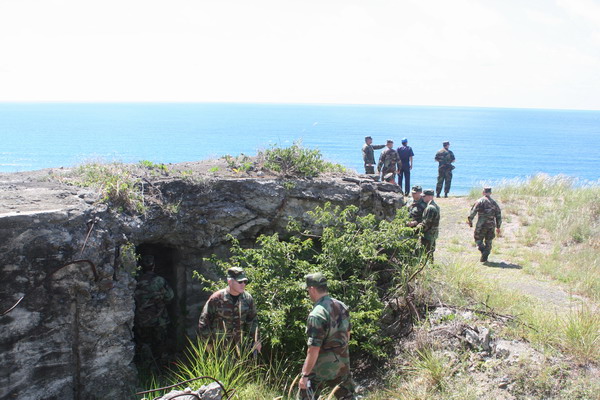
Here I am on the inside of that bunker (or pillbox).
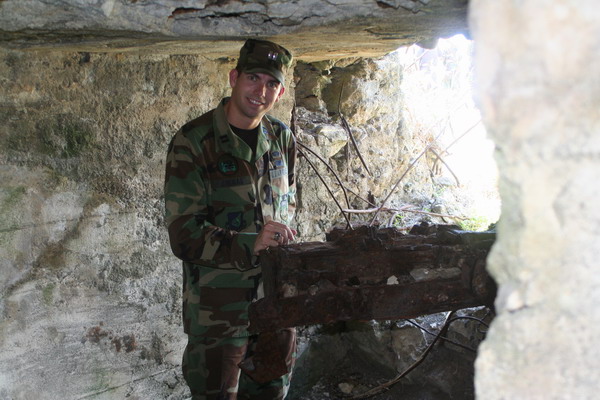
The Commander and Command Chief Master Sergeant.
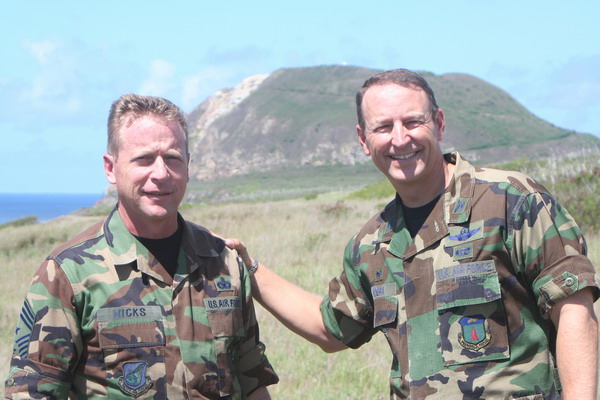
This is our group of Air Force people who attended.
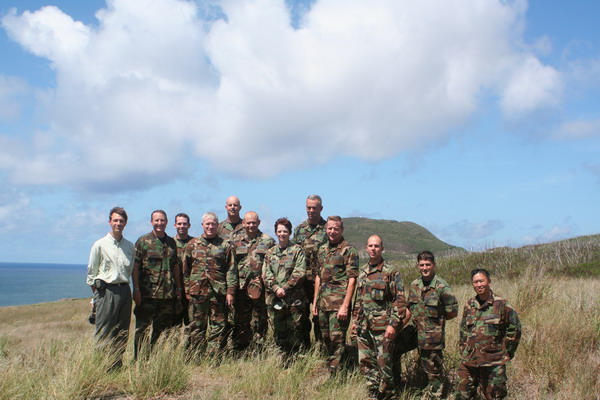
This monument is was dedicated when both Japanese and American soldiers met at this spot. This time it was under the banner of peace and friendship.
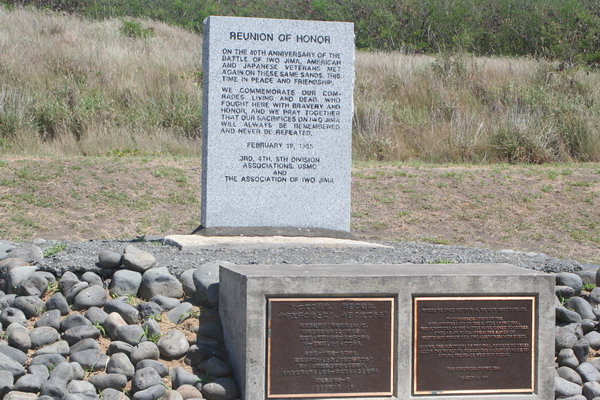
This map shows how the island looked during WWII and where the Marine units involved went. To orient you, Mt Suribachi is in the lower left hand corner (on the southernmost end of the island).
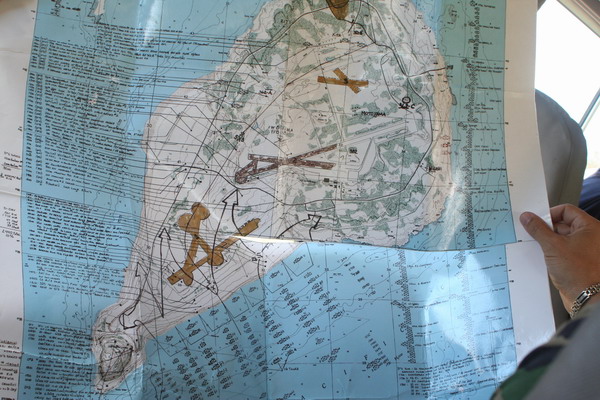
This is the invasion beach. You can see it’s a black volcanic beach. The sand is coarse and it’s very easy to imagine how hard it was to land all those men and equipment.
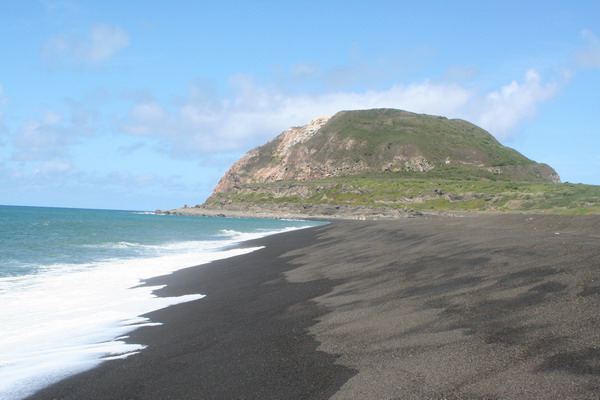
This rock marks the midway point on the beach and divided where the regiments came ashore.
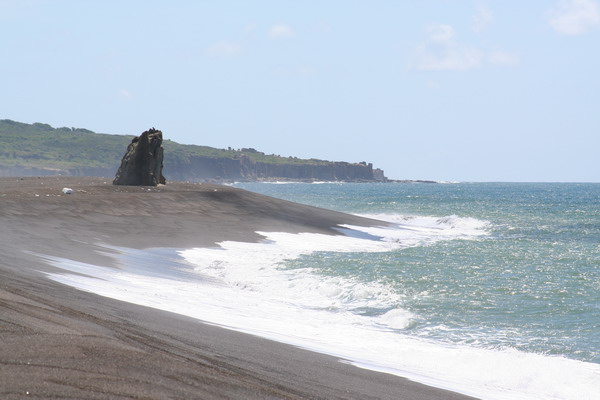
This is our Marine guide, Matt, recounting what happened 61 years ago.
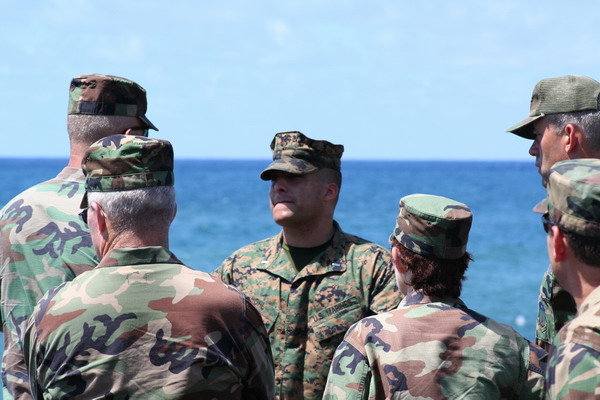
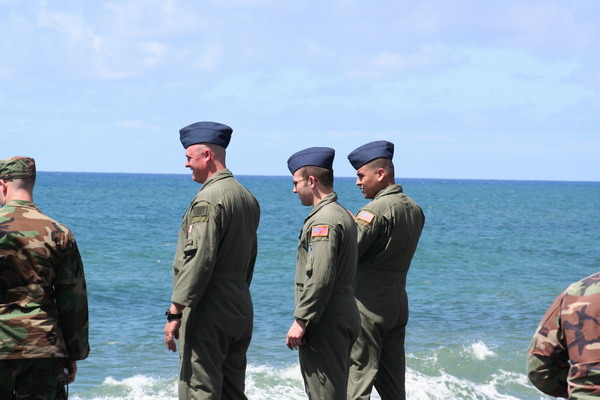
During the war, everything the Japanese defenders did was underground. This included their hospital. Almost a month after the island was declared captured, American forces discovered an underground field hospital. It contained 72 Japanese soldiers and medical personnel. 71 of them surrendered (one committeed suicide).
Here is the entrance to that hospital cave:
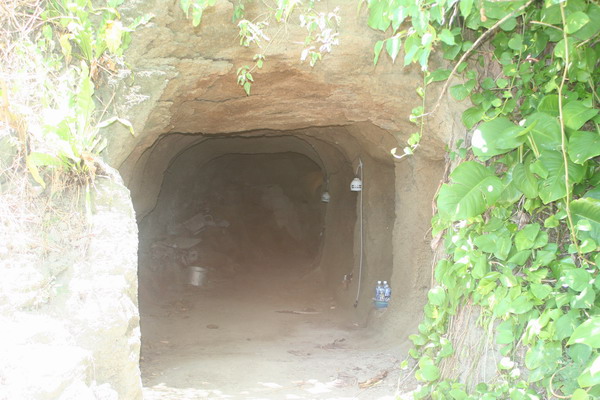
There were a number of artifacts that remained in the cave.
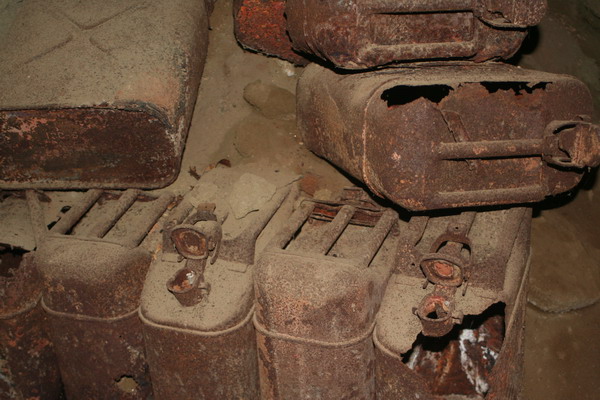
Inside the cave, there were a number of air vents that provided fresh air. That was especially important if one of the entrances were destroyed or blocked.
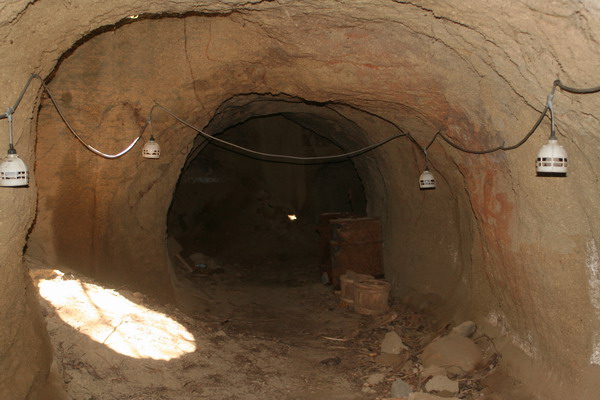
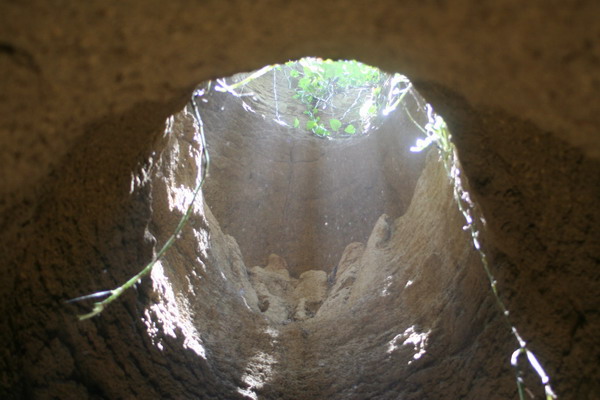
One aspect of the cave that the pictures don’t convey is just how hot it was inside. One would expect that it would be much cooler underground. However, since the island is an active volcano, going underground only brings you closer to the steam and magma. So, in places it was easily over 100 degrees. This picture shows the mass of hot air rising from the cave into the cooler air above and outside.
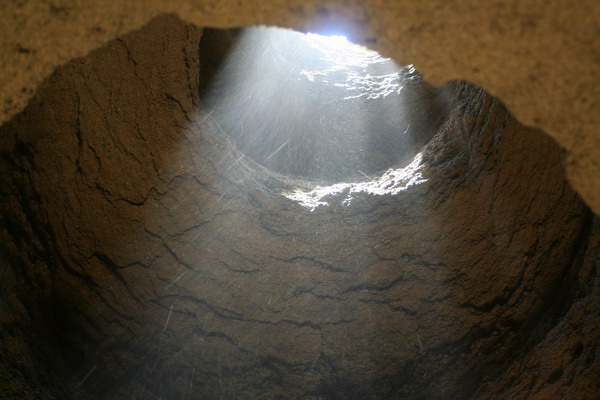
Nearby the hospital cave, there is a sandstone monument carved into the cliff. This carving of the famous flag raising on Mt Suribachi was done by Waldon Rich in July 1945 (only 5 months after the actual raising).
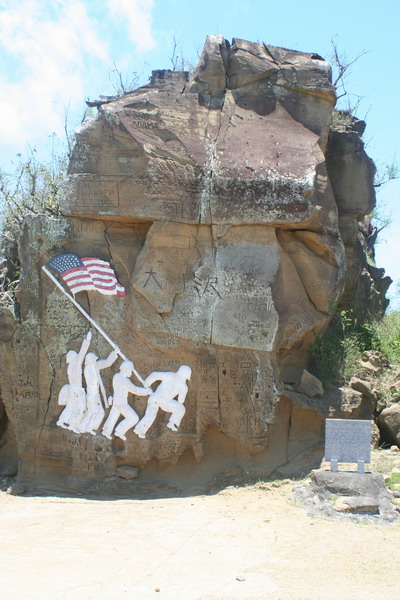
In the next part, I will include the pictures from the top of Mt Suribachi.
–Jim
